|
STONE HOUSES, MANSIONS AND OTHER
OLD HOUSES |
The old Harger limestone store, that stands sentinel at the junction of the old Military highway and the Perch River road where the drowsy little hamlet of Pamelia Four Corners slumbers, has a modest and almost bashful mien. Past its right-hand side the rustic Perch River road sweeps on and up a hill to create an intensely beautiful vista in summertime and perhaps in winter as well.
There was a time before the coming of the railroad when Pamelia Four Corners held out promise of becoming a thriving business and industrial center and the Hargers, the Contrymans and the Gouldings built fine houses there for themselves. The outstanding ones of these were constructed of native limestone, and the Hargers led all of the others in the building of limestone structures at this hamlet.
The old limestone tavern across the Military highway from this store is said to have been erected in 1824 or 1825 by Abraham M Harger. The store is believed to have been constructed about 1831 or 1832 by Charles G Harger who probably built the attractive little limestone house just beyond it towards Watertown about the same time, occupying it a number of years before he built the much larger and more pretentious one now the home of W E Rogers at the top of the hill and across the road from the beautiful white church with the graceful spire. It was on March 25 1831 that Charles G Harger of Pamelia, paid Noah N Harger of Martinsburg $1,000 for 31/2 acres of land at the intersection of the Military and Perch River roads and November 11 1824 this same site had been bought by Abraham M Hargar for $39.85 from the Merchants' Fire Insurance company of New York through James D LeRay.
Charles G Harger, who operated this stone store for several years, built a long wooden addition on its left side and there conducted an extensive meat-packing business for a quarter of a century shipping his products by schooner from Sackets Harbor to Montreal and up the lakes. When the railroad came through the North Country in the 1850's he had hopes that Pamelia Four Corners would be on its line. But it was by-passed and September 1 1859 he sold his big limestone mansion and business to Walter Fox who continued the store. On October 10 1866 Fox sold the property to Jacob H Markell of St. Johnsville. Markell kept it until March 26 1881 when he disposed of it to Alexander Countryman. It was held in the Countryman or Contryman family for a number of years, but November 25 1903 was sold by William and Ella Contryman to Sam Ray of this city. April 13 1920 and June 17 1921 James T Savage of Pamelia Four Corners purchased the property in two parcels from Mrs Rebecca Ray, widow of Sam Ray, and from the Ray estate.
Mr Savage is the present owner of the property and the little general store, which occupies the ground floor of the little stone building, is conducted by Howard Cranley, while the second floor of the building is done off into an apartment. Window boxes of flowers usually decorate the place in the summer and hollyhocks line the wall on the side of the Perch River road, which continues its picturesque way over the hill. In still earlier years the store had been conducted by the late W H Miller, Alanson E Gove and others
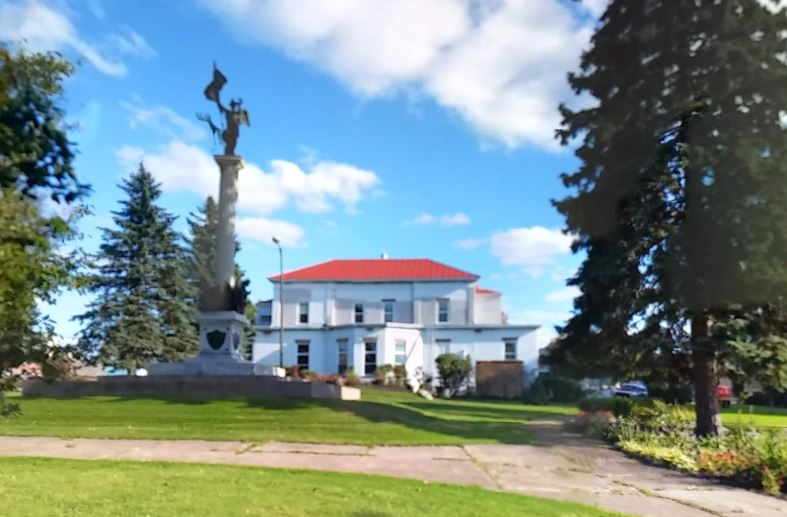
Joseph Rosseel, born in Ghent, Belgium, June 2 1782 came to the United States at the age of 25 to avoid Napoleonic conscription, arrived in Baltimore in August 1807 spent a year in Philadelphia, Pennsylvania, and thereafter became one of the historic figures of the North Country. Bearing a letter of introduction from Hope & Company, Amsterdam, Holland, bankers, young Rosseel was naturally brought in early contact with David Parish, American representative of that company in Philadelphia
Having purchased 72,000 acres at $1.50 an acre in the Ogdensburg area of St. Lawrence county in 1808 the wealthy David Parish nourished a yen to establish a fine estate here in the European manner. He, therefore, made young Rosseel his agent with instructions to explore his North Country tract and locate a suitable site for his manor house. This Rosseel did in 1808 and went to Montreal early in 1809 to hire 40 Canadian laborers to begin the nucleus for the present city of Ogdensburg. Under his direction as head of J Rosseel & Company, which had been formed in the fall of 1808 with Parish capital, the fine Parish residence, which now stands as the Remington Memorial at the corner of Washington and State Streets in Ogdensburg to house and display paintings and bronzes by the late Frederic Remington, was begun in 1810.
To facilitate rapid development of the infant community Rosseel & Co after its organization in 1808 had brought $40,000 worth of merchandise into a temporary store and thereafter Rosseel's activities in behalf of the Parish family were varied and extensive over a period of 50 years. David Parish died intestate in 1826 and in 1827 his estate was bid in by Joseph Rosseel for Richard Parish, brother of the deceased, who in turn conveyed it to another brother, George Parish who became the laird of the manor.
At a time, long since forgotten, but said to have been well over a century ago, the Parishes built a house for Rosseel almost directly across Washington Street from the Parish residence. After the retirement of Joseph Rosseel as the Parish agent he was succeeded by his son, John F Rosseel who was born in Ogdensburg in 1821 and, to him and his wife, the former Miss Lydia S Raymond of Potsdam, there was born a son, Frank Raymond Rosseel in 1860 who late in life became an accomplished marine artist and lived in the Rosseel house from 1870 to January 1882 when he left Ogdensburg. The Rosseel house passed out of the Rosseel family eventually. The new owners became tired of it and in 1886 the old house was razed, but the original foundations were left standing.
Prior to his death June 24 1919 former Mayor George Hall and Jonathan Childs Howard, public spirited citizens of Ogdensburg who had amassed fortunes of approximately a million dollars each out of the coal trade, conceived the idea of a fine public library for Ogdensburg on the site of the Rosseel mansion and agreed to give $50,000 each towards it. The proposition was submitted to the Ogdensburg common council in late December 1920 by the late George F Darrow as president of the library board and May 12 1921 that board was granted permission to construct the proposed library.
Sketching the appearance of the Joseph Rosseel house as well and accurately as he could from memory, Frank R Rosseel made possible the present Ogdensburg Public Library building, shown above, of stone and stucco which arose from those original foundations to be thrown open to the public about October 1 1922.
With central pillared portico, the grey structure of beautiful Colonial type is today a memorial not only to the pioneer Joseph Rosseel but to Mayor Hall and Jonathan C Howard. To the public spirit of the latter two is also the Remington Memorial, which not only domiciled three of the Parishes and the beautiful Mme. Helena Ameriga Vespucci immortalized in Dr Walter Guest Kellog's novel, "Parish's Fancy," but for a number of years was the residence of Mayor Hall himself.
Hill St
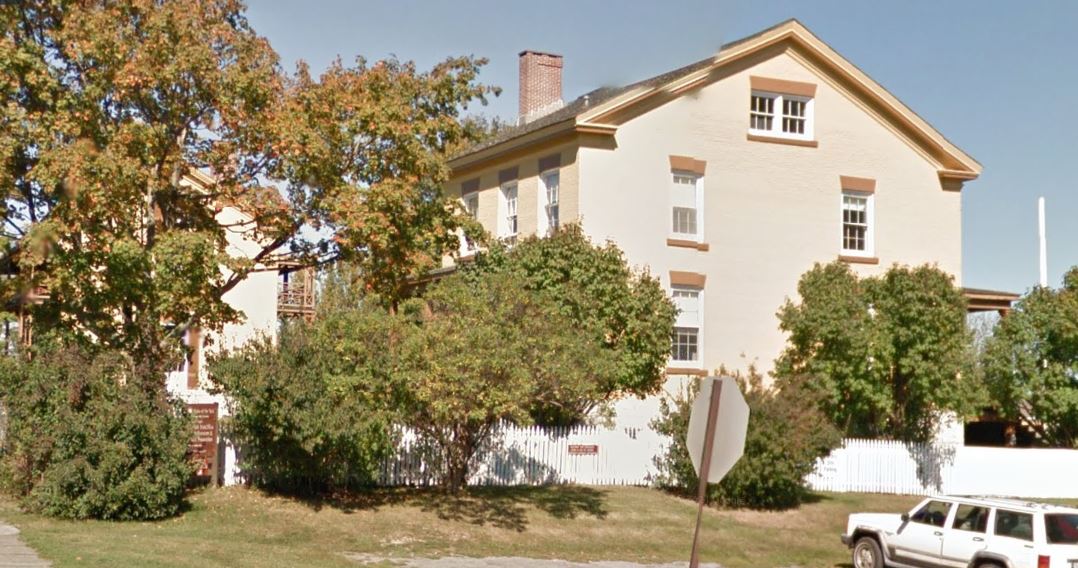
Absence of any definitive statement in the county histories has led to the general opinion that Navy Point and the naval station at Sackets Harbor has been federal property since the period of the War of 1812. The records in the county clerk's office show, however, that the United States did not acquire Navy Point and the military establishment known as Fort Tompkins until February 18 1847.
On that date the property, which extended to the north border of Main Street opposite the battlefield, was purchased from James E DeKay, Charles P Clinch and Francis R Tillon, executors of Henry Eckford, the great shipbuilder who created Commodore Isaac Chauncey's Lake Ontario fleet of United States war vessels on this same Navy Point. For the property the United States of America paid the Eckford estate $2,500.
It appears that Eckford had purchased the property from Commodore Chauncey himself. Here the record is slightly confusing as one deed from Chauncey to Eckford transfers half of this property July 1 1815 for $1,596.87 and the other seems to transfer the whole property from Chauncey to Eckford April 25 1823 for $3,000. At any rate it was private property all of the time that it was being used as a naval depot during the War of 1812 and all of the time that the Lake Ontario fleet was being constructed there. A portion of that time it was under lease to the government from the owners prior to Chauncey.
The naval station was first set up on the site November 9 1810 when Lieutenant Melanchton T Woolsey brought the brig Oneida there from Oswego. On November 8 1811 he wrote the navy department that the village proprietors had offered the point and two acres of land for $3,000 and advised buying, but nothing was done about it.
He told the department he was building a combined boathouse and mess room, had built a guard room and November 15 1811 asked for a marine guard to prevent desertions. Chauncey was given naval command of the Great Lakes September 1 1812 and arrived at Sackets in October. The ensuing November 30 he advised the navy department the site could be bought from Mr Camp for $3,000. He thought the price high and suggested investigating other harbors, which seems not to have been done. Meantime he agreed to rent the property for $200 a year with right to remove the buildings. On February 5 1813 he reported two blockhouses nearly complete and eight guns ready to mount. On December 24 1813 he reported Master Commandant William N Crane would be in charge when he left and January 11 1814 Crane wrote that Camp was threatening to sue for the cutting of timber to be used in building Fort Chauncey at the crossroads. On February 1 1814 Crane reported Fort Tompkins practically complete and blockhouse armament increased.
About that time Commodore Chauncey purchased the property of about 3 1/2 acres of land. Not until after United States government purchase in 1847 were the two brick residences constructed on Main Street, the larger one or commandant's quarters having been erected that year and the smaller one shown herewith having been built in 1848. This latter was first used as the residence of the captain of the yard. It is soon to be converted into a club for enlisted men under directions of Lieutenant Commander Allen H Harris of the Watertown unit, U S Naval Reserve, which occupies the whole station site under lease which has been vested in New York state since April 1 1920.
1915 Postcard
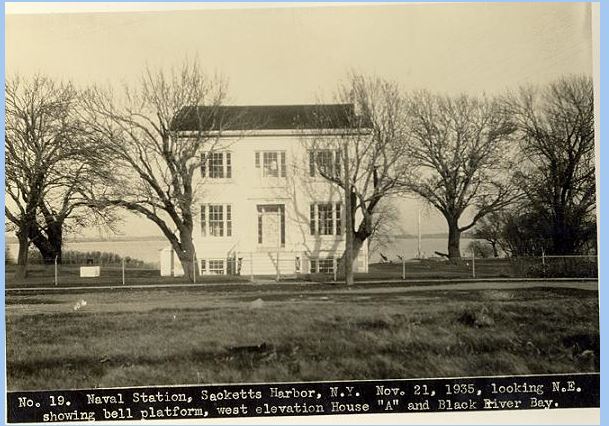
Consisting of approximately three and one-half acres Navy Point and the military establishment Fort Tompkins, plus the adjoining land in Main Street, Sackets Harbor, was long considered the smallest naval base in the world. There Henry Eckford, the shipbuilder, created the United States fleet for Lake Ontario for the War of 1812 and at the same time made his fortune. It was there also that this fleet was based and Commodore Isaac Chauncey had his headquarters.
All during the war this property was under the private ownership of the group of New Yorkers including Cornelius Ray, William Bayard and Michael Hogan who, on March 25 1809 had paid $30,000 to Augustus Sacket, founder of Sackets Harbor, and his wife, Minerva, for the 1,700 remaining acres at and adjacent to Sackets Harbor in the town of Hounsfield. On July 12 1811 the proprietors of Sackets Harbor named Thomas Ludlow Ogden of New York their trustee and throughout the war the federal government paid a rental of $200 a year for the use of this naval base.
Although a treaty of peace terminating the war was signed at Ghent December 24 1814 nothing about it was known on this side of the Atlantic until the U S Sloop of War Favorite docked at New York February 11 1815.
On December 28 1814 four days after the treaty was signed, Commodore Chauncey privately purchased this property for $3,000. On April 25 1823 he sold it to Henry Eckford, whose estate conveyed it to the United States February 18 1847. That same year the dignified brick house shown above was built on Main Street as the commandant's residence, but now is the officers' club of the Watertown Naval Reserve, which utilizies this naval base.
Immeditaely after the War of 1812 Lieutenant Thomas Brownell, who had fought
on Erie under the famed Commode Oliver Hazard Perry, was put in command
of the Sackets Harbor naval base only then permanently established. Succeeding
commandants were Captain Charles T Pratt, Captain George Sawyer, Captain James
Mcintosh, Captain George N Hollins, Captain Josiah Tatnall, Commodore E A
F Lavelette, Commodore Theodoras Bailey, Commodore J B Montgomery who
became a rear admiral while at the station, Commodore Francis B Ellison,
Commodore J P McKinstry, Captain Alexander C Rhind, Albert H Metcalf
and finally for 19 years by his widow, the only woman to hold such a position.
Actually she was only a caretaker as it ceased to be a naval base in the
early 1870s.
Captain Hollins and Tatnall later became prominent in the service of the Confederacy, Commodore Tatnall having been in command of the Confederate fleet when the ironclad Merrimac was sunk by the cheesebox Monitor. Tatnall, a Georgian, had a distinguished Navy record. He was on the Constellation in the War of 1812 was with Decatur in Algeria, with Perry off the African coast, with Porter in the Gulf of Mexico, commanded the East Indian squadron in 1858 and brought the first Japanese Ambassadors to this country in 1860. That year he became commandant at Sackets Harbor and in 1861 resigned to join the Secessionists. The navy department recommended selling the station in 1910 but it was not done. In 1915 the Naval Militia took over under Lieutenant Harrison J Angley, who was succeeded in 1929 by Lieutenant Roswall F Taylor. Wesley Keiler in 1931 succeeded Lieutenant Taylor for six months and in 1932 Lieutenant Homer M Rice took command. Last October Lieutenant Commander Allen H Harris, who served five years with distinction in the Navy, assumed command and is now busy reorganizing and rejuvenating the station, which last year got the YMS-311 largest training ship the Watertown Naval Reserve unit has ever had.
These current photos were taken from "oldhouses.com" and is FOR SALE BY OWNER:
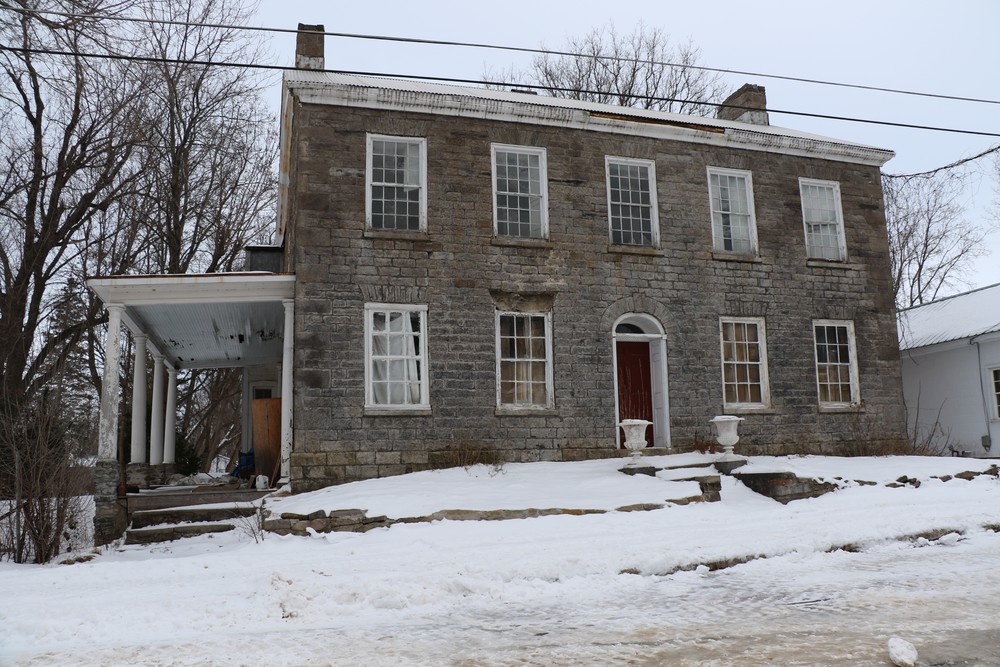
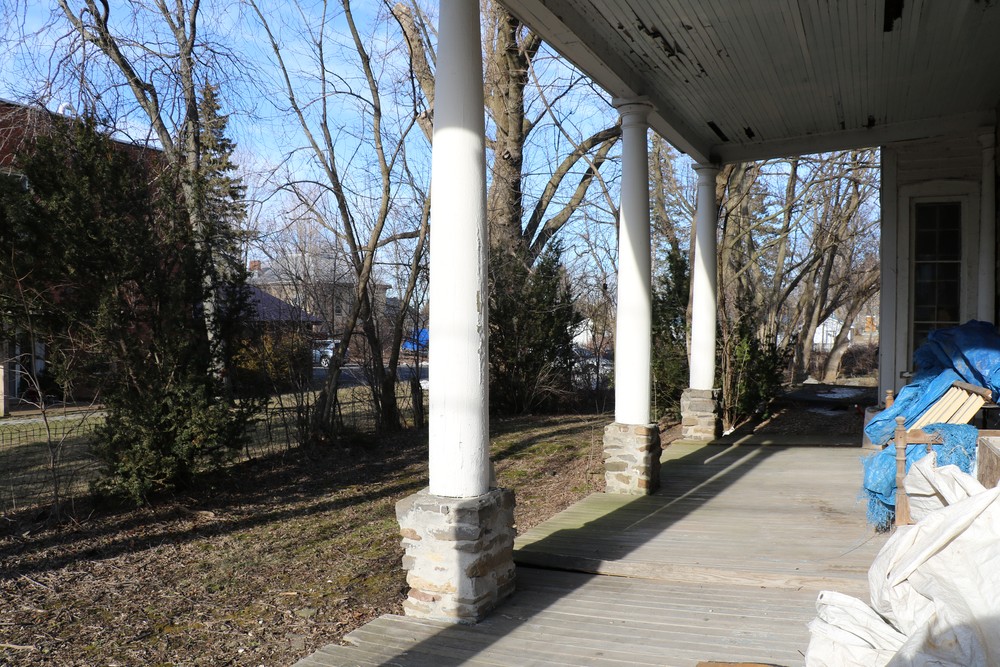
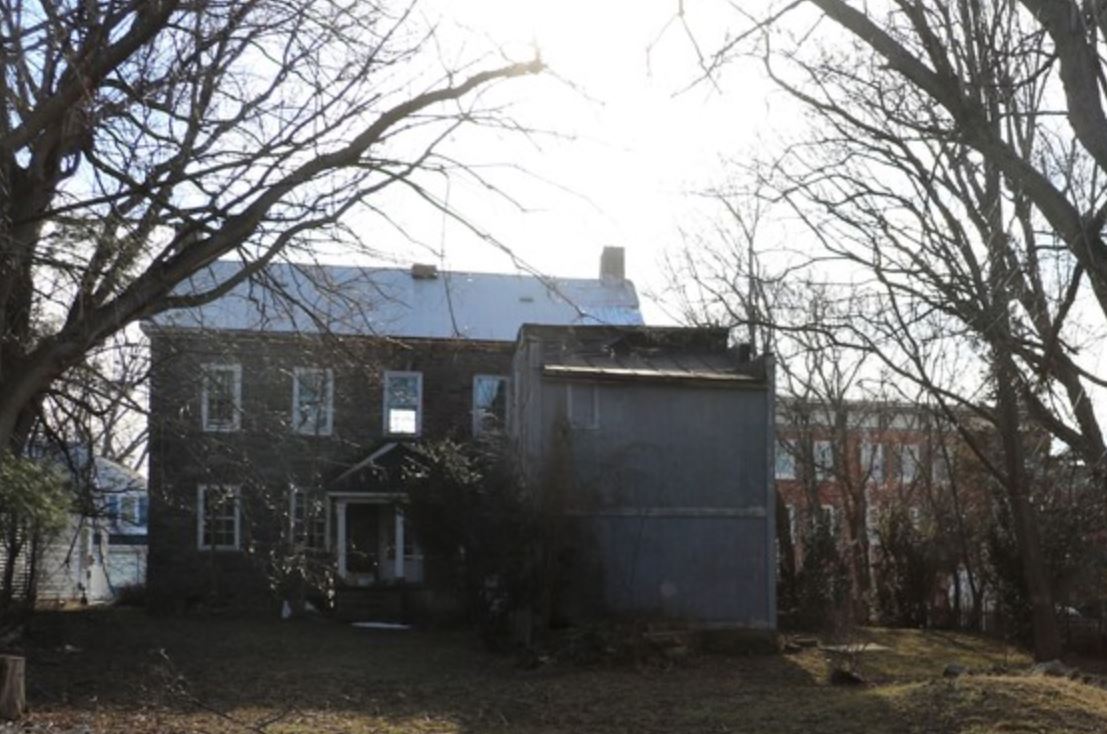
With its tradition of the nationally important metropolitan Ogden family of a century and a half ago the village of Waddington, St. Lawrence county, is not only one of the most richly historic but is one of the oldest and most beautiful on the American side of the St. Lawrence river. There today, in this community of about 700 persons, stands the fine old limestone St. Paul's Episcopal church which the Ogdens were instrumental in having built in 1818 on LaGrasse Street as a model of old St. Paul's in New York City.
And there also are several fine old limestone houses built in the Georgian manner, of which one of the most attractive is this Walter Wilson house said to have been built by him in 1831. It also stands on the same side of LaGrasse street as the church, but is just above the Waddington bank in the heart of the business district. It is owned and occupied by Mrs Margaret T Brown, whose son, Charles M Brown, is the cashier of the Waddington bank and resides with her. It consists of eight spacious rooms, has a fine central hall and staircase and originally had a fireplace for each room, three of these fireplaces remaining. Built upon a terrace close to the street sidewalk with a huge elm growing close to its front wall it is as staunch and square as the day it was completed. Its facade is beautiful with its attractive arched doorway and the original twelve-paned windows.
On June 2 1823 Joshua Waddington, the New Yorker brother-in-law of David A and Thomas Ludlow Ogden, for whom the village and town were named, conveyed the site to Duncan Turner and on August 11 1835 Walter Wilson, first owner and occupant of the house, took title to the lot. Wilson, a prominent early Waddington merchant, died in 1873.
First called Hamilton after Alexander Hamilton, law associate of David A and Thomas Ludlow Ogden, the name of the village was changed to Waddington on March 3 1818 but the town of Waddington was not set off from the town of Madrid by legislative act until November 22 1859 and in 1803 Joshua Waddington took a third interest in the entire Madrid town.
Walter Wilson was supervisor of Madrid in 1839 and when Waddington town was set off he became its first supervisor serving from 1860 to 1864. In 1839 1849 and 1867 he served as president or mayor of the village, the village having been incorporated in 1839 when he first was president. There business of the town of Madrid centered from the time the first dozen families established there in 1798. Walter Wilson died a wealthy man willing $10,000 to the Waddington Presbyterian church, which fund is still intact, its income being applied to the minister's salary.
On November 18 1873 title to the house passed by Wilson's will to his widow, Ann, and from her to Belle W Edsall December 1 1874. By executor's deed it was conveyed by Belle W Edsall Spencer's estate to Harriet W Leishman September 20 1904. From her by will it Went to Charlotte T Elliott September 10 1929. On September 16 1930 she deeded it to Wallace T Brown and wife, Margaret T Brown, the latter of whom became the owner upon the death of her husband in June 1937. The former Margaret T O'Brien, she married Mr Brown January 9 1907 and is the mother of Charles M Brown and Mrs Catherine E Roach of Poughkeepsie.
Born upon a Waddington farm Wallace T Brown attended Waddington schools. Eventually he moved into the village, worked in the Daniels pharmacy from 1902 to 1916 established a grocery which he operated until October 6 1917 bought the John Short general store in the Clark Hotel block, purchased the block in 1919 and operated the store until his death. He was active in town and village affairs and was town tax collector about 15 years.
LISTED AS FOR SALE at oldhouses.com:
Greystone is a prime example of classical Georgian architecture in need of stabilization and complete renovation. It has eight spacious rooms, fine central hall and pencil post staircase. It originally had a fire place for each room, four of these remain. Its classical early Georgian façade features arched doorway and 12 over 12 paned windows. Other early Georgian features include remnants of cooking fire place in summer kitchen, interior wind doors (shutters) and narrow arched doorway. Deep paneled windows are also typical of the period. Three pocket doors were added in the 1870s.
The house has a St. Lawrence River view from its Pillared North Porch. It is located in the center of the village on a large lot located half a block from the waterfront which is meticulously maintained by the village with public waterfront access and park facilities. The village dock is at the foot of the hill and private dockage is available to residents along the groomed waterfront trails for about $100 per year. The fishing in Waddington is great, it was the site of the 2015 BassMaster National Tournament. The home has a view of Ontario and is a 20 minute ride in either direction to Bridge crossings at Prescott (Johnstown) or Cornwall, Ontario. It is located less than 100 miles from both Ottawa and Montreal.
This was the home of Walter Wilson first president of the village. It was reported to have the first gravity fed 2nd floor two holer (outhouse) in St. Lawrence county. Some special features include beautiful original hardwood floors, original wind doors,stained glass windows built in window drawers.
25479 NY-283 (Pearl St)
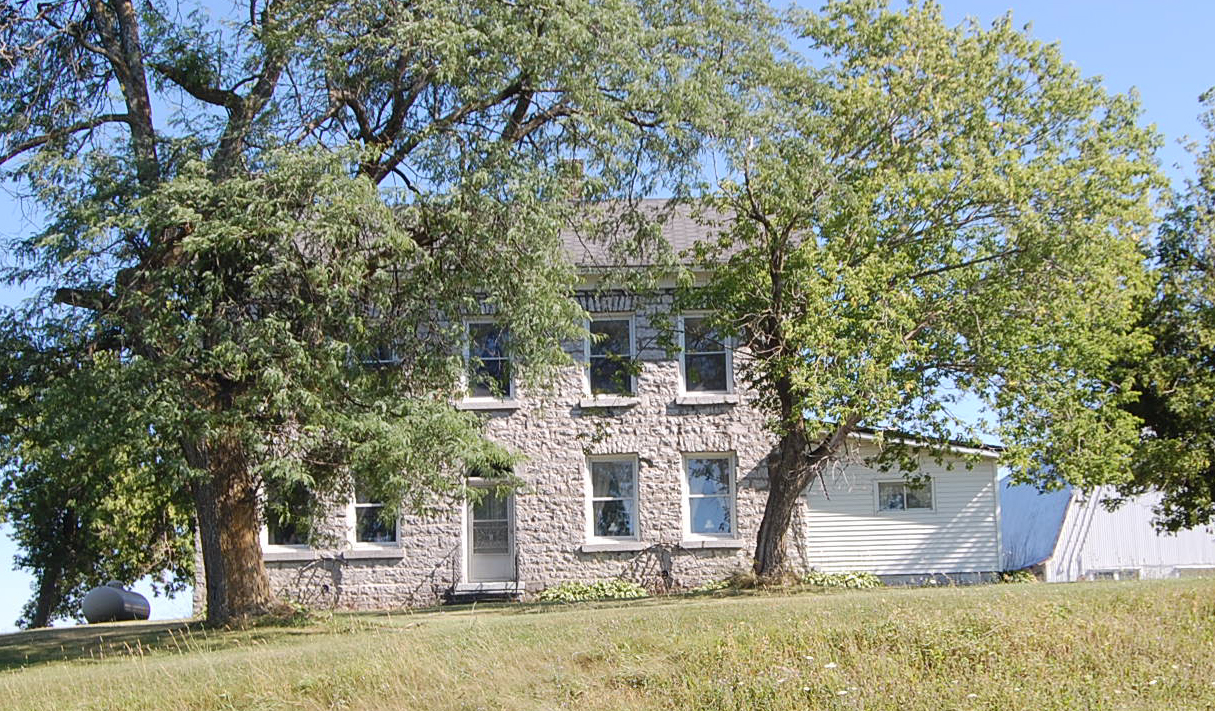
This fine old native limestone house about three miles outside of the city on the Pearl Street road has stubbornly resisted all efforts to trace its origin in the available time. It was acquired by Loveland Paddock, one of Watertown's foremost early citizens, probably about a century ago as an investment, as there is nothing to indicate that he ever resided there.
The first definite record of his ownership of this property, which lies in the town of Pamelia with some acres spreading over into LeRay , is a deed dated November 26 1855 from him and his wife, Sophia A Paddock to Medad Cook of the town of Brownville, for a consideration of $10,927.
That Cook retained it but a short time is shown by a conveyance of the same property by him and his wife, Roxana, to Maria A Woodruff, wife of Horace W Woodruff, also of the town of Pamelia, for a price of $18,200. On August 29 1870 Mrs Woodruff, then a resident of St. Louis, Missouri, disposed of the place to Henry Putnam of Rockford, Illinois, for $16,245 he giving her back a mortgage for $10,484. Apparently the transaction was not a paying venture for Putnam, as on February 3 1888 Mrs Woodruff had to foreclose and bid the property in at mortgage sale conducted by Edgar C Emerson as referee in her action against Putnam's estate represented by Keziah and Elisha W Putnam as administrators of Henry Putnam, Keziah and Elisha, W Putnam, Henry P Putnam, M Jennie Putnam and Henry O McVee. Mrs Woodruff's bid was $11,000. Through her son, Lloyd O Woodruff, as her attorney she then sold the place on December 19 1888 to Albert V Mayhew and wife, Annette.
Mr Mayhew and his family, which included his son, Fred W Mayhew, moved
onto the farm and resided there for several years. In fact Edwin B Mayhew,
a son of Fred W Mayhew, was born on this farm, and his elder brother,
Valier Mayhew, came there as a young boy. Eventually all of the Mayhews
moved into this city to reside, but not until after Fred W Mayhew had
been supervisor of the town of Pamelia for eight years from 1898 and the
latter part of that service was as chairman of the board. Then for approximately
ten years he was county treasurer and later city treasurer of Watertown.
His son, Valier, a resident of Great Bend, is a civil engineer long in
the service of the state highway department, while his other son, Edwin
B Mayhew, has had many years of experience
in this city as a banker and as an investment house manager.
Albert V Mayhew died September 17 1923 willing this farm to his grandson, Valier, who continues to own it and its approximately 275 acres. For 19 years of that time the tenants have been Mr and Mrs Horace A Burnup. Loveland Paddock, one of the early owners of this farm, will be recalled as the builder of the Paddock arcade in 1850 following the great fire of 1849. He was one of the earliest merchants and was one of the founders of the Bank of Watertown January 26 1839.
Horace W Woodruff, son of Norris M Woodruff, builder of the Woodruff House, was born here February 12 1819 owned and operated a foundry and machine shop near the north end of the Mill Street bridge and died in Brooklyn October 12 1891. His wife, Maria Ann Osgood Woodruff, born here June 6 1816 died in St. Louis December 29 1890 two years after she disposed of the old stone house and farm on the Pearl Street road.
DAVID LANE ADDENDUM NOTE TO THIS ARTICLE
Through inadvertence the name of Mrs Leo W (Jennie Mayhew) Bowker, New York City, was omitted from last week's caption, she having also been born in the house on the Pearl Street road where her father, Fred W Mayhew, and grandfather, Albert V Mayhew, lived for some time.
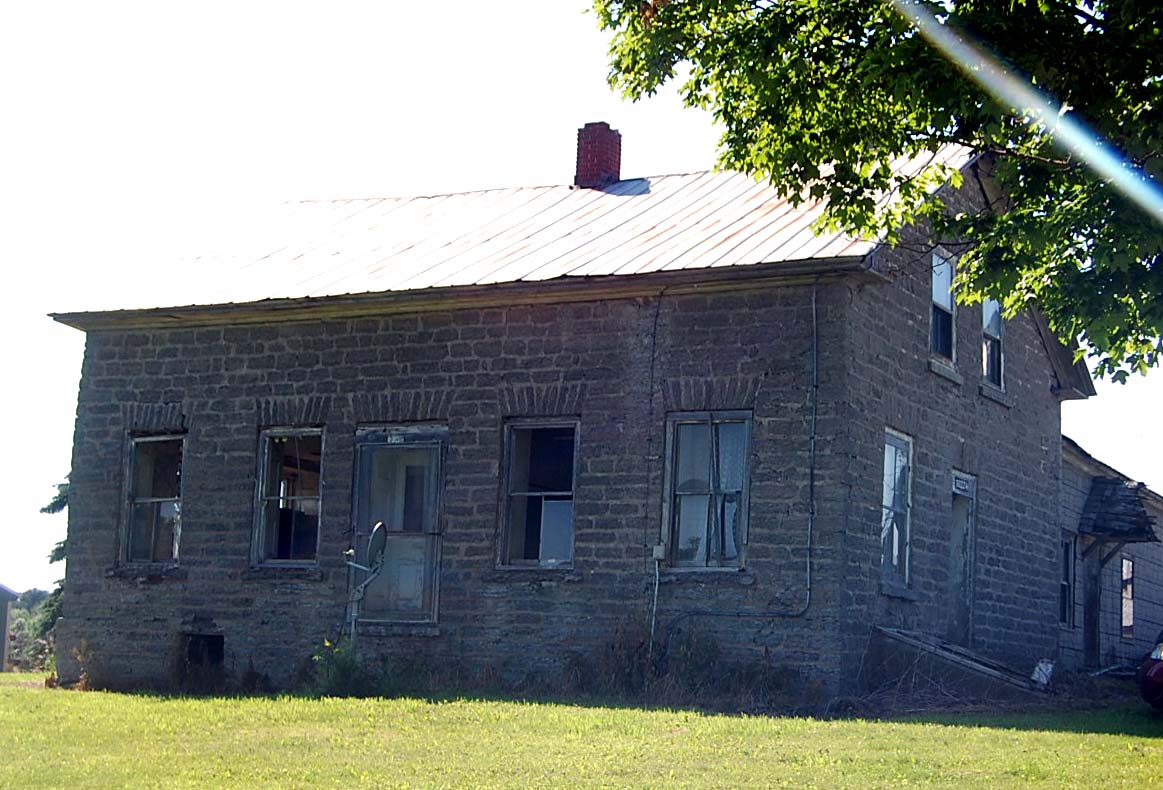
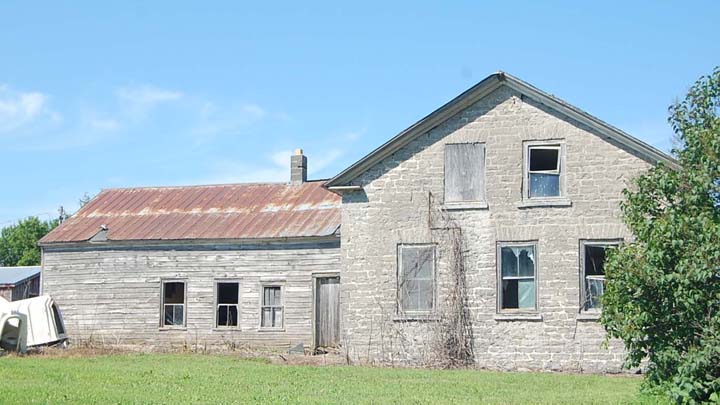
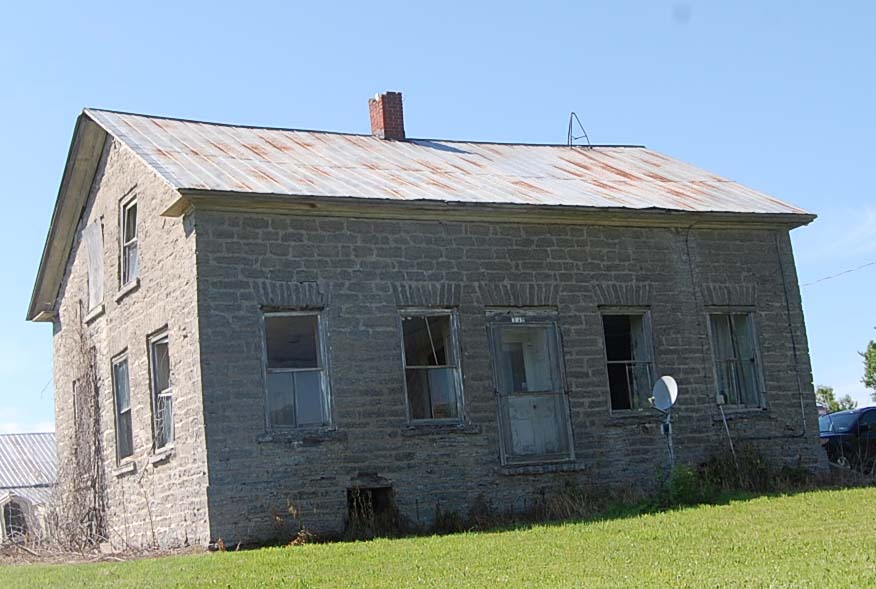
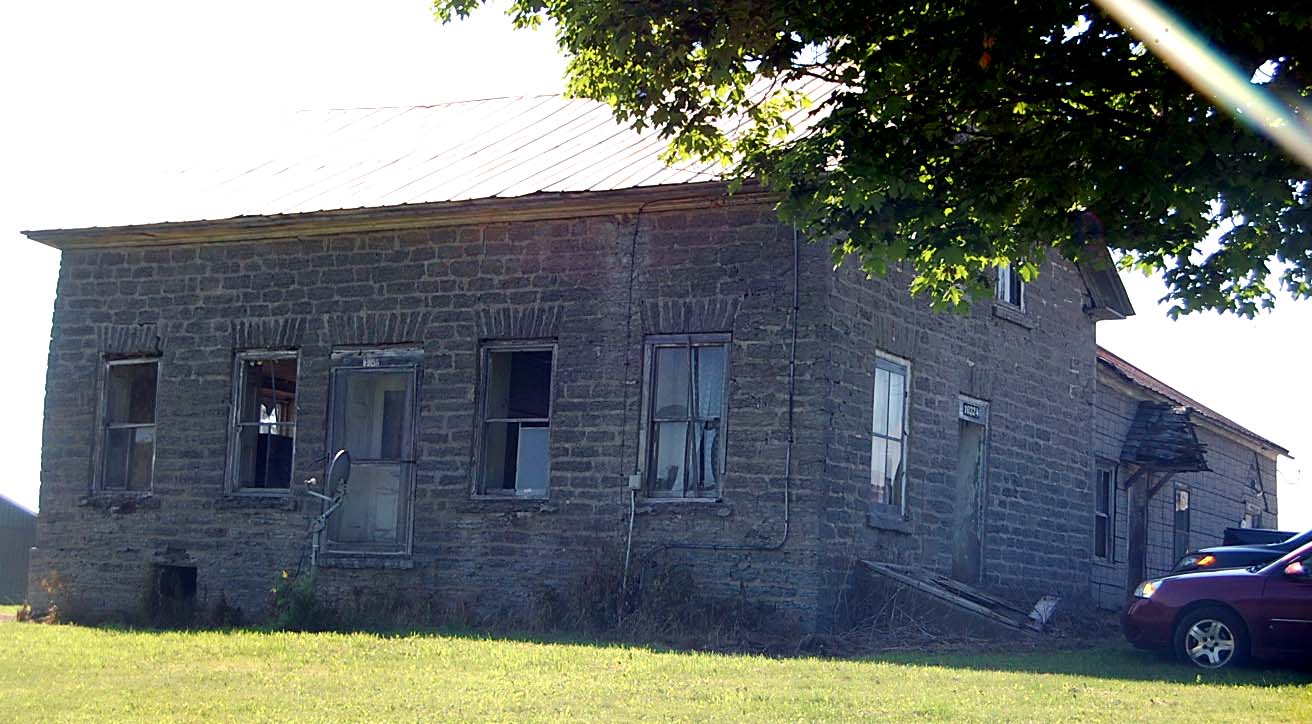
Located about two miles below the village of Ellisburg is this old native limestone house of cottage type which has all of the earmarks of early construction. It was built as early as 1827 and possibly before that on a 136-acre farm, which has one boundary through the center of the north branch of Big Sandy creek and another on the east line of the historic Bowne & Eddy 3,000-acre tract. If constructed in 1826 or 1827 it was built by Chester McLean, a native of Steuben county who at nine came into Ellisburg about 1807 to live with Joseph McKee, for whom was named McKee's Landing. In 1824 McLean married Lucinda, daughter of Ezra and Polly Frazier Stearns, and for several years was a sailor on the Great Lakes. He died in January 1875 and his children included Electa M Cronkhite and Ezra S McLean of Batavia, Illinois and William C McLean of Ellison.
On March 29 1826 Ruth and Chauncey Howard, Daniel and Harriet Howard, Heman and Linus G Howard sold 90 acres, the principal portion of this farm, to Chester McLean for $1,000 and the price would indicate that the house might have been there at that time, in which case it was probably erected some time before by a member of the Howard family. Gideon Howard in 1797 or 1798 became one of the first settlers of the town about a half mile south of the village. Before 1820 Oren Howard had a chair factory on the creek.
Marvel Ellis purchased the town, except for marsh lands and the 3,000-acre Bowne & Eddy tract, of William Constable March 22 1797. Robert Bowne and Thomas Eddy bought the Bowne & Eddy tract March 17 of that year. An ancient Indian fort and burying ground were located in that, region of the town of Ellisburg where the McLean stone house is.
The McLean house has walls 30 inches thick. There is a 1,600 gallon stone cistern in the cellar. The woodwork in the dining room was joined without nails or screws, and the boards in the pine floors are 18 to 20 inches wide. There are six rooms in the stone part and four in the wooden addition at the rear. Chester McLean bought ten additional acres from Hezekiah Beers Pierrepont January 9 1833 and 27.75 more acres from his executors November 23 1838. Another 21.3 acres were added and a few acres were subtracted. The 21.3 acres touched Gideon Howard's farm.
The property remained in the McLean estate until January 20 1899 when Attorney George W Beeves as referee in an action of Ezra S McLean vs. William C McLean et al, probably to settle the estate, sold it to Sybil Ellis of Ellisburg. She kept it until October 17 1925 when she disposed of it to Ross and Lola Chamberlain for $5,800. Mr and Mrs Chamberlain sold the old house and farm to Martin Heim of Chisholm, Minnesota, February 26 1934 and on November 2 1940 he and his wife, Minnie, conveyed it to William L and Roslyn E Wheeler, son-in-law and daughter of Mr and Mrs Cadwell B Eggleston of this city. On February 13 of this year Mr and Mrs Wheeler sold to Ralph O and Elnora E Lee of Chaumont, the present owners. The house is on high ground with 1,800 feet onthe scenic highway and looks across the Sandy Creek valley to one of the most beautiful vistas in the county.
Through inadvertence the name of Mrs Leo W (Jennie Mayhew) Bowker, New York City, was omitted from last week's caption, she having also been born in the house on the Pearl Street road where her father, Fred W Mayhew, and grandfather, Albert V Mayhew, lived for some time.
DAVID LANE ADDENDUM NOTE TO THIS ARTICLE:
Since last week it has been learned that Mrs Florence E Leonard, 1129 Franklin Street, is a granddaughter of Chester Leonard who owned the stone house near Ellisburg. She asserts that her grandfather built the house in 1827 hauling the stone by ox-team and that he first had a log cabin. Mrs Leonard, daughter of William C McLean, spent her early life in the house.
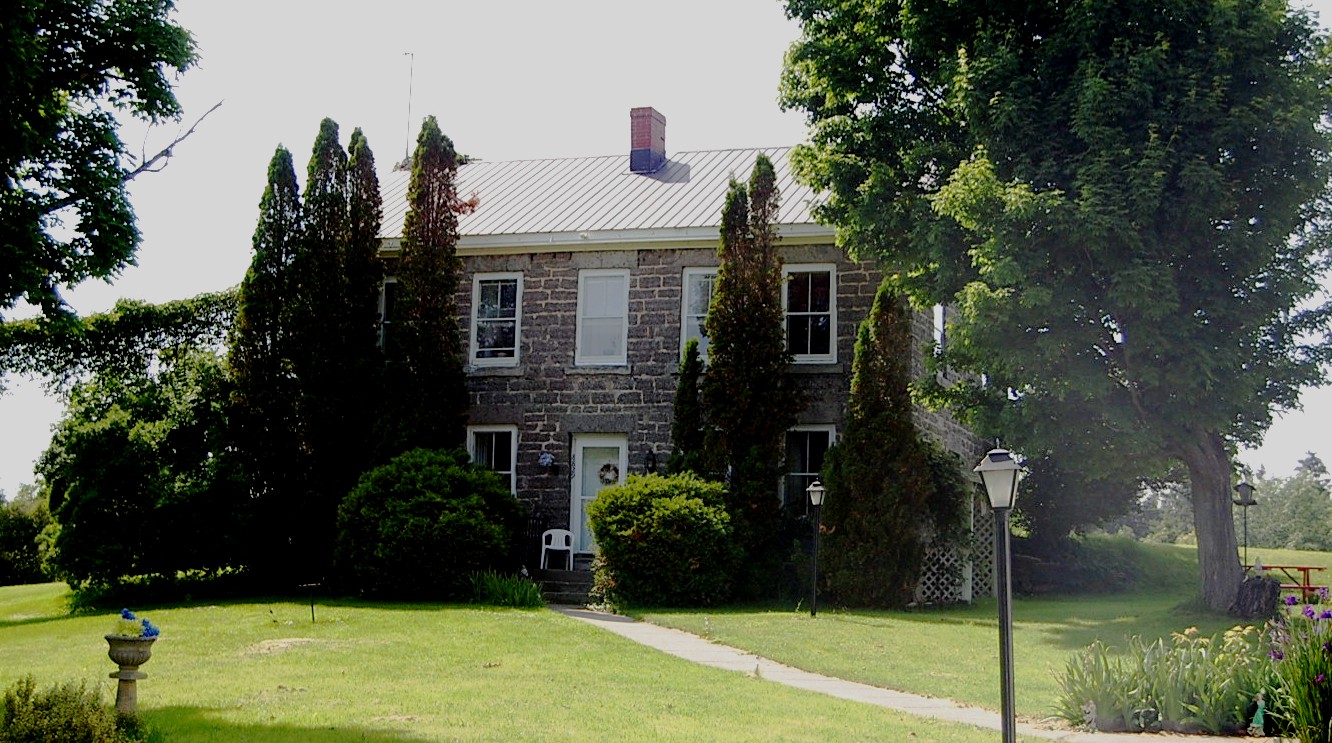
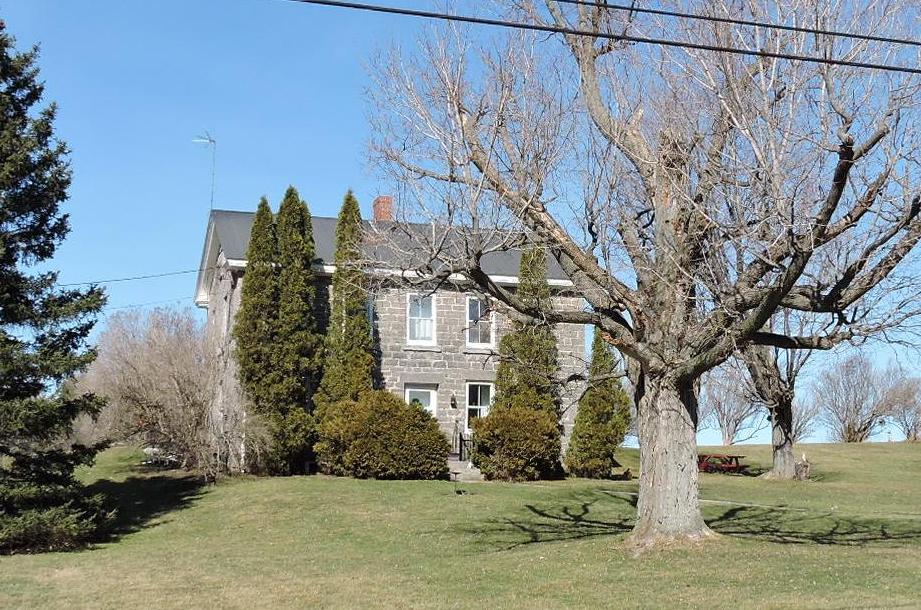
It was about 1840 that this pleasant old native limestone house was built about a mile northeast of the village of Belleville at a spot known as Mather's Mill because it was there that Rufus Mather had a mill a century and a quarter ago. This house, which is still in excellent state of preservation, was built by Samuel Brown, a prominent early resident of the town of Ellisburg, who had bought two acres of land there June 15 1839 from Anson and Mary Fuller of Butler, NY. This plot started at the East corner of Daniel Ellis' land.
There is difficulty in gathering much data concerning this Samuel Brown, and he was one of several Samuel Browns in the county at that time, there having been one at Brownville and another in Lorraine. However, on January 5 1846 this Samuel Brown and his wife, Mary, conveyed a half interest in the house and the two acres to Betsey Lawrence for $900. The deed defines it as a new stone house and reserves to the Browns half of the cellar, the whole of the second story above the cellar, and half of the garret.
Betsey Lawrence died in the latter part of 1855 and in her will provided a life support to her mother, Mrs Martha Hodge, making this life support a charge on her real estate and also upon the income from a $4,000 mortgage. The will specified that after the death of Mrs Hodge her interest in the house and the one acre of land should go to Betsey's sister, wife of Samuel Brown.
Samuel Brown was the son of Zerah Brown, native of Waterbury, Connecticut, who moved into this county in March 1805 and settled in Lorraine (Malta). One older brother of Samuel served with the regulars in the War of 1812. Four other older brothers served in the volunteers. In 1828 Samuel moved his father into Adams and in 1837 came to Mather's Mill. Zerah died in December 1847 and his wife in June 1837. A deed dated February 12 1807 shows that Zerah bought about 62 acres of land in Malta from William Constable's estate and from the same source he purchased 20.38 acres October 3 1821 in the same town. Ownership of the Samuel Brown stone house at Mather's Mill is vague for a period of years but December 29 1896 Angeline C Wager of the town of Ellisburg conveyed it to James T Wager and February 28 1910 James T Wager, widower, sold it to Charles Higgs of the same town. On May 29 1928 Harriet, widow of Charles Higgs, Jennie Lean and Belle Golding, Ellisburg, daughters; Frank Higgs, son, and wife, Marion; Alden Higgs, son, and wife, Pearle, all of Adams, sold the property to Roy K and Hazel M Sidmore, town of Adams, the present owners.
Mrs Sidmore is a distributor of oil and maintains the property in excellent condition. The house consists of twelve rooms and there is now about six acres of land with it. Old residents recall that Samuel Brown also had a son named Zerah, and one deed refers to one of the small parcels of land in the site as having been conveyed by Gilbert L Wheelock and wife to Zerah Brown, who was unquestionably the son of Samuel Brown.
Since last week it has been learned that Mrs Florence E Leonard, 1129 Franklin Street, is a granddaughter of Chester Leonard who owned the stone house near Ellisburg. She asserts that her grandfather built the house in 1827 hauling the stone by ox-team and that he first had a log cabin. Mrs Leonard, daughter of William C McLean, spent her early life in the house.
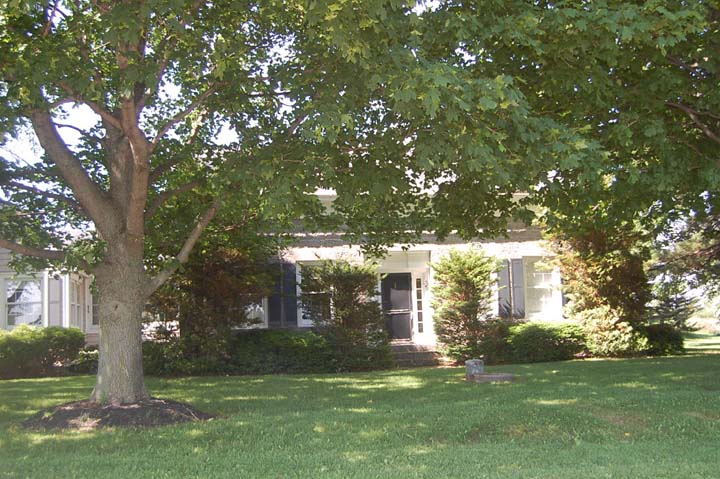
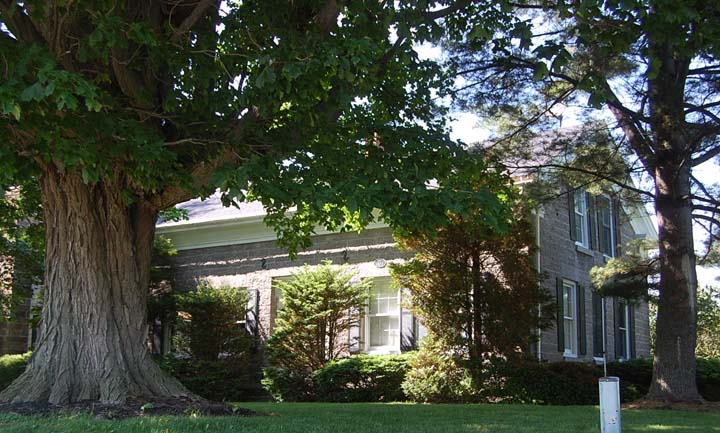
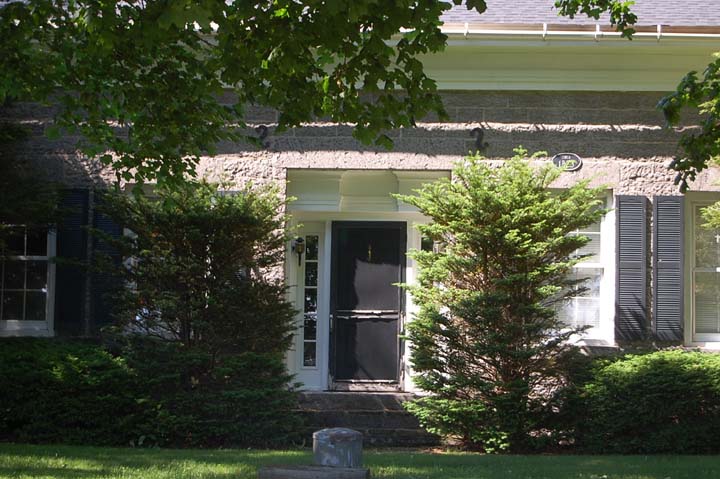
On Lee Rd.
A beautiful little native limestone house of Georgian type and of about the vintage of 1833 is pleasantly situated in a quiet location near the village of Ellisburg on the farms-to-markets road. It has a beautiful central front doorway with fine old door and knocker, rectangular leaded transom and sidelights. There are ten rooms with fireplace in the living room and another fireplace that is boarded up.
It is believed to have been built by Edward S Salisbury, member of one of the earliest pioneer families in the southern end of the county, and since 1943 has been owned by John M Cobb, a relative of the late Senator George H Cobb of this city. The house and buildings are on a farm of 97.59 acres and was bought by Mr Cobb from Roy M and E Anna Johnson, now of Adams.
Edward S Salisbury, who died in Adams August 19 1879 was born November 8 1799 and is said to have been a member of the family of Edward Salisbury, who was a native of Rhode Island and moved to western Oneida county in 1793 next transferring to Adams in 1802. This old pioneer had a distinguished war record. He fought from 1755 to 1758 in the French and Indian war as a first lieutenant, participating in several engagements, fought in the battle of Ticonderoga, took part with Wolfe at the Plains of Abraham near Quebec, served in the Revolutionary war with the colonies and died in March 1829 at the age of 104. Edward S Salisbury's wife was Theodosia, who was born November 6 1801 and died May 19 1881. This farm of 97.59 acres was build up by Edward S Salisbury through the purchase of small parcels of land. On April 5 and May 30 1833 he acquired two parcels of 40 and ten acres from the estate of Apollos Smith and September 3 1833 bought slightly over 20 acres from Abial C and Lydia Copeland.
After 20 years Edward S and Theodosia Salisbury sold the 97.59 acres to David Wheeler 2nd and Norman B Fish for $6,831.58 on March 1 1853 and the following July 16 1853 Fish disposed of his interest to Wheeler Four years later it was found in the ownership of James Rogers who came from Brattleboro, Vermont. On March 11 1887 Sarah E Rogers conveyed the property to Daniel W Lee, an ardent Prohibitionist and breeder of shorthorn cattle, who married Mary M Stilwell January 14 1868 and who was a grandson of Ozias S Lee, Connecticut native who moved into Ellisburg by ox-team in 1810. Daniel W Lee was a widower when he deeded the place to Eugene S Lee for $1 on January 3 1910.
It was the heirs of the latter who sold this property to Roy M Johnson April 28 1916 and for title purposes he and Mrs Johnson conveyed it on December 27 1922 to Attorney William K Mott of this city who on the same day transferred it back to them.
The farm adjoins land which was early owned by Dr Sidney Houghton. Also is abuts land which was owned by Almanzar Converse and by land owned by Luther Jenkins. Mr and Mrs Frank A Rogers, who now reside in the neighborhood, recall vividly the memories of their early married life in this picturesque stone house during the Rogers ownership.
1864 Map of Henderson shows the place then owned by E H Joiner on the present Town Barn Road. House is no longer there.

The inscription "A D 1827" etched in the triangular limestone cap over the front doorway of this native limestone house definitely establishes the time of its construction. The architecture is of simple cottage type and over the narrow front door of four small panes of glass forms the rectangular transom. There are seven rooms and two fireplaces in the upright or stone part of the house and one in the long wooden wing which adds a touch of modernity not quite in keeping with main structure. Andrew Dalrymple, who settled in the town of Henderson about 1804 along with Jedediah and James McCumber, is credited with having built and first owned this old house made of limestone quarried nearby. When the house passed out of the ownership of Mr Dalrymple or into the ownership of one Jedediah McCumber is not clear, but in 1850 a Jedediah McCumber, who was one of the town of Henderson's heavy land-owners 120 years ago, was in possession of it.
From the records it would seem that the Jedediah McCumber, who owned this property and so much other land in Henderson, was the son of the pioneer Jedediah of 1804 and that the latter may have been the one noted in county records as Dyer McCumber, who was living in Mexico, NY, in 1801 and an inventory of whose estate in the surrogate's office bears an April 1814 date. The Jedediah McCumber who owned the house shown herewith was born July 3 1804 in the town of Henderson and Mrs Nelson Springsteen, grand-daughter, now resides in his house which he built in Henderson village about 1834 or 1835. There are two other grand-daughters living, Mrs R K Forward and Mrs Bessie Scott, of Henderson, and a great-grandson, Sidney S McCumber, Northern New York Trust Company vice-president in this city.
The farm of 112.46 acres which goes with this house consists of one parcel of 78.69 acres, another of 31.83 acres and a third of 1.94 acres. May 24 1850 Jedediah and Betsey Bell McCumber sold the largest to Seth Rice, grandfather of the late W S Rice of Adams. April 24 1851 Jesse and Mary Ferguson sold the smallest parcel to Rice, who February 27 1855 acquired the 31.83-acre parcel from the McCumbers. Rice and his wife, Sally M, on that same February 27 sold the whole farm of 112.46 acres to Elle Hart Joiner for $2,850 and Joiner owned it 20 years before he and his wife, Mahala, disposed of it to Orville C Joiner.
Elle Hart Joiner, native of Massachusetts, came to Henderson at two years of age, was a shoemaker by trade, married Mahala Cheever, and died January 2 1881. A son, Oscar B, sailed the lakes 35 seasons, commanded a dozen vessels and was village president of Henderson.
In midsummer, 1902 Frank M Kilby purchased this property from the Orville C Joiner estate and with his wife, Ella M Kilby, sold it March 10 1914 to Brumley C Wilde, long well known as the efficient and colorful undersheriff of Jefferson County. Mr Wilde died in the village of Henderson November 9 1946 having moved there after having joined with his wife, Mrs Grace A Wilde, in selling this old stone house and farm July 21 1945 to Dr Robert S Bickley, wealthy New York resident, who now owns approximately 2,000 acres of the best farm and summer resort lands in the town of Henderson.
Mr Kilby, owner of the place for a dozen years, was for some time proprietor of a drug and general store in Henderson and was a member of the well known Kilby family in that township. Mr and Mrs Howard Shultz are tenants on Dr Bickley's old Dalrymple farm at the present time.
Peter Hoover, one of the earliest settlers of the town of LeRay, built this old house upwards of 125 years ago from limestone quarried in the immediate vicinity. He purchased the first 50-acre parcel of his 174.88-acre farm from James D LeRay de Chaumont July 13 1813 upon a survey made by Musgrove Evans August 18 1810. First he built himself a log house upon the tract, replacing it a few years later by the present house, which retains its original front door with its small, plain transom. The interior is well arranged with two remaining fireplaces and nice, original woodwork.
On March 21 1831 Mr Hoover added a 49.88-acre parcel winch he purchased from the trustees of the Mechanics' Fire Insurance company of New York City, and on November 9 1835 acquired another plot of 25 acres from Elizabeth Hoover. Later there came to him 50 acres from the estate of his son, Simon Hoover, who died intestate March 4 1876. This adjoined the westerly corner of his first 50 acre parcel.
The Hoover family was one of the oldest and best known in the towns of LeRay and Theresa, its members having been prominent in agriculture and in the earlier cheese industry.
Peter Hoover died February 19 1879 three years after the death of his son, Simon, leaving eight children, among whom he equally divided the bulk of his net estate. These children were Catherine Walradt, Sarah Bacon, Betsey C Helmer, Mary H Petrie, Almeda E Hoover, Clarinda Walradt, Isaac Hoover and Jacob A Hoover, George Petrie and Philip Helmer were executors of his estate.
At the time of his death Peter Hoover, who came from the Little Falls area of Herkimer, was 91 years of age. Upon his farm, which is located on the Dutch Settlement road about two miles north of Evans Mills is a spring which has never been known to run dry, and in the sale of this farm his executors reserved all the rights which he had granted during his lifetime to Leonard Heymer and Jacob Nate to use spring water from his farm in the operation of the Sunnyside cheese factory. Also was reserved the quarter acre of land, which he conveyed December 1 1851 for a nominal $10 to Alfred Vebber, Isaac Walradt and Alexander H VanBrocklin trustees, for a cemetery which became known as the Hoover burial ground
[NOTE: Find a Grave has this Hoover Cemetery on the CALL RD which is off the Dutch Settlement Rd, in Evans Mills]
This plot was a part of his farm and is still to be seen by those who pass by. First to be buried in it was J Adam Walradt who died February 27 1831 and who had expressed a desire to be buried in that vicinity. His friends accordingly selected the spot for the grave. As time went on other burials were made until there had been 80 when Mr Hoover conveyed the plot to the three neighbors chosen for cemetery trustees. Among those buried later in the cemetery was his son, Simon, who died at the age of 51.
The executors of Peter Hoover's estate disposed of this stone house and farm to Sylvester Petrie for $8,000 on January 5 1882 and it has since been in the Petrie estate. Following Mr Petrie's death his will giving his widow Caroline, a life-use of this farm and the home farm was recorded Mar 20 1907. and devised these properties to his children, Mrs Cora Petrie Drake, Mrs Effie Petrie Storms and Emory Petrie, who acquired the interests of his sisters and is now the owner of the property. He is a well known resident of Evans Mills and a former deputy sheriff. By coincidence he is now arranging to deed a half interest in this Hoover farm to his son, Paul, who is connected with Montgomery Ward & Company.
There is not a more attractive old stone house nor one with a more attractive setting and beautiful vistas than the old Collins Rouse house located on a little traveled town highway near Stone Mills. Although it is not much more than two miles from the state highway which runs through Stone Mills to LaFargeville, it is still far enough off the beaten path to insure quiet, seclusion and contentment.
The road upon which this house was built by Collins Rouse about 112 or 113 years ago runs from Stone Mills back of the hamlet of Clayton Center and, bending to the left, comes out in the village of Clayton. When it was erected from the excellent native limestone, quarried nearby, the house was almost an outpost on that route, and was in the area known as Rouse's Corners.
Collins Rouse, born November 18 1800 was the son of William Rouse who is believed to have been a native of Stonington, Connecticut. Collins Rouse was a thrifty farmer, ardent Baptist, Republican and father of nine children, one of whom was Charles Rouse, a talented portrait painter in San Francisco. Another child, Weltha, married Bennett F Brown and became the mother of the late Attorney Abner B Brown of this city. Collins Rouse was married to Polly Sexton October 2 1823 and in his later life he retired from the farm and moved to Philadelphia. He died September 4 1875.
William Rouse, a brother of Collins Rouse, was a president of the Jefferson County Agricultural society. Daniel C Rouse, another brother, was the grandfather of the late State Senator Elon Rouse Brown of this city. On March 1 1866 Collins Rouse sold this house and its 86.57 acres of land to William P Smith of the town of Brownville, who disposed of it to Eliott J Peck of the town of Orleans October 9 1867.
On February 26 1881 Eliott J and Persis Peck, then of this city, sold the place to Florence S, wife of George A Lance, who was long a well known local industrialist. Mrs Lance was the daughter of the late Abner W Peck, who was sheriff of Jefferson County in 1875 and on April 21 1891 she and Mr Lance conveyed this fine old stone house and farm to Mr Peck for the nominal sum of $1. Mr Peck was also the father of Captain Frank H Peck, former district attorney of this county, fearless soldier of the Spanish-American war and Boxer Rebellion, and of Lieutenant Fremont Pearsons Peck, West Point graduate who lost his life when a Hotchkiss gun exploded at the Sandy Hook ordnance proving grounds February 19 1895.
Mr Peck sold this property to his daughter, Miss Flora S Peck of this city, for a nominal amount August 13 1901. Some years later Miss Peck conveyed this place to her nephew, Lott M Peck, son of Captain Frank H Peck, and local real estate broker. After a short time he sold it to John B Storm of Three Mile Bay. Mr and Mrs Storm eventually sold it to Gyula and Anna Doroha of the town of Clayton. Through a mortgage foreclosure sale it was later acquired by Leonard Hax of this city, and from him it passed to Leland C and Maude Hax who disposed of it September 23 1946 to Anthony H Weiler, city, manager of the Triangle shoe store here. Since then Mr Weiler has done much to restore the old house in an intelligent and attractive manner for use as a country place upon the site which Collins Rouse purchased for $346 from John and Louisa LaFarge on May 14 1833. However, Mr Weiler takes less than two of the 86.57 acres bought by Collins Rouse
"located a short distance from the Watertown-Sackets Harbor state highway on the west side of the Bagg's Corners-Camp's Mills road" - the Salt Point Road (co Rt 66)
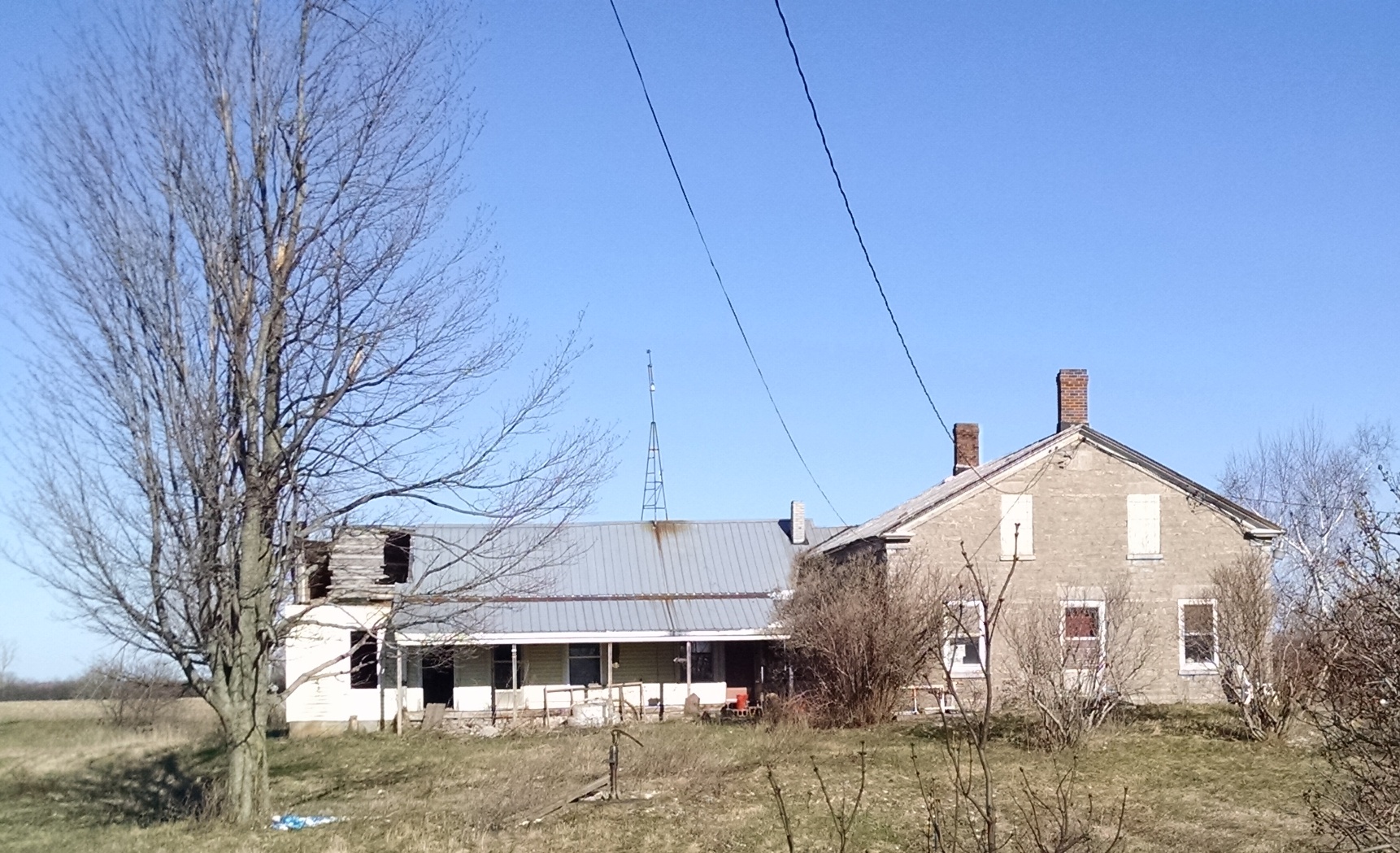
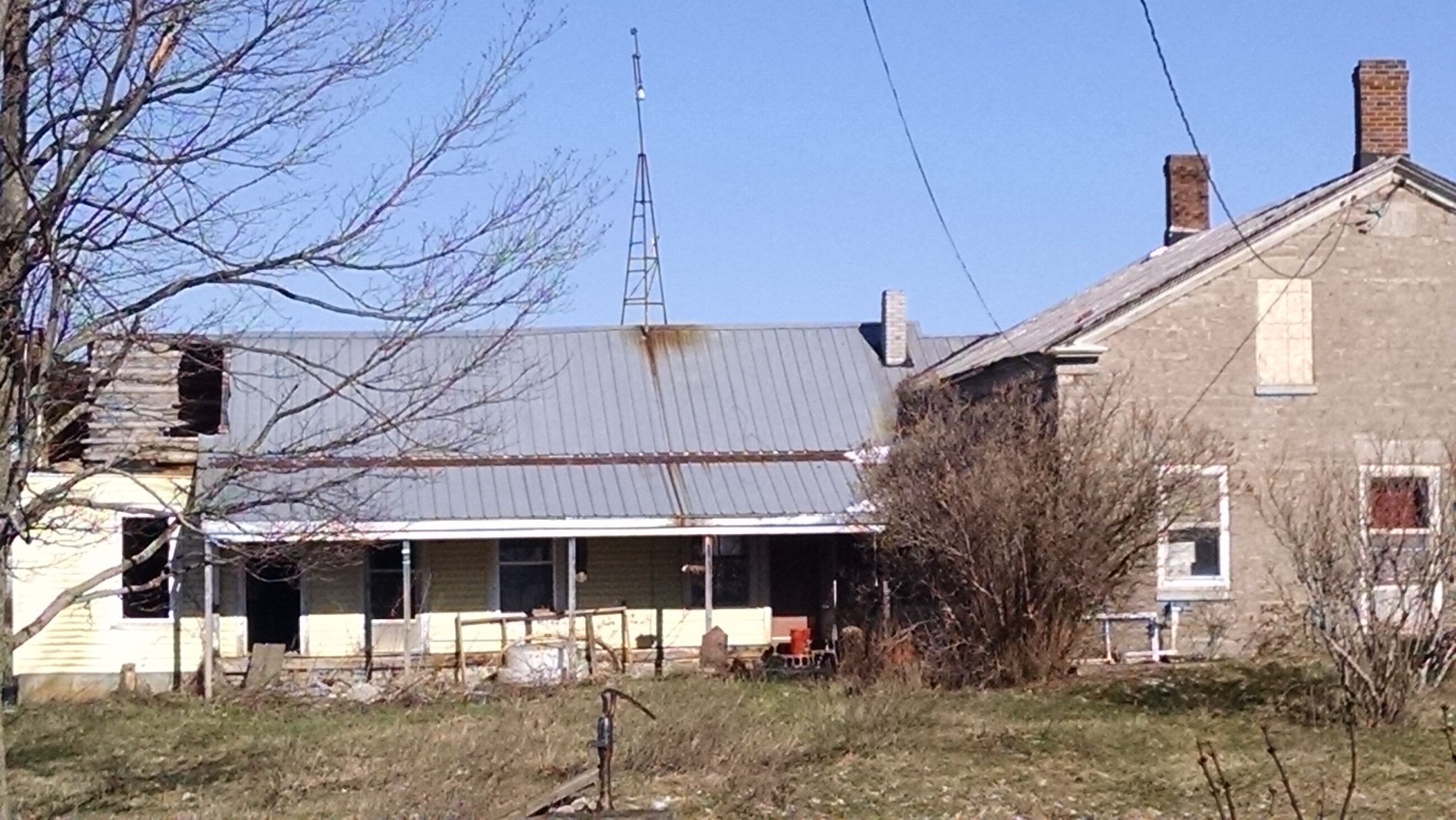
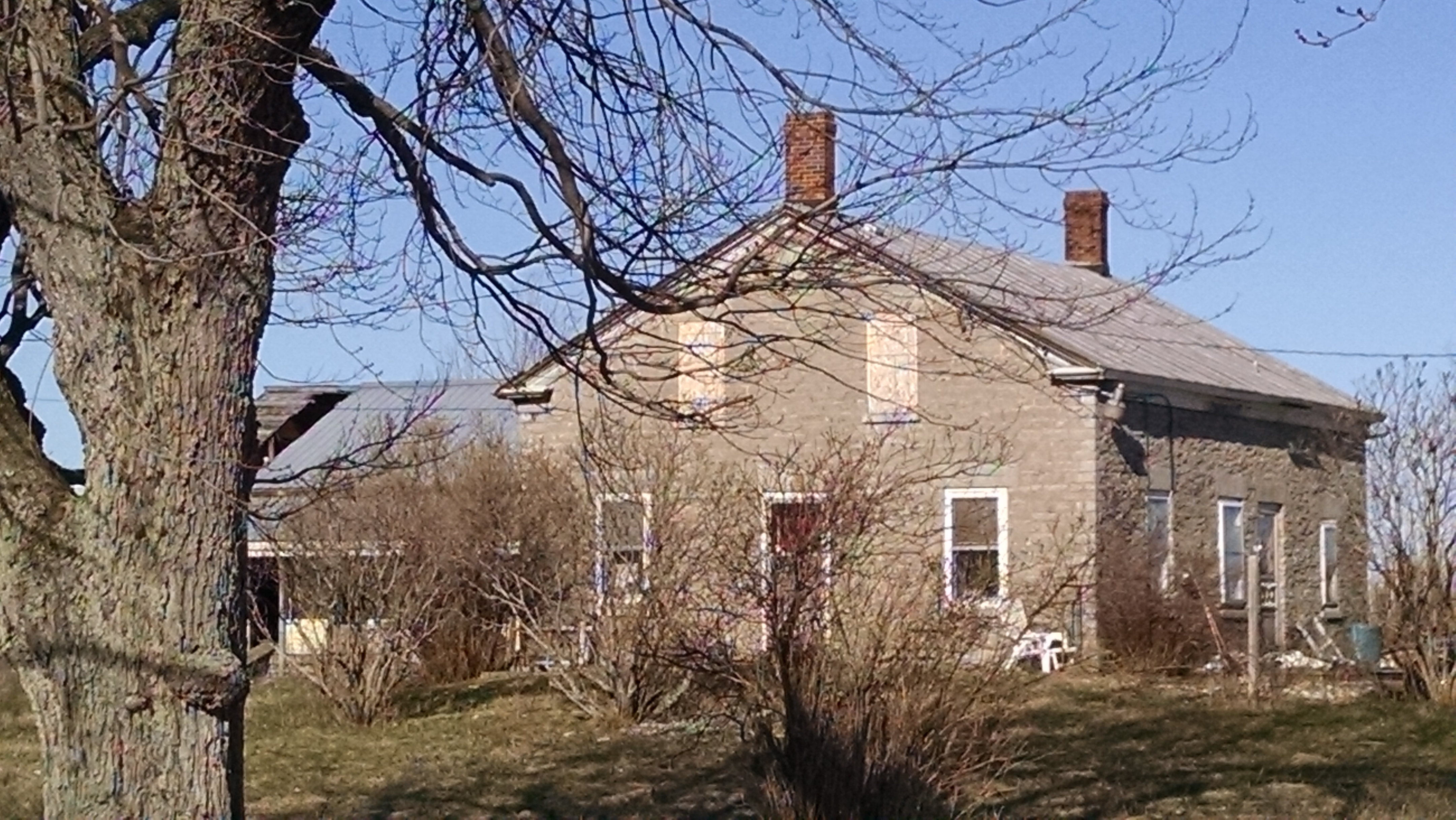
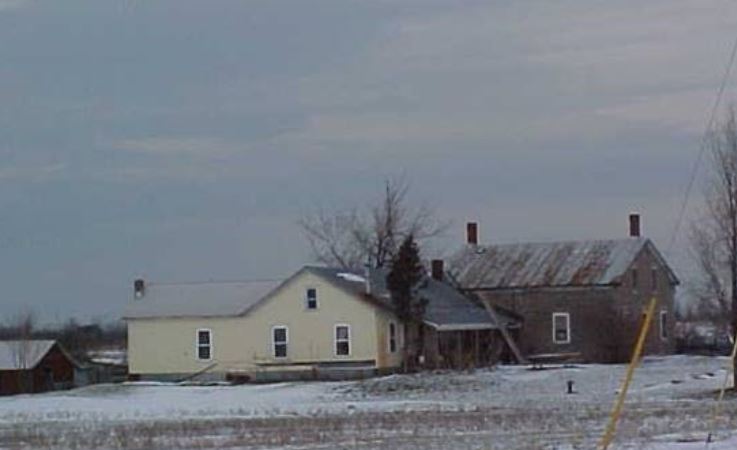
(photo above taken by Cheryl Guilfoyle Dickinson ) Below in 2020
Into a big square stone in the very peak of the front gable of this old native limestone house is cut, "G Lee 1834." Thus the date of construction of the upright part of this house is definitely established along with the name of the original owner. The house is located a short distance from the Watertown-Sackets Harbor state highway on the west side of the Bagg's Corners-Camp's Mills road. With its out-buildings and 155.18 acres of land it was purchased on June 2 by Dr Robert S Bickley, New York City, who now owns approximately 2,000 acres of valuable Jefferson County agricultural and summer resort lands.
In his book, "The Lee Family of Hounsfield, NY and Related Families," brought out in 1941 the late Reverend Walter John Coates, Litt. D, names this George Lee founder of the Lee family of Hounsfield. Born in Albany county April 2 1791 George Lee may have come into Jefferson County at the War of 1812 time. An advertised letter in The Sackets Harbor Gazette shows that he was in Hounsfield at least as early as July 1 1817.
Five contiguous parcels of land were acquired by him to constitute this farm of 155.18 acres. The first of these, a parcel of 60 acres, was bought from John and Hannah Worden June 13 1826. In 1828 he bought 57.5 acres from William Smith as receiver of the William Warring estate. On February 14 1835 he purchased two parcels of 20 acres and 5.06 acres from John and Pamelia Worden and August 1 1841 he bought 12.62 acres from Dr Samuel Guthrie, of Jewettsville, discoverer of chloroform.
On Mar 11 1821 George Lee was married to Olive, daughter of Nathan and Abigail Westcott Baker, who came from Deerfield, Oneida county, to settle at Stoel's (Stowell's) Corners.
A natural musician, George Lee was an old-time fiddler and his musical ability was imparted to several of his children. His will, recorded March 14 1877 named his sons, Lemuel George and Washington executors and divided his estate among his children. They were, besides the above, Mercy Ann, Addison Hoyt, Harry, Helen Maria, Freeborn and Wallace. Jesse D Lee of this city is a grandson of George Lee.
On July 11 1881 Sylvester Benjamin, administrator of Washington Lee's estate, conveyed the farm to Orson V Pease, son of William C who was a native of Connecticut, and became an early Hounsfield settler serving at Sackets Harbor in the War of 1812. On July 16 1881 Orson V and Elvia B Pease deeded the farm to Edward Sloman, who sold it back to them March 6 1884. Two years later Orson died. Later the farm went to his daughter, Mrs Maria F Shead and March 1 1893 John S Pettit as her committee sold it to John A Morrison. His wife, Lydia Morrison, Was the next owner and in his will, recorded March 18 1918 devised it to her brother John H Resseguie, and sisters, Hannahett Miller and Emma L Ryder. Mr Resseguie and Mrs Ryder later conveyed their interests to Mrs Miller.
By Mrs Miller's will recorded March 24 1934 her son, David G Miller, inherited her residuary estate including the farm and the following April 25 he deeded it to himself and wife Gertrude jointly. Then on April 6,1941 they sold it to Mrs Emma B Clark as executrix of the estate of her husband, R Sheridan Clark of Chaumont. As executrix of this estate Mrs Clark sold the property on March 29 of this year to Leon E and Grace M Dickinson. Mr and Mrs Dickinson then disposed of the property on June 2 to Dr Bickley. The house has a long frame wing on the south side which does not show in the picture.
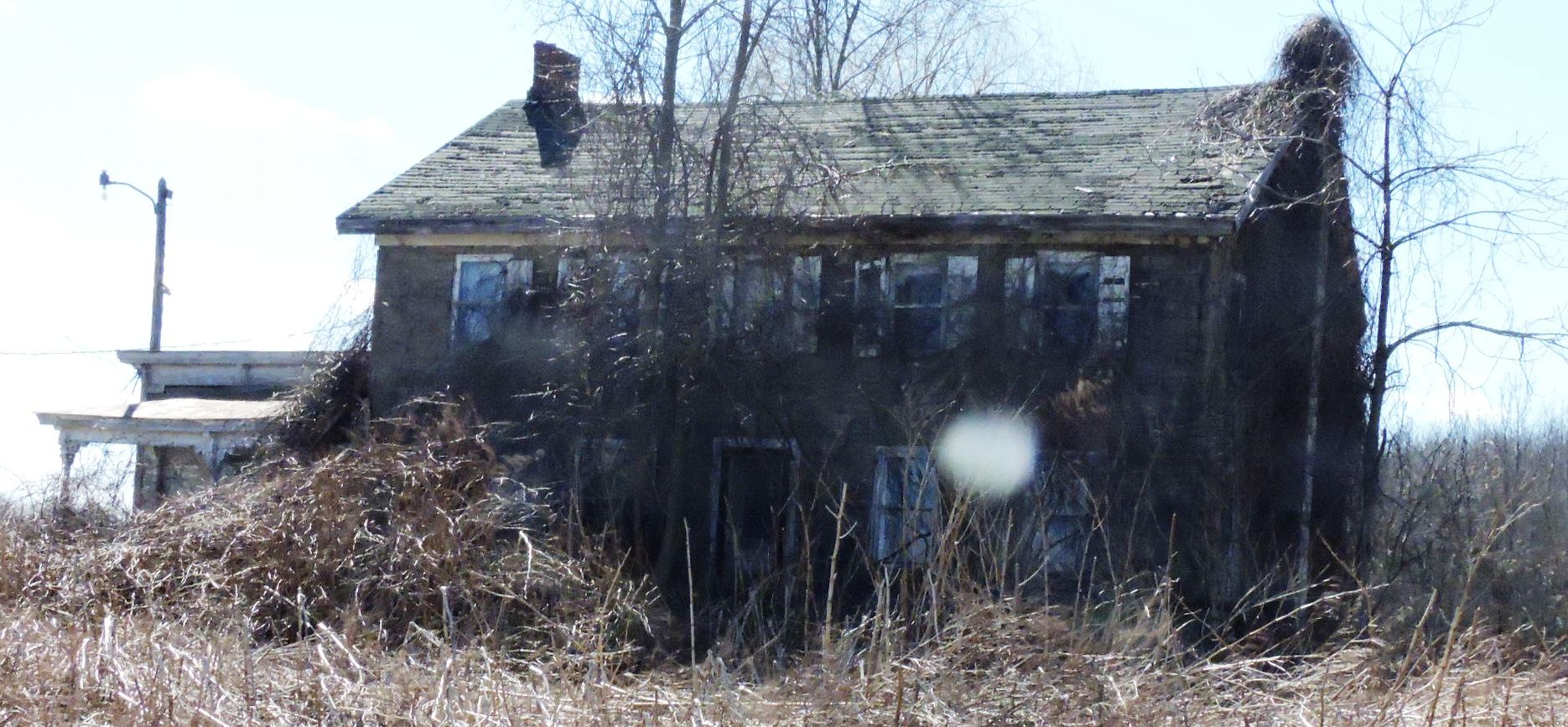
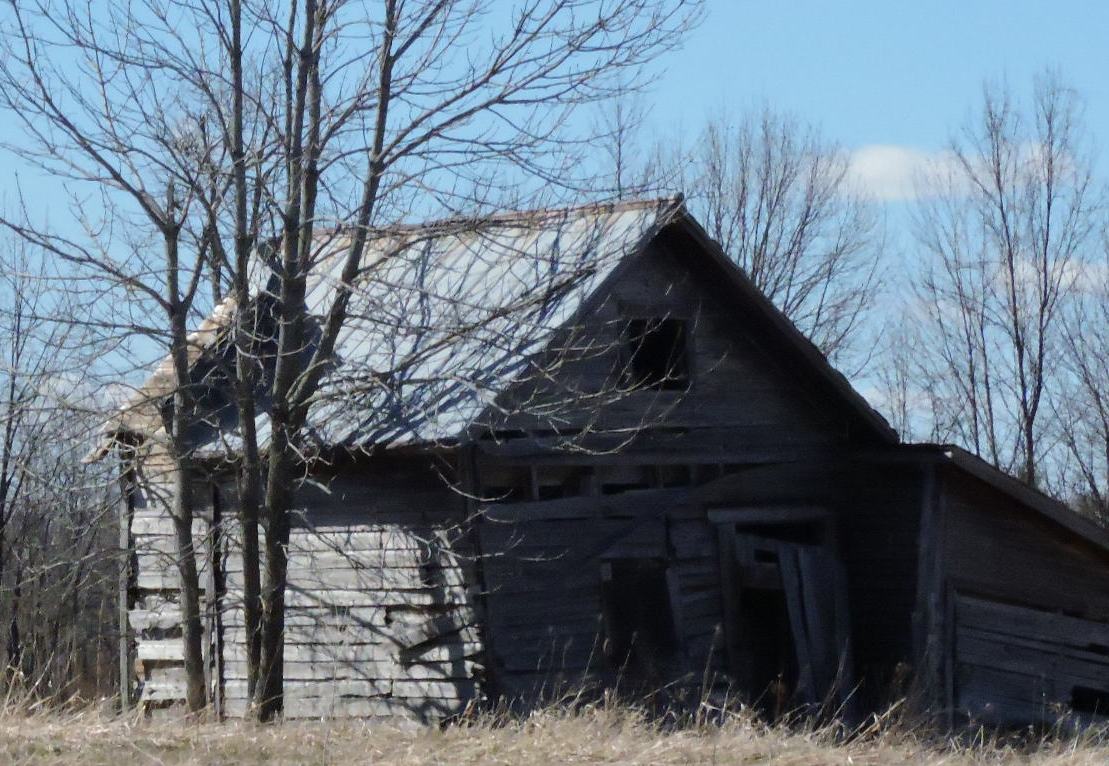
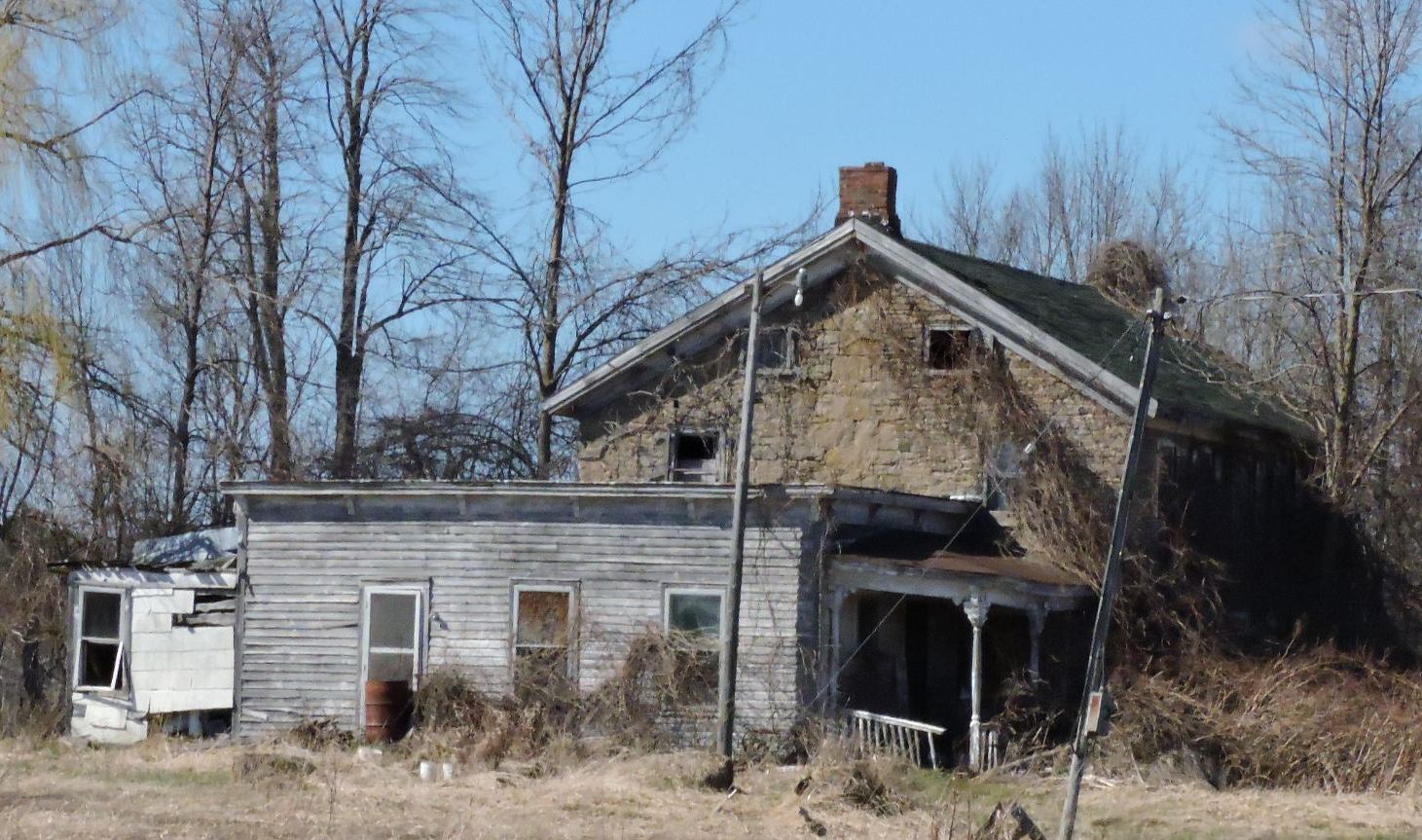
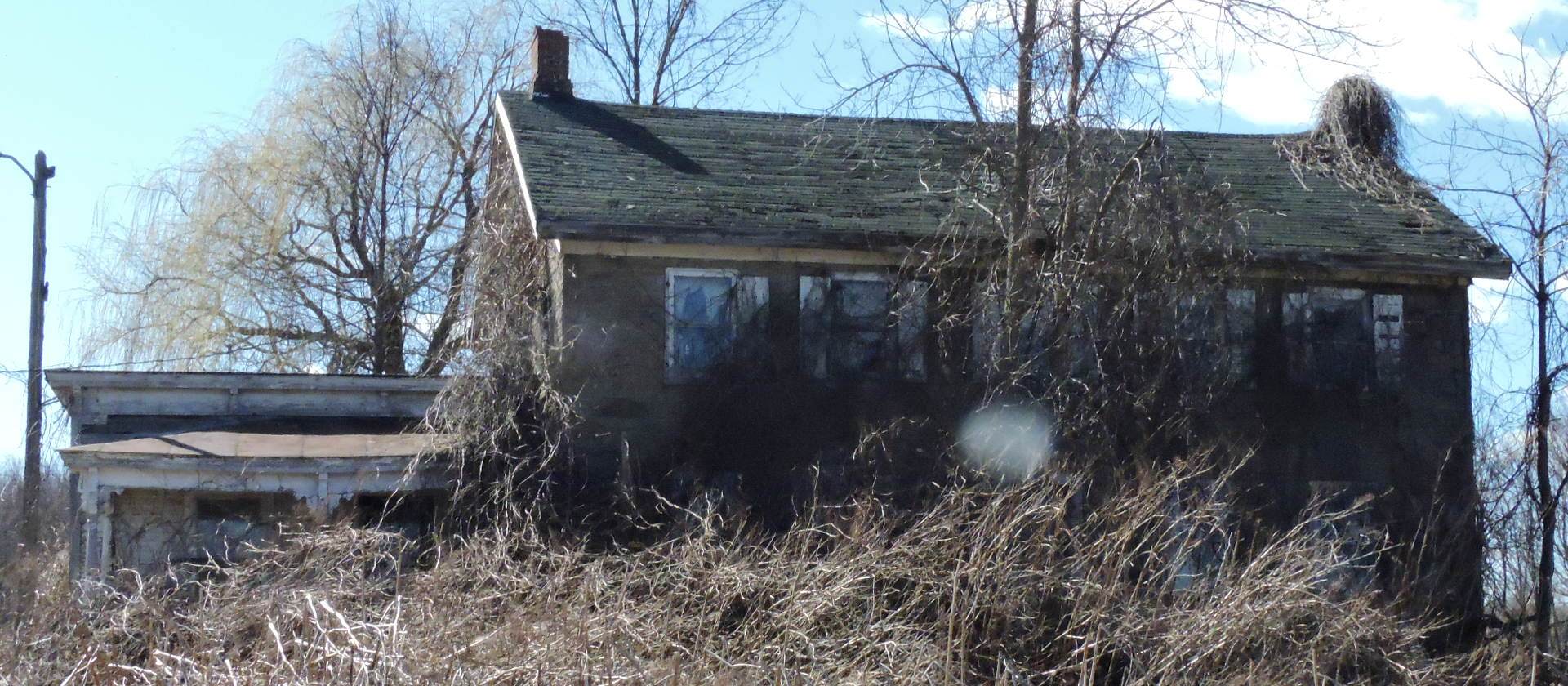

About 14 miles east of Ogdensburg on the Van Rensselaer road is this neat and attractive house which is believed to have been built about 112 years ago by Moore Lee Porteous, a native of Ireland, who had come to this country about 1820 and settled in St. Lawrence county. Another Porteous, Samuel, but a native of Scotland, had come to Waddington the same year and worked at his trade of stone mason in constructing the stone dam and walls for the Ogdens on Ogden island.
The Van Rensselaer road is the river route between Ogdensburg and Waddington and upon the farm where this house stands was quarried the limestone from which it was made. Construction likely was started soon after Mr Porteous purchased the farm from Joshua Waddington April 7 1835. It is located in the town of Waddington, which was established from the old town of Madrid November 22 1859 and named for Joshua Waddington, who had acquired a third interest in the area from his brothers-in-law, David A and Thomas L Ogden in 1803. Consisting of a dozen rooms and two fireplaces the house with its broad acres has been owned and occupied for 43 years by Mr and Mrs William J Greene. The old mansion is a specimen of fine, sturdy masonry and its record shows exceedingly few changes in ownership down through the decades.
Moore Lee Porteous had been a clerk in a store in the old country and knew little about farming. In consequence he employed Scotch and Irish immigrant boys to work the farm for their board and clothes and operated a general store himself on the premises, bartering his produce, for there was little money then in circulation.
A thrifty man, Moore Lee Porteous accumulated a comfortable estate and did well by his sons and daughters when he died at 83. He left this house and farm to his son, David, to whom it was conveyed April 12 1878 and David, who married Mary Scott, a neighbor girl, became the father of five daughters, one of whom became the mother of Fred J Gray, veteran Ogdensburg attorney. On March 1 1895 David and Mary Scott Porteous sold this farm to Peter Greene and his sons, William J and Grover. Peter Greene's parents were also early settlers in the Waddington sector having been English emigrants who established themselves on what is now the John Salton farm on the Middle road. Peter Greene married his next-door neighbor, Mary Hanlon, who had come to this country from Ireland.
Mr and Mrs William J Greene were rural teachers, Mr Greene also acting as secretary for local factories. Following his marriage he purchased and operated the Sterling Creamery located a mile and a half from this native Stone house and farm, which he took over March 3 1904 when he purchased the interests of his fatherland brothers, Peter and Grover Greene. Mr and Mr William J Greene are the parents of five children: Clifford, deputy collector of customs at Waddington; Reginald, who owns a nearby farm; Miss Lillian M Greene, a teacher in that section; Raymond, operator of the home farm, and Miss Florence Greene, who has charge of "Greene Lands" store upon the farm.
211 Ambrose St
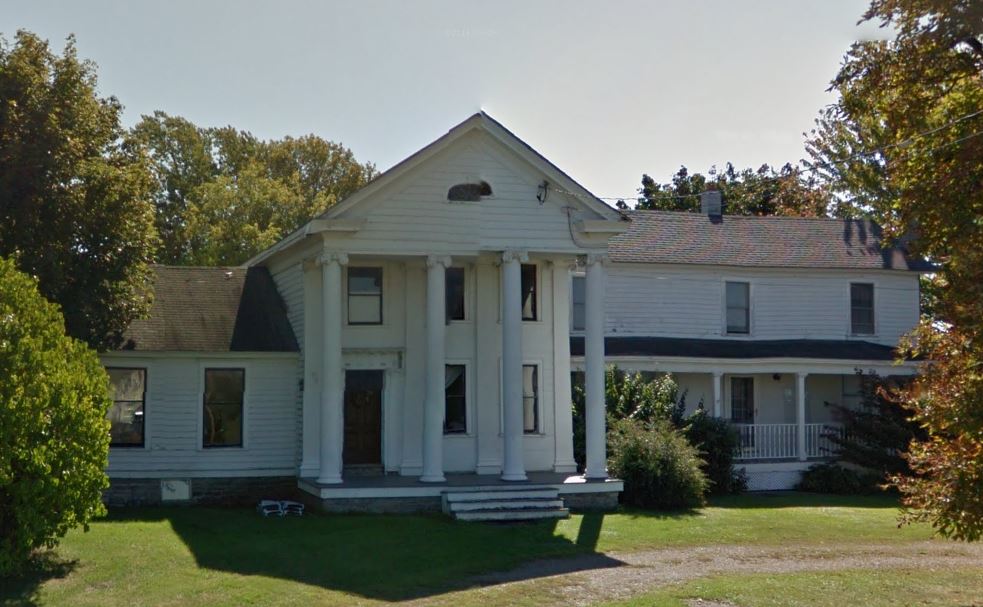
Tall Ionic columns supporting a handsome pediment, and a beautiful front door and doorway make this century old house a distinctive one. It is said to have been built by Erastus Rogers, an early Sackets Harbor settler, slightly over 100 years ago, but there is a possibility that it was built by David Millington, who came to Sackets Harbor in 1814. He was a charter member of the Athol Lodge. No 308 F & AM in 1818 married Laura Fields and died November 10 1877 aged 83. He is believed to have been descended from Gilbert Millington, the regicide who fled England in 1649 and whose descendants came up through Bennington, Vermont and through Herkimer county to Jefferson.
[NOTE: Gilbert Millington never fled England. He died in prison there. Source: http://bcw-project.org/biography/gilbert-millington states:
Gilbert Millington, c.1598-1666
Nottinghamshire barrister and MP sentenced to life imprisonment for his part in the King's trial and execution.
The eldest son of Anthony Millington, a gentleman of Felley Abbey, Nottinghamshire, Millington attended Peterhouse College, Cambridge, and became a barrister at Lincoln's Inn in 1621. After his marriage in 1618 he inherited the estate at Felley Abbey in 1620. Millington served as a Justice of the Peace from 1631, was appointed deputy-lieutenant of Nottinghamshire in 1638 and was elected MP for Nottinghamshire in 1640. During the First Civil War, Millington was prominent in the administration of Nottinghamshire. He became involved in the dispute between Colonel Hutchinson and the county committee, and was harshly depicted in Lucy Hutchinson's famous account of Hutchinson's life as a result.
Millington was one of the few barristers willing to serve on the High Court of Justice which tried and condemned King Charles I in January 1649. He remained active on parliamentary committees and in local government throughout the 1650s.
At the Restoration, Millington made no attempt
to deny his part in the regicide. He was brought to trial in October 1660
and sentenced to death. On appeal to the King, the sentence was commuted
to life imprisonment on Jersey, where he died in 1666. ]
Occupying a deep lot with 100-foot frontage on the southeast side of Ambrose Street the house is of stout wooden construction bricked between the studs, but much of its beauty is screened by a tall lilac hedge along the street sidewalk. Special historic significance attaches to the house because of three-years' residence by Colonel Richard I Dodge, Civil war veteran, hero of Bull Run who wrote the most complete works on the life and habits of the American Indian and his s country, including "The Black Hills ' "The Plains of the Great West," "Our Wild Indians," "A Living Issue."
It was September 7 1839 that David Millington bought the Plot containing the site of this house from Thomas L Ogden, trustee of associates in the Sackets Harbor. On September 2 1843 he sold the site to Sarah Gray of Sackets Harbor and April 4 1844 she disposed of it to Erastus Rogers. At almost 83 Rogers died December 15 1872 his widow, Mary F Rogers, inheriting the property, which she sold to Colonel Dodge August 31 1892 and the ensuing December 1 she died at almost 84. On November 5 1892 Colonel Dodge deeded the place to Laura Settright, his Indian housekeeper and resided there until his death June 15 1895
Colonel Dodge was born at Huntsville, N C, May 19 1827 graduated from West Point in 1848 went through the Civil war, was commissioned colonel of the 11th U S Infantry June 26 1882 brought the band and five of its companies to Madison Barracks August 10 1887 and there was retired May 19 1891 nearly a year before he bought this house with its pleasant rooms, excellent woodwork and fine fireplace mantels.
Colonel Dodge, who had been provost marshal of Maryland Pennsylvania and New York City, was responsible for many improvements and expansions at Madison Barracks including Dodge hall, wooden administration building.
On October 2 1902 Judge J A McConnell as administrator of Laura Settright Goodwin's estate sold this house to Colonel James Regan, who succeeded Colonel C F Robe in command of the 9th U S Infantry August 7 1903, he having only returned to Madison Barracks from the Philippines July 3 1902. Colonel Regan, New York City native, enlisted at 14 came up from the ranks, fought at San Juan hill and Santiago de Cuba in the Spanish American War, was wounded at Tien-Esin, China, July 3 1900 and died in bed at 62 in Cuartel de Espena Manila June 25 1906. Mrs Evelyn G Regan and children sold the Ambrose Street house to Thomas L Rankin November 28 1910. From him it passed to Alice L Rankin and as executor of her estate Senator George H Cobb sold it to Victoria M Blodgett July 3 1920. On October 1 1924 Clark A and Victoria M Blodgett sold to Mrs Edward L (Elizabeth Munson) Bay; and sister, Mrs Isaac (Edith Munson) Munson and it is now the residence of Mr and Mrs Edward L Day, son of the late Assemblyman Lewis W Day of Sackets Harbor. Mr Day was a founder of the former Winslow-Day company of this city and later was a silver fox breeder for some years. Mrs Day, daughter of the late Mr and Mrs Frank H Munson, is a granddaughter of Dr Isaac Munson who was one of the founders and vice president of the Agricultural Insurance company.
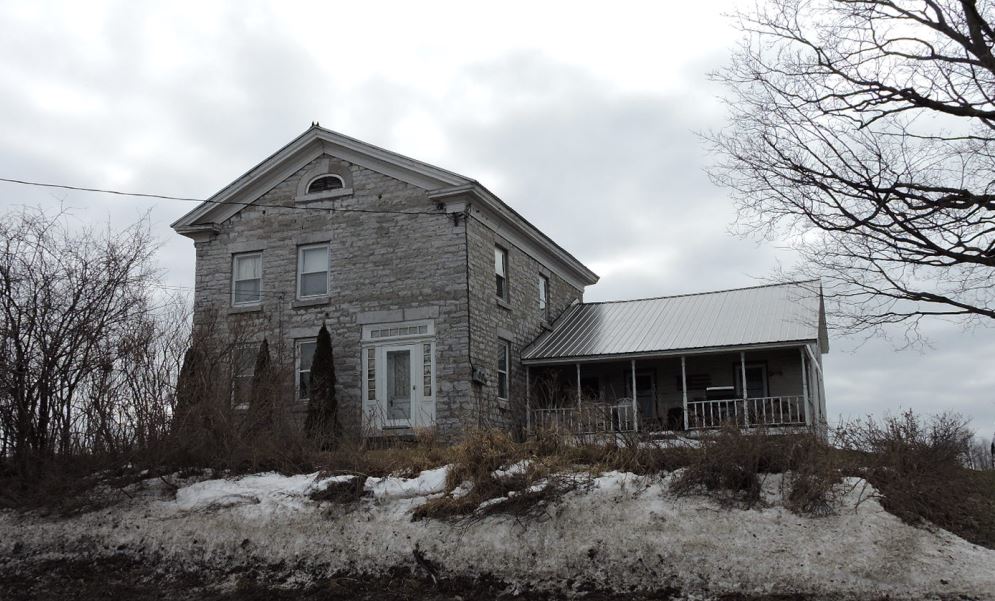
Mr Griswold, whose wife's name was Angeline, was a widower and resident of Felts Mills at the time of his death December 8 1886. In his will, he provided that his daughter, Laura, should have a life-use of this farm on the Martin Street road, but that it might be sold by his estate and the income from the proceeds paid over to her. As a consequence Sarah E Hatch, Carthage, executrix, conveyed it to Albion J Shew of Champion June 15 1887.
On October 11 1902 Albion J and Helen M Shew transferred it to Lewis and Minnie R Webb of New York City. After a few years they disposed of it and October 27 1913 James and Emma Shaufty of Champion sold it to D C and Julia Rohr Bretsch, who conveyed it back to the Shauftys March 27 1919 and on March 1 1920 they deeded the place to William K and Emogene Miles Peck. On November 18 1924 they sold it to Wade A and Mary E Mosher and August 14 1941 they disposed of it to George C Dona of Evans Mills R D 2. It was Mr Dona who sold to Mr and Mrs Twitchell February 2 1944 and the next year they transferred to Mr and Mrs Smith, the present owners.
The house is well built of good native limestone and in the Georgian manner. There is a small frame wing on the north end. The stone upright contains eight rooms and originally there was a fireplace, but this has been closed for several years. From its elevation atop a high embankment there is an excellent view in all directions, but the vista from the rear is the most sightly.
A stone set in the peak of the rear gable of the upright part of this house states that it was built in 1842. The house is situated on the west side of the Martin Street road not far from the village of Great Bend, and the Martin Street road runs from the Watertown-Carthage state highway at Great Bend to the village of West Carthage.
It and the Great Bend-Champion road come together in the apex of a triangle at Great Bend and the third side of the triangle is formed by that portion of the Watertown-West Carthage highway which connects Champion village with West Carthage. Martin Street got its name from the number of Martin families who early lived there.
W Howard Smith and wife, Evelyn F Smith purchased the house November 2 1945 from William H and Margaret A Twitchell of the same town. The purchase included 50.79 acres of land and barns. Prior to this conveyance the property had a number of different owners.
There is a tradition in the neighborhood that the house was built by
William Griswold, but the records in the county clerk's office would seem
to disprove that, for the deed running from Mr and Mrs Twitchell to
Mr and Mrs Smith states that Mr Griswold acquired the property in two
parcels. One of these was from Ozial and Cynthia Howland of Pamelia March
31 1858 and the other was from Matthew G and Esther Coon January 15 1859.
However, an old Jefferson County map of 1855 which shows the towns and
the principal owners of properties, lists E Griswold as the owner of
this place. Because of inability to trace deeds prior to Howland and Coon
there is a possibility that the house was built by a member of the Griswold
family, later passed out of the possession of that
family and then was bought back by William Griswold.
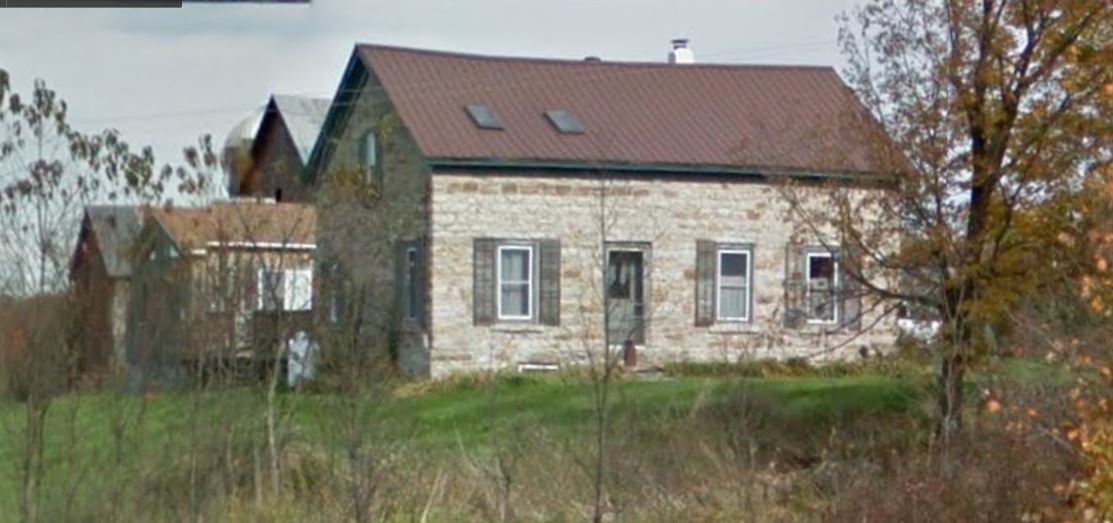
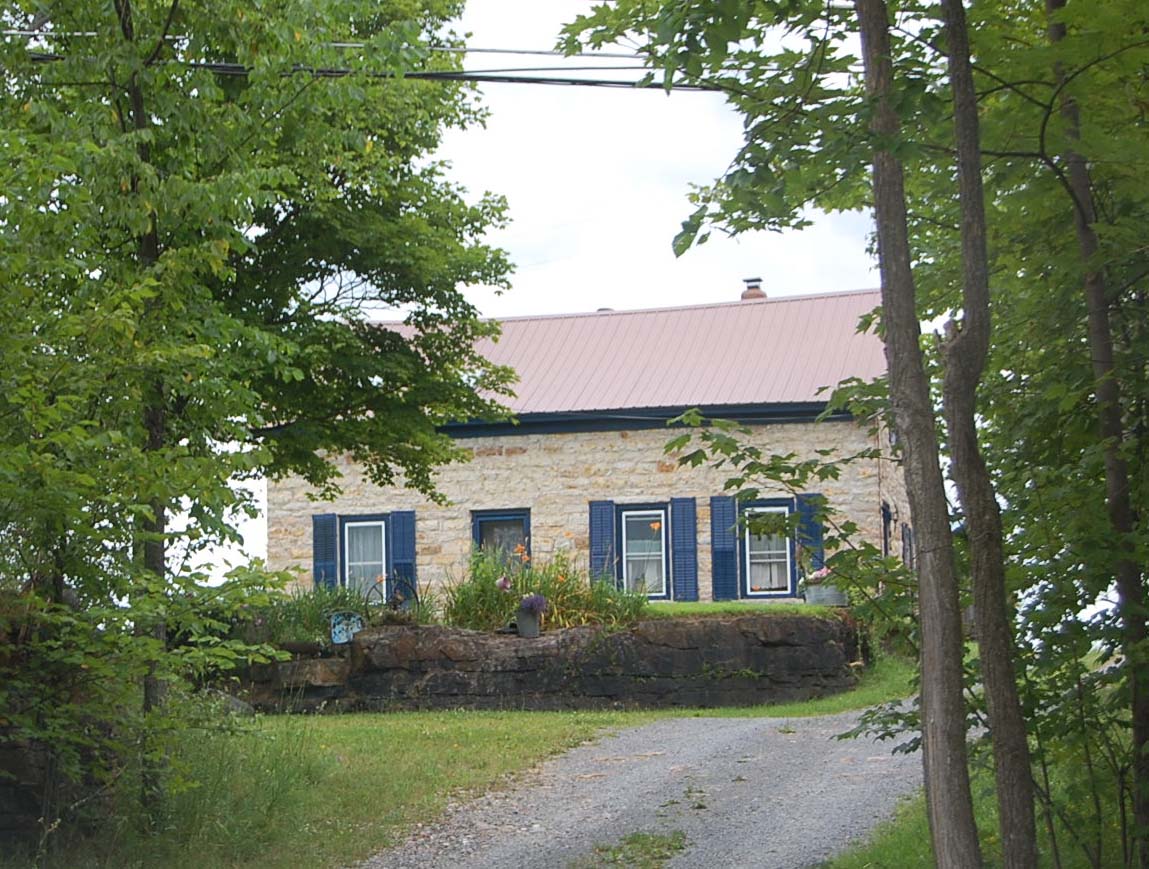
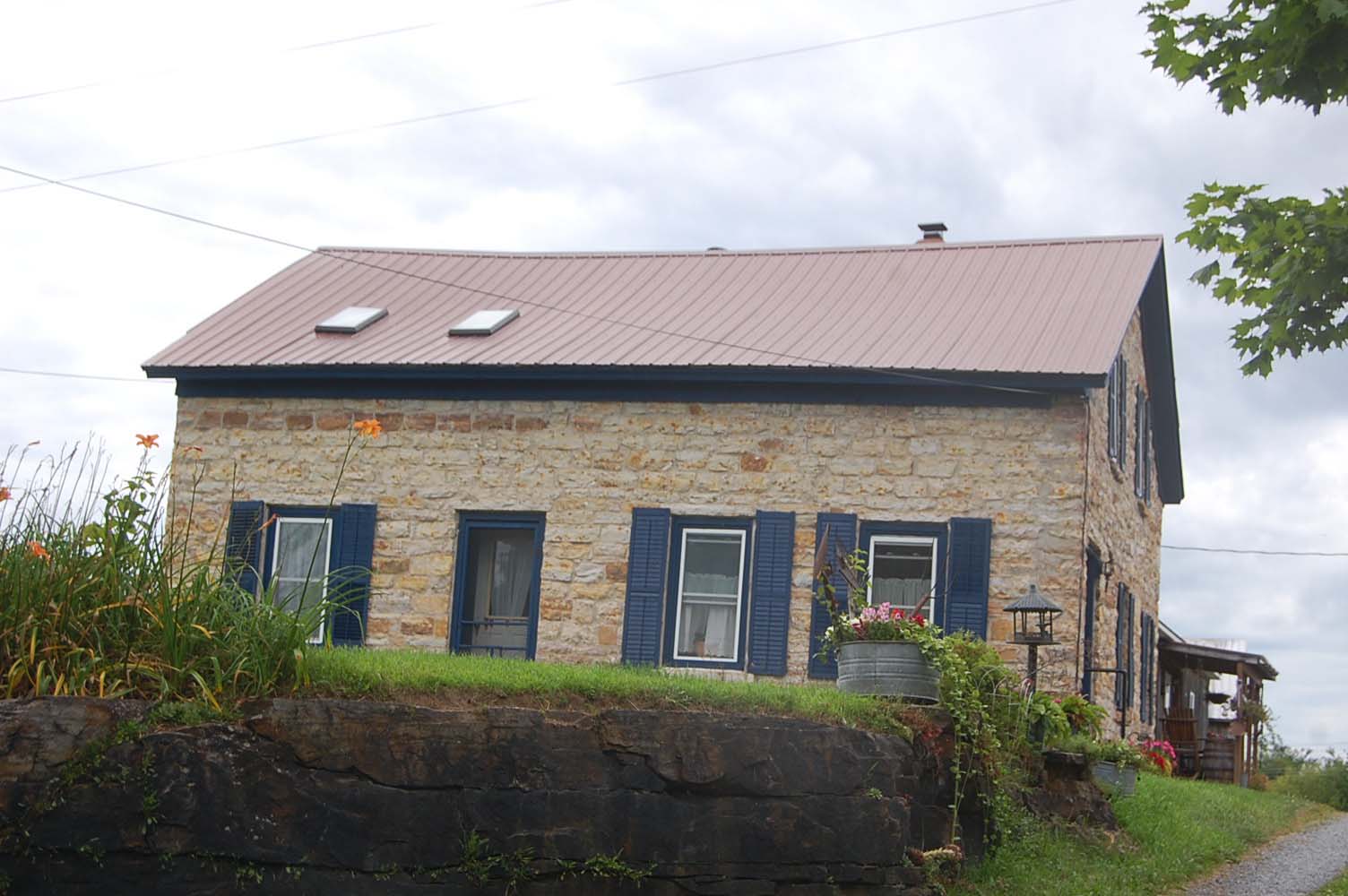
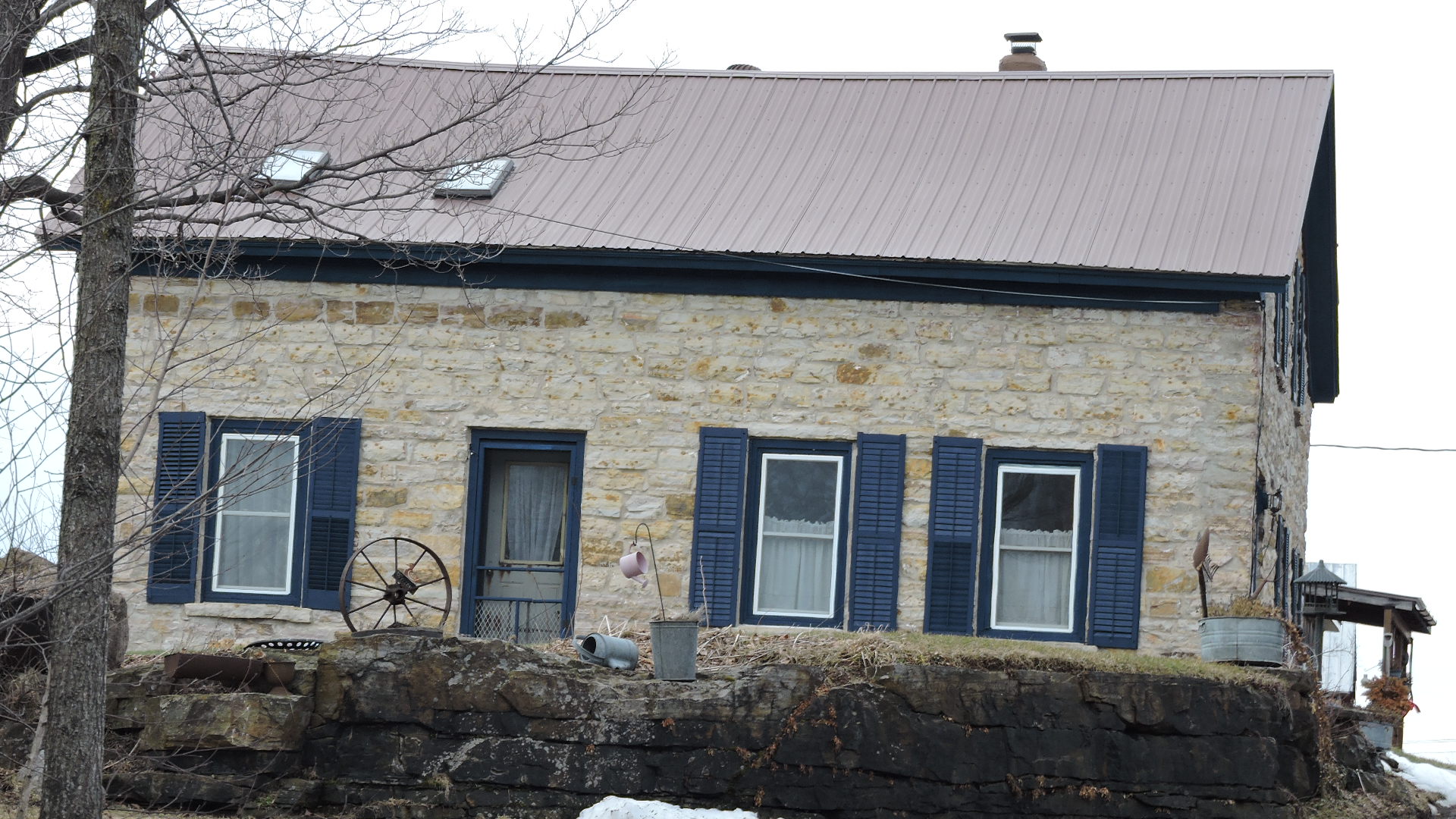
About a mile from the village of Theresa on the Theresa-Philadelphia road, which was early known as the Friends' Settlement or Quaker Settlement road, stands the old Sylvester Bodman house. It is a quaint low house of the simplest type and is situated on the north side of the highway. Native limestone procured nearby was used in its construction and never has its ownership been outside of the Bodman family. Since October 4 1946 title to the house, barns and 315.08 acres of land, has been held by Attorney Edmund J Wager, retired Utica lawyer and grandson of Sylvester Bodman.
The Bodmans were among the earliest settlers of the town of Theresa and have always been prominent in its life from the coming of Sylvester 127 years ago until the present time. Named Theresa for James D LeRay's daughter who married the Marquis de Gouvello, the town was not set off from Alexandria, which had previously been named for LeRay's son, Alexander, until April 15 1841. And within its confines there had been practically no settlement prior to that started by LeRay himself in 1817.
It was in 1820 that Sylvester Bodman, born at Williamsburg, Massachusetts, about 1781 brought his family to the Theresa area. On February 10 1810 he had married Martin Burt's daughter, Relief, from Northampton and five of their children were born in Williamsburg. An ox-cart carried most of Sylvester's family and belongings, but Mrs Bodman rode the horse and carried the baby in a basket strapped to the saddle. At first they lived in a log cabin and the stone house was probably not built until 109 or 110 years ago, shortly after Sylvester Bodman purchased his first parcel of land in Jefferson County That was 50 acres on November 5 1837 where the house is and was bought of the Antwerp company. Sylvester Bodman bought 65.18 adjoining acres from the Antwerp company November 27 1839. He had long been one of the leading men of the community and when the First Presbyterian church of Theresa was organized May 8 1825 he was one of its founders and first elders.
On October 14 1859 Sylvester Bodman died aged 78 but his widow, who was born February 22 1782 survived for many years to die at 104. Children of Sylvester Bodman when he died were Miranda, Martin B and Atwood of Theresa, Sophronia Bodman Wager, wife of David J Wager of Philadelphia and Sylvester Bodman Jr, of Edwards. Under the provisions of Sylvester's will, executed January 5 1859 the stone house and 115.18 acres went to his son, Martin Burt Bodman, who greatly extended his lands by buying 63.55 acres from John LaFarge February 13 1844; 63.49 acres from John LaFarge February 26 1851 and 72.86 acres from Patrick Farrell December 9 1874.
On June 30 1886 Martin B Bodman conveyed this farm to his wife, Ada E Bodman, and children, Mary A Bodman, Miranda A Bodman, Ada Susan Bodman and Relief B Bodman. On April 1 1904 Ann E Bodman deeded her one-fourth interest to her three daughters and June 10 1922 Mary A Bodman Holkins conveyed her interest to her remaining sisters, Miranda A and Ada Susan of Philadelphia. The latter died May 15 1945 and willed her interest to her sister, Miranda, who passed away July 9 1946 leaving it jointly to two cousins, Edmund J Wager of Utica, and William Francis Burt of Bronxville. On October 4 1946 Mr Burt transferred his interest to Mr Wager.
Born at Philadelphia October 10 1859 Attorney Wager was the son of David J Wager who was one of the organizers of the Republican party in Philadelphia in February 1855. Later David J Wager was an assemblyman and special county judge. His wife was Sophronia Bodman born January 1 1818 in Williamsburg and his father was Joseph Wager one of the first supervisors of LeRay
This native limestone house owned by Mrs Frank J LeRue and her son, Leslie, on the Dutch Point road near the Barracks club in the town of Cape Vincent is an almost exact duplicate of the Fred Smith house which lies back of it on the Wilson's Bay road. In fact there is a neighborhood tradition that both of these limestone houses as well as that of Mrs Jean G Shick were constructed by Ignatious Wiley, a young stonemason who came to this country from Germany in 1832 and settled near Rosiere.
Wiley built many stone houses in the town of Cape Vincent, but the LaRue and Smith houses differ in type from the others which he constructed. County records would seem to indicate that the LaRue house was built about 1831 by James Homan who purchased 124.11 acres of land there from Vincent LeRay December 14 1830. Little is known about Homan, whose first purchase of land in the county was in a nearby section of Cape Vincent March 6 1827. In any event he and his wife, Chloe, sold this property for $800 to Victor Wilson April 3 1839 who later sold 20 acres of the land to William Piersons, leaving the 104.11 acres remaining today.
Victor and Margaret Wilson disposed of the place April 22 1874 to Henry Shaw for $5,000 and there is a tradition that it was Wilson and not Homan who built the stone house. But Shaw, a native of Saratoga, died December 12 of the same year he purchased the property and his will recorded January 9 1875 gave his widow, Sally Ann Gardner Shaw, a life use and then devised it to his two sons, Albert D and David F Shaw. The latter died August 21 1880 and January 1 1881 Albert D Shaw, then United States consul at Manchester, England, sold his interest to his brothers' sons, George E, Charles A and Frank H Shaw of Cape Vincent.
Colonel Shaw was born December 27 1841 in the town of Lyme before the town of Cape Vincent was set off from it. He was graduated from Union academy of Belleville and from St. Lawrence university, enlisting immediately in Company A, 35th NY Volunteer Infantry in 1861 and serving two years at the front before being appointed special agent of the provost marshal's office in this city.
A Republican and possessed of superb oratorical talents he was elected to the state assembly in 1866 was appointed colonel of the 36th New York National Guard by Gov. Reuben E Fenton, who was then in office, and in 1868 was made United States consul to Toronto, where he so distinguished himself that President Hayes made him consul to Manchester, England, in 1878. There he served until 1885 when President Cleveland chose a Democrat to succeed him. Later he became commander of the Grand Army of the Republic in New York state and in 1899 was made national commander-in-chief of the GAR
In 1900 he was elected Congressman from this district, but died suddenly on February 10 1901. He was one of the prominent men of his time in the North Country. Eventually the stone house and farm on the Dutch Point or Mud Creek Bay road was disposed of by the Shaw family to William H and Benjamin Florence and March 1 1916 William H individually and as only heir and next of kin of Benjamin Florence, joined with Addie, wife of William, in selling the place to Frank J LaRue.
He remodeled the house the next year. It consists of six rooms downstairs, three bedrooms, a hall and clothes closets upstairs, and it is maintained in excellent condition.
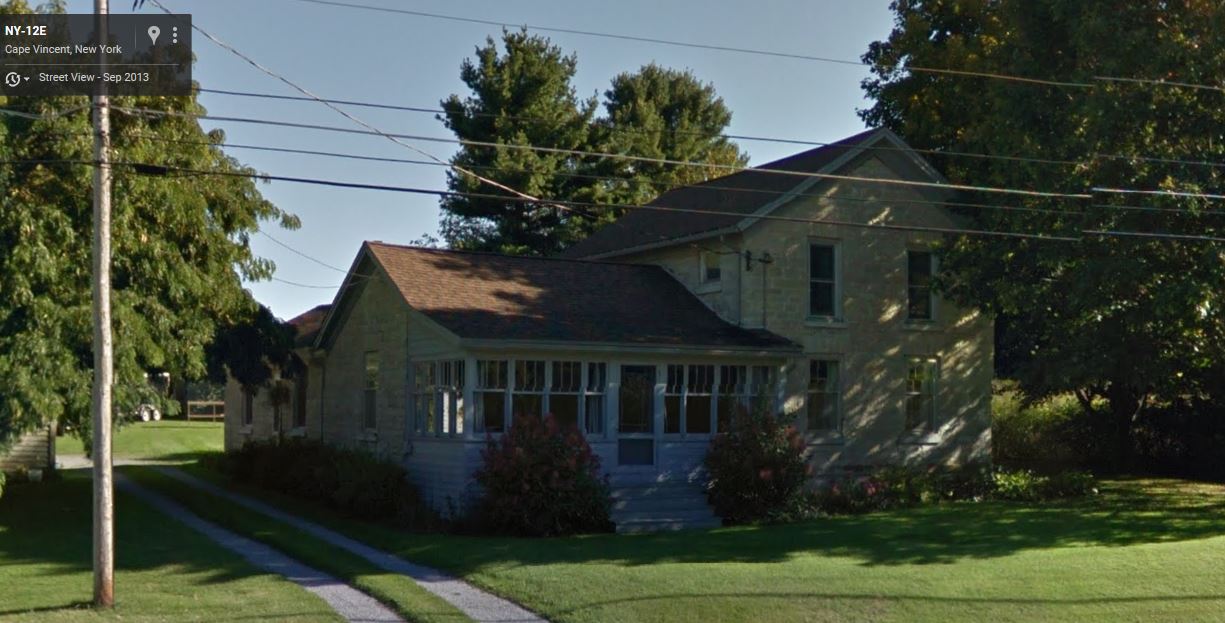
Built on the south side of the highway that runs from Cape Vincent through
Millen's Bay to Clayton this house of native limestone has no touch of
Georgian or Colonial in its type. It is believed to have been built at
least 90 years ago, although it may be older than that, in which case
it has probably undergone extensive modernization. The verandah is unquestionably
a comparatively modern addition.
If more than 92 years old the house was probably built by David Dodge,
one of the early settlers of the town of Cape Vincent long before it was
set off from the town of Lyme. If erected after 1854 it was doubtless
constructed by his son, Frederick H Dodge, for on October 28 of that year
David Dodge and his wife, Louisa, conveyed to Frederick the 51.25 acres
upon which the house stands for $1 and "natural love and affection"
David Dodge was buying land in what is now the Cape Vincent part of the original town of Lyme as early as 120 years ago, and on April 22 1829 purchased 81.1 acres beginning at the north corner of Butterfield bay in the locale of this house. This purchase was made from Count Pierre Francois Real of Paris, France, former perfect of police under Napoleon. Real was one of the leaders of that group of Napoleonic refugees who bought land and located near Cape Vincent after the French disaster at Waterloo. It was he who built the Cup-and-Saucer house at the Cape and is accredited with having formulated a plan of bringing Napoleon from St. Helena to reside there.
Thomas Dodge, a native of Block Island, RI, who settled in Cape Vincent in 1813 and died there in 1831 at 64 was followed to the present town of Cape Vincent in 1817 by his son, David, who had been born at Block Island in 1795. The latter died at his home near Millen's Bay in January, 1879 at the age of 84.
David Dodge married Louisa, daughter of Tyler Barrett of Long Island, and resided on the homestead farm which adjoined that of his son, Frederick. In his will David gave the homestead farm to his son, Orlando D, but provided that Louisa should have a room to occupy there as long as she lived, $200 a year to be paid by Orlando who was also to provide her with food and warmth, and a milch cow, which was to be replaced by Orlando as often as necessity required.
Frederick H Dodge, married Harriet, daughter of Justus Felt of Clayton. He died November 3 1907 willing this house and 51.25 acres of land as well as all personal property to his only son, Benjamin D Dodge, onetime proprietor of the Riverside hotel at Millen's Bay. On November 23 1932 Benjamin D Dodge and wife, Adelaide, then of Pasadena, California, sold this property to Claude S and Mary Saunders Lewis of Richmond Hill, NY. They in turn disposed of it November 27 1934 to Charles H Crusoe of the town of Cape Vincent and on June 10 1935 he sold to Floyd B and Mary E Clark of the town of Clayton. All down through the years from the time David Dodge and wife gave the place to their son, Frederick H Dodge, there has been no alteration in the acreage. The house, which consists of eight rooms, is up-to date in all of its conveniences. It is about seven miles from the village of Clayton.
Framed by a huge willow and a large limb, which sweeps majestically across the whole broad front, the Adam Bowhall house, about five miles out the Martin Street road in the town of Champion, has a most picturesque setting. Although the front porch is a more recent addition, the house, constructed of native limestone is of simple and pleasing type. It was probably built by Adam Bowhall, one of Jefferson County's earliest settlers, between 130 and 135 years ago, he having bought 147.25 acres of land there from Storrs & Champion March 8 1811.
Adam Bowhall or Bohall, the name being spelled both ways in county records, was one of the very first pioneers of Lewis county. In 1804 he came into the township of Champion from Lowville and within the next seven years began buying land. On February 25 1850 he and his wife Margaret sold 119.24 acres, which is the bulk of the farm as it stands today to Isaac A Bowhall of the same township for $2,500. At the end of three years Isaac A Bowhall and wife, Susan A, conveyed the property to Seth Hastings tor the same price.
Hastings was the son of John Hastings, of Massachusetts, also a pioneer settler of the town of Champion.Seth Hastings became intimately identified with the Bowhall family through having married Elmira, daughter of Adam and Margaret Bowhall. Mrs Bowhall, it might be explained, was Miss Margaret Vandewalker prior to her marriage.
The farm was expanded on March 1 1866 when Seth Hastings purchased 50 adjoining acres from William and Elizabeth Perkins and this parcel continues to be part of the property today.
When Seth Hastings died the farm with its old stone house and barns was inherited by his daughter Emogene M, wife of Morris Miller, and on January 6 1894 she sold it to her brother, John Emenel Hastings. He retained possession of it until February 10 1912 when he and his wife, who was Charity A Clark, daughter of Tabor Clark before her marriage, disposed of the place to the present owners, Mr and Mrs George S Putnam, well known Champion residents.
The record accordingly shows that this farm was owned for Acentury by the Bowhall-Hastings family, a record which, of itself, is worthy of some note. The house is one of two limestone ones standing on Martin Street, a road which branches out from the Watertown-Carthage state highway at Great Bend to run through the town of Champion to the village of West Carthage. The road got its name from Captain Martin and family who located there early in the last century. There were several members of the Bowhall family also, who resided in this area of the Martin Street road. Adam Bowhall and his wife, Margaret, were the parents of 12 children, one of whom was Isaac A, to whom he sold this farm in 1850.
(now a parking lot...)
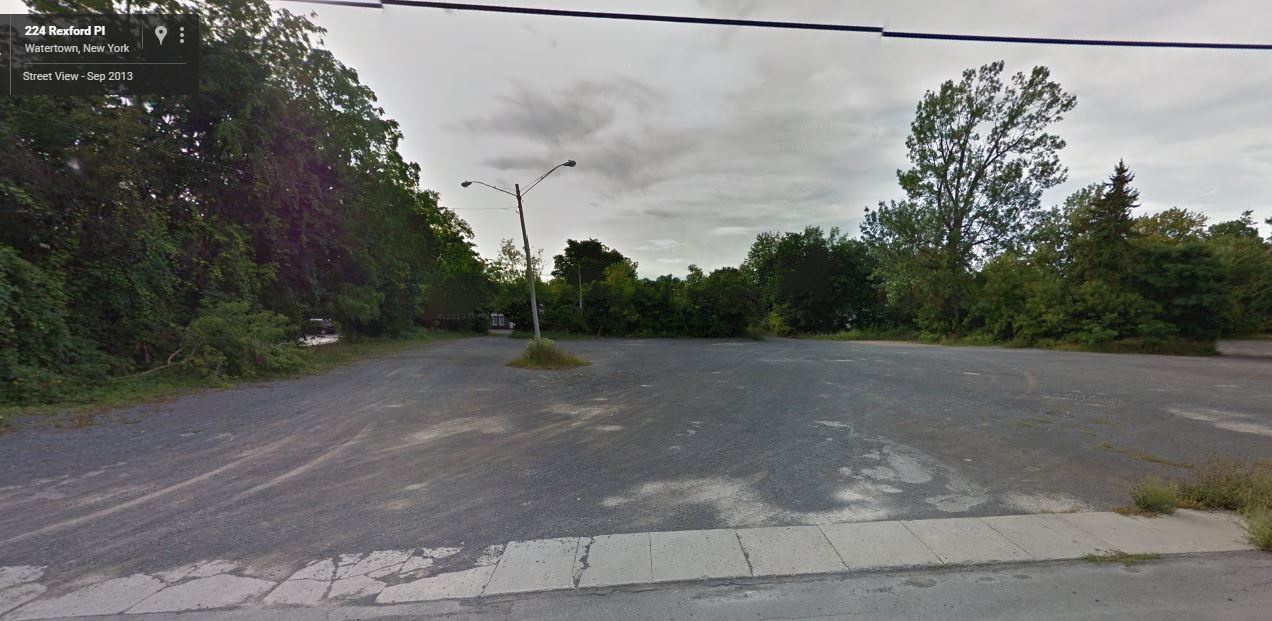
If history is correct this brick house at 224 Rexford place, formerly Massey avenue, built by Hart Massey, one of Watertown's first three settlers, is probably Watertown's oldest dwellings. Several descendants of Hart Massey are still living here and elsewhere and no family has been more prominent nor played a more important part in the life of the community down through the decades.
Born at Salem, New Hampshire, December 5 1771 Hart Massey was the son of Lieutenant Jonathan Massey, Revolutionary war veteran who served at Bunker Hill, saw the capture of Burgoyne, died in Watertown March 30 1830 and is buried in the Arsenal Street cemetery.
Watertown was begun in the Virgin forest by his son, Hart, Henry Coffeen and Zachariah Butterfield in the early spring of 1800 Massey buying 90 acres of land on the west side of lower Washington Street, soon adding 100 acres to it, bringing his family here in 1801 and first residing in a log cabin about where the Paddock arcade entrance is. His wife was the former Lucy Swain of Reading, Massachusetts, and after they had been here a few years Hart built a frame house on the approximate site of the Jefferson County Historical society museum. By 1812 his circumstances warranted a more pretentious house and he erected this large brick residence on Rexford Place, first brick house in the county, and in it his father died.
Hart Massey was a Quaker and the first religious service in the town
was held in his cabin after his family arrived in 1801. Early he became
quartermaster in Colonel Abijah Putnam's militia regiment.
He was adjutant to Colonel Gershom Tuttle and on July 13 1808 he was made
colonel and inspector of state troops. He was deputy collector of the
county when it was a part of Oneida county, was collector of customs at
Sackets Harbor during the War of 1812 and was made judge of common pleas
in 1820. He died March 20 1853 and on May 28 1856 the heirs of him
and his wife quitclaimed their interest in the entire estate including
this brick residence to his son, Edward Swain Massey, first white child
born in the town, Commission merchant and first coal dealer in Watertown.
Edward Swain and Esther Boalt Massey conveyed that part of the property which included the brick house to Solon Massey, another son of Hart Massey, and author of "A Link in the Chain," title of his biographies of early Watertown settlers. This conveyance was on July 23 1856 and November 20 1865 Solon Massey sold the place to Dr William Penn Massey, physician and son of Solon.
Dr William Penn Massey died May 22 1885 having been president of the Jefferson County Historical society and a leading physician. Six days later his children conveyed their interest in all of his property to their mother, Mrs Adeline A Massey, but on April 13 1893 one of the sons, Francis William Herbert Massey who had inherited this house among other things under his mother's will recorded June 6 1891 sold the place to Milo L Cleveland. Mr Cleveland sold it to John C Knowlton June 1 1896 and the next day Mr Knowlton conveyed to the Bureau of Charities and Correction of Watertown. For many years it was used as a detention house by that society, which disposed of the property to Mrs Carrie L Newcomb July 17 1939. Mrs Newcomb sold it to Nerses H Malitesian September 16 1940 and it is now an apartment house
House is gone...only the small addition remains
Jean Louis Philippe Galband du Fort, a native of Brittany France, Chevalier des Ordes Royales et Militaires de la Legion d'Honneur, and of St. Louis de Baviere, fled to the United States and settled in the town of Cape Vincent when it was known that Joseph Bonaparte was coming to this country. His wife was Mme. Emerance de l'lsle du Dreneuf and they were the maternal grandparents of Count Hermel Gustave Marie deSallier du Pin, who was United States consul to Brittany under President Benjamin Harrison's administration and who served as clerk of Jefferson County surrogate's court from 1896 until his death September 22 1913.
Count deSallier came to this country from France as a young man of 21 in 1869 to reside with his maternal Grandmother duFort in the little limestone house on the Pleasant Valley road about three miles from the village of Cape Vincent shown herewith. He was married in 1879 to Miss Emily Binsse de St. Victor, daughter of Dr and Mrs John Binsse of this city. Dr Binsse was the brother-in-law and land agent of John La Farge. wealthy French merchant who bought extensive land tracts in this county, established the village of LaFargeville and erected an imposing mansion there.
Count and Mme. deSallier were the parents of a daughter, Emerance, and a son, Rene. From 1869 to 1891 Count deSallier resided in the little stone house on the 288.06-acre farm on the Pleasant Valley road. After the termination of his counsellorship in Brittany he resided in a small house in this city at the corner of Clinton and Sherman Streets where the S A Upham garden now is.
On August 17 1904 Cardinal Farley came from New York to Clayton to solemnize the marriage of Emerance to Thomas Hughes Kelly, New York millionaire and a papal chamberlain who held many high honors in the Catholic church.
Rene deSallier went to France in May, 1919 as a member of the Mission Americain de Rapprochement and later became identified with the Copper Export association in Paris. He, his sister, Emerance, their mother and Mr Kelly all died in Paris.
As for the quaint little limestone house on the Pleasant Valley road,
it was probably built by James Homan, an extensive landowner in the town
of Cape Vincent upwards of 110 years ago. The four parcels of land which
make up the farm were purchased by Homan from Vincent LeRay de Chaumont.
The first parcel of 200 acres was bought March 16 1827. On February 24 1836 35.86 acres were obtained and on March 5 1838 two parcels of 26.41 acres
and 25.79 acres. Not until December 9 1850 did James and Chloe Homan convey
this stone house and 288.06 acres of land to Jean
Louis Philippe Galband duFort, who died January 30 1855 willing all of
his property to his widow. She died September 28 1878 and willed all of
her real estate to her two grandsons, Joseph deSallier du Pin, France,
and Hermel, Cape Vincent. Hermel eventually became the sole owner.
On January 10 1919 Count Hermel Gustave Marie deSallier du Pin's widow, Mme. Emily V deSallier du Pin, city, who inherited this place, from him, disposed of it to Amos C Favret and wife, Alma E Favret, the present owners. Mr and Mrs Favret are also members of prominent town of Cape Vincent families. They reside in the village of Cape Vincent and their son, Claude Z Favret, operates the farm, but the old house today is but a wing to a much larger frame dwelling, constructed several decades after it was built. Amos C Favret, a past master of the Cape Vincent grange, was married to Miss Alma E Zimmerman April 1 1907 and last spring they celebrated their 40th wedding anniversary. Mr Favret was the son of Claude and Gertrude Constance Favret. Mrs Favret was the daughter of George and Mary Vautrin Zimmerman.
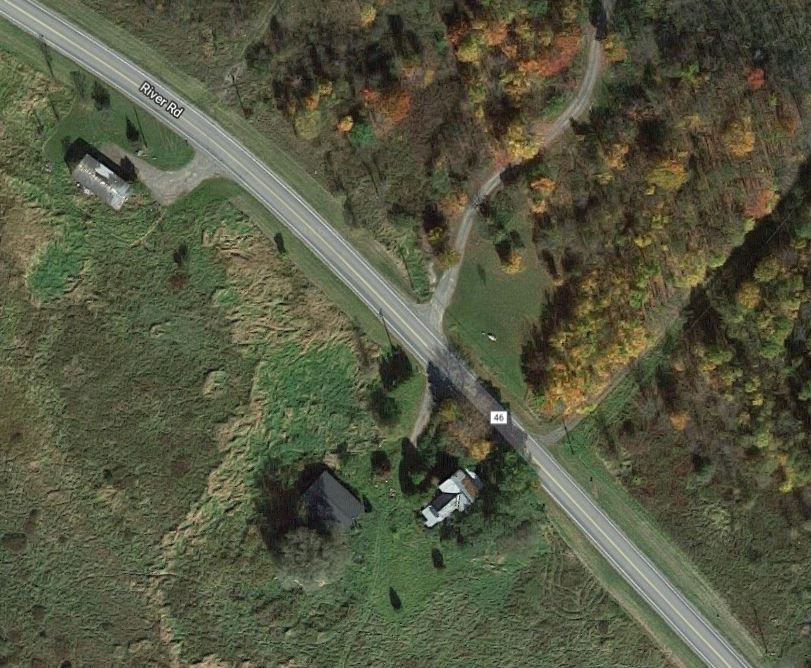
NOTE: The James Shurtleff House is located on the River
Road (Co. Rt. 46), about .3 miles from the
Douglas Crossing Road and is on the Indian River (lot No. 166). Modern
photo needed
The legend is that about 1821 this native stone house was built by James Shurtleff, a native of Plympton, Massachusetts, one of the first settlers of what is now the town of Theresa. The house, which is picturesque and occupied by William E Smith who owns it jointly with his father, William C Smith, well known Theresa farmer, is located south of the Indian river a little over a mile from Theresa village on the road which leads from Theresa through Kelsey Bridge to Evans Mills.
Included in this 223.23-acre farm is the 100-acre tract which James D LeRay de Chaumont caused to be cleared in 1811 to pasture 500 head of sheep, 60 head of cattle and 20 horses, which were tended by Captain John Hoover and John A Evans. And history has it that during the War of 1812 Hoover discovered five British soldiers skulking about the barn on an espionage mission and captured two of them single-handed.
Impressed with the water power at High Falls (Theresa ) LeRay, who had built several mills there, established a land-office less than a half mile from this house and in 1818 caused Musgrove Evans to survey and subdivide a 1000 acre tract for a village named for his daughter Theresa, wife of the Marquis de Gouvello. James Shurtleff came on in 1817 and March 13 1819 purchased 161.45 acres which embraced the 100-acre LeRay pasture and became the first part of this 223.23-acre farm. The stone house is said to have been erected about two years later and first used by Shurtleff as an inn.
There Nathan M Flower, father of Roswell P and Anson B Flower, spent his first night when he came up from the Cherry Valley in 1822 to establish a fulling mill at Theresa. On August 1 1816 James Shurtleff died at Plessis aged 79 and the Shields county map of 1855 shows Jesse Kelsey established at this Shurtleff farm. On February 3 1806 the town of LeRay was formed and March 3 1807 James Shurtleff was made its first supervisor serving until 1815. Alexandria town was established August 3 1821 and Shurtleff became its first supervisor The town of Theresa was formed August 15 1841 but long before that the Theresa Presbyterian church had been organized with Shurtleff as one of its founders.
Jesse Kelsey married James Shurtleff's daughter, Susan Ann, and likely succeeded to the ownership of the stone house and farm although the title is hazy from the time of Shurtleff's death until John Pettit Douglass acquired it from Gilderoy Lord November 1 1886 to make it part of his 3,000 acres of rich farmlands in the county.
Douglass, a native of Pillar Point, school teacher and school superintendent in Jefferson County, engaged in the mercantile business in Watertown at 27 but shortly formed the produce firm of Douglass & Noble with Curtis Noble in New York City, prospering for 25 years and becoming an alderman in Brooklyn's eleventh ward in 1871. In 1854 he had married Henrietta Hughson of Pulaski. When his health failed, he returned to this county and settled in Theresa, becoming a founder and first president of the former Watertown Standard March 21 1894. He died September 20 1903. Under his will all of his property went to his widow, who sold this stone house and and farm to William J Tilley December 10 1904.
Tilley, native of Swansea, Wales, was a farmer and cheese maker who looked after the factories of Douglass, Madison Cooper and others. He was a charter member of the Plessis grange, a trustee of both the Plessis and Theresa Methodist churches and willed them substantial sums when he died in 1931.
His son, Walter W Tilley succeeded to the ownership of this place and improved the house in 1939. The latter Mr Tilley, who became postmaster of Theresa in 1924 and was long prominent as a farmer, was married to Miss Ethel Smith of DeRuyter February 2 1910. For the greater part of 42 years she was a Theresa High school teacher, retiring in May, 1946.
The Federal Land Bank acquired the farm from them May 24 1941 and February 1 1946 sold it to William E and William C Smith.
Clark's hill (This is the HADCOCK RD now) and its Ridge road which runs parallel and to the north of the Rutland Hollow road is one of the most sightly spots in Jefferson County. Upon it also stand some of the finest old houses. From their high location a beautiful vista unfolds with the village of Black River and the Black River valley beneath and the orderly rows of Pine Camp barracks beyond.
The hill is in the township of Rutland and to this area of the township there came five brothers, Asa, Elisha, Elias, Archibald and Lewis Clark from Halifax, Vermont, in the very first years of the 19th century. Two beautiful Clark houses stand there today as testimony to their coming.
Upon the south side of the Ridge road is the stately limestone mansion with the tall white pillars owned by Alanson B Wilson. Ground for it was broken for Asa and Betsey Dalrymple Clark May 1 1834. Across from it on the north side of the road is the most attractive and dignified red brick house owned by Leonard R and Eleanor L Reed and shown above. Some say it was built for Asa Clark Jr, in 1843 but county records seem to indicate that it may have been erected before the stone house and for Elias rather than Asa Clark.
With this red brick Georgian house is a farm of 130.49 acres comprised of three parcels, one of 56.07 acres, one of 19.5 acres and one of 57.5 acres minus 2.58 acres.
Elias Clark and wife, Lephe, sold the farm consisting of the first two of these adjoining parcels to Asa Clark on March 3 1827 for $1,439 and the price would imply that a house was standing there then. On August 5 1836 Asa and Betsey Clark sold the place to their son, Asa Clark Jr, for $1,000 and on March 2 1863 he conveyed it to his son, Asa Dalrymple Clark for $3,400 which price may mean that the brick house was not built until 1843 as Clark family tradition has it and that a log cabin or possibly a frame house stood there when Elias Clark sold the place.
Adjoining on the west was the old Trustrim Frink farm of 57.5 acres which was sold to Aaron Dexter by Trustrim's executor, Samuel Frink, April 16 1866 and on November 7 1867 Asa D Clark acquired it from Aaron and Hester Dexter, to add to his farm. On December 15 1867 Asa D and Mary A Clark sold 2.58 acres off this parcel to Asa Clark for $1,200. It included the Frink house and, August 3 1878 Asa and Betsey Clark disposed of that small piece to Melvin L Reniff.
Asa D Clark made his will October 4 1869 empowering his father to sell
his real estate and died 18 days later on October 22. Accordingly Asa Clark
disposed of the brick house and its 130.49 acres of land November 29 1869
to Leonard H Loomis for $8,481.85 The property remained in the Loomis
family until October 29 1900 when Attorney Curtis L Hildreth as referee
in a mortgage foreclosure action brought by Christopher P Clark, brother
of Asa D Clark, against the Loomis heirs, sold it to George H and Charles
A Hadley. On April 25 1904 Charles A and Ruth W Hadley conveyed
their interest to George H Hadley and October 11 1907 George H and Jennie
B Hadley deeded this farm to Elizabeth Lewis Hadley of Oak Ridge, VA.
She and her husband, Albert S Hadley, disposed of it to Fred A Huntley
of the town of Fowler September 27 1915. Mr Huntley and wife, Stella,
sold to Arthur and Margaret Endsor of the town of Watertown November 1
1922 and they owned it until July 16 1945 when the present owners, Mr
and Mrs Reed bought it.
It should be noted that Asa Clark Jr, who purchased this farm in 1836 was supervisor of the town of Rutland in 1848 1849 and 1863 and that he was often called upon to decide neighborhood disputes.
Nothing embellishes and lends attraction to a house like a beautiful doorway. Many are the old, as well as the new houses in the North Country which have such doorways. Nevertheless, there are not a few that have been spoiled. In many instances this spoiling is only temporary and is brought about by hiding them with cheap, unsightly screen or storm doors or by boarding up completely. There are other cases of a more permanent nature where the fine old, original doors have been replaced by unlovely ones of modern manufacture. And in numerous instances panels have been cut out of the beautiful old doors to make room for glass in order that more light may be let into a hallway.
An example of a beautiful old doorway that has been kept original is that in the Elias Clark red brick house of late Georgian design which is owned by Mr and Mrs Leonard R Reed on Clark's hill in the extreme northern part of the town of Rutland.
The house is over a century old. Possibly it is as much as 120 years since it was constructed, and the door and doorway show every evidence of being the same as when the house was erected.
The entrance here is of the rectangular type. There is no light over the door, but on either side is a generous sidelight with its panes of glass crafted also in rectangular patterns. These sidelights are separated from the door itself by fluted rectangular pilasters.
It is a plain and simple doorway placed squarely in the middle of the house facade, and the door which opens into the central hall is extremely beautiful and alluring.
This white door is fashioned with a double cross, created by an inset of eight panels, four of which are in the upper part and the other four In the lower section. Two small panels top the upper section, and underneath them are two long panels. The lower part has two small panels at the top with two square, panels below them.
Containing 15 rooms, the house still has its fine, simple first woodwork and doors inside. Upon some of these inside doors, particularly on the second floor, are the old, original iron latches. Some alterations and installations have been made by owners of the present century. The original twelve-paned windows have long since given way to the large-paned windows of modern times. This change detracts from the beauty which existed when the house was constructed and is a change, which is unfortunately to be found in the majority of the old dwellings of this and adjoining counties.
The caps to the front door and to the windows of this Clark house are made of the same kind of brick to be found in the exterior walls. These caps are made by slanting the brick in on an approach to the vertical The house stands upon a native limestone foundation, and there is a limestone water-table and front steps. Taken altogether, the house is still one of the most interesting to be found in this North Country
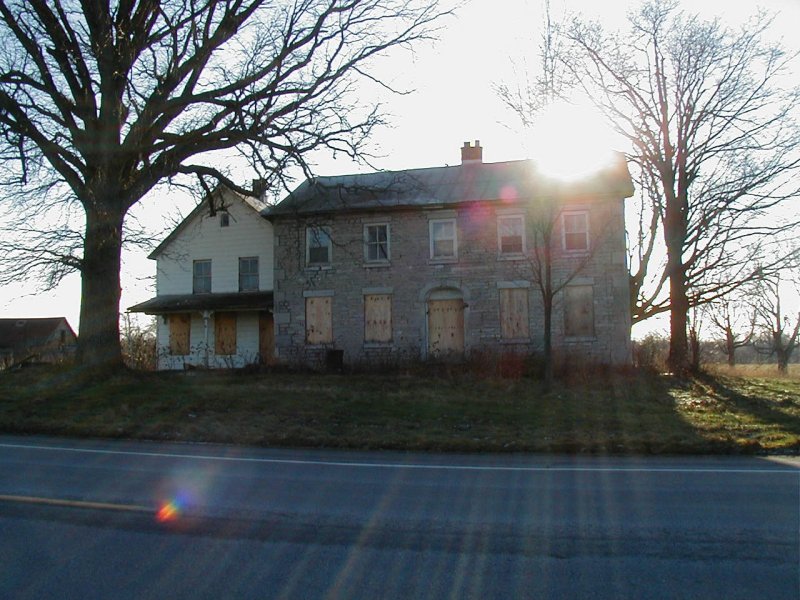
It is said that this Georgian house of native, limestone, attractive in
design with its arched and fanlighled central doorway, was built by James
Ward in 1829
James Ward, who was born in New York City August 8 1801 was descended from an old Northamptonshire family in England. His father, Thomas Ward, who was born January18 1776 in Kettering, England, came to this country as a member of a surveying party in 1802. This party was headed by General Jacob Brown and Thomas Ward became one of the first settlers of the town of LeRay. On October 24 1808 he purchased 110.25 acres from James LeRay in the area of this house.
At the first town meeting March 3 1806 he was elected clerk, was a school commissioner in 1813 served as a corporal in the War of 1812, was a justice of the peace and kept a general store. He died about 1830
James Ward, who married Lovina Barber April 25 1825 eventually became a real estate broker and money-lender accumulating a fortune estimated at about $70,000 at the time of his death September 5 1880. He was the father of several children, one of whom was Buel F Ward who succeeded him in the occupancy of this farm when he removed to Carthage about 1863 to spend the last 17 years of his life. Buel F Ward was the father of Mrs Minnie Ward Kellogg of New York City, former wife of the late Virgil Kellogg.
A recorded deed shows that on February 10 1870 James and Lovina Ward, Carthage, sold this house and farm of about 220 acres to Joseph V and Almira Bichel, who in turn disposed of it to Roxie A Ward September 21 1877. The property remained in the possession of the latter for a period of 33 years and on October 18 1910 Roxie A Ward sold it to Peter D and Della J Helmer for $11,000 for 25 years the Helmers retained it, Mrs Helmer selling it to Edward and Dorothy Buskirk on May 17 1935. About three years ago Ernest Welser, the present owner, purchased the place from Mr and Mrs Buskirk, and operates the farm.
Roxee A Ward was the wfle of Buel K Ward and prior to her marriage to him in 1860 was Miss Roxee A Weichard. They were residents of Carthage in their latter years as Mr Ward's parents had been before him and they were the parents of Mrs Minnie L Kellogg who for a number of years was connected with the Syracuse Public library staff; Caroline F Ward and Emma H Ward of New York; Dr Arthur G Ward of Albany, Brayton G Ward of Carthage; Carleton E Ward of Hemlock, Oregon, and Ruth L Ward of Newark, N J. Buel F Ward died in Carthage April 25 1915 at an advanced age. The Ward family stood high among the citizens of this county and several of its members were prominent along educational lines. The pioneer Thomas Ward and his family experienced all of the vicissitudes of primitive life such as the first settlers met in this virgin northern wilderness of a century and a half ago. It is related that James D LeRay de Chaumont gave Thomas Ward's wife, Polly Leishman Ward, an apple from a tree which he had brought from France, and from the seed of this apple she grew another tree. Ann, a daughter of Thomas and Polly Ward, was married lo William Taggart, another early settler of LeRay
This house is at Ward's Corners on the Evans Mills-LeRaysville road.
The town of Champion was set off from Mexico, March 14 1800 and beginning about 140 years ago the village of Great Bend on the road from Watertown to Carthage started an industrial career which was prominent for many years. A dam was thrown across the river and a mill built for Olney Pearce and Egbert TenEyck in 1807. From that time on the community grew and in February 1868 the Great Bend Paper company was organized, establishing an important industry there
But ten years before that John Hubbell Woolworlh, a Rodman farmer, had moved there with his wife and two small sons to take up another farm. One of those sons was Frank Winfield Woolworth, who was born April 13 1852 and later became known as the founder of the FW Woolworth company operating a chain of goods exchanging a myriad variety of small goods for the public's nickels and dimes. The other son was Charles Sumner Woolworth, who was born August 1 1856 and who joined his elder brother in the giant merchandising enterprise.
Frank Winfield Woolworth died at Glen Cove, Long Island, April 8 1919. Charles Sumner Woolworth passed away at Scranton Pennsylvania at the age of 90 on January 7 of this year. Frank W Woolworth got his five and ten cent store idea as a clerk in the Moore & Smith store and after a year joined his brother, opening a store in Harrisburg PA.
Both Woolworth brothers got the foundation of their education in the little school house of native limestone just above the picturesque red brick Woolworth Memorial Methodist church in Great Bend on the road leading from that village to the village of Champion
Some say this schoolhouse was built in 1818. It is mentioned in a deed of half an acre sold by Nathan P Johnson October 15 1827 to the First Baptist Ecclesiastical society of Champion which built a church adjoining but it was not until the fall of 1873 that it ceased to be used for school purposes, the trustees of School District No 9 town of Champion, having bought a site across the street from Edwin Carter June 3 1873 and erected a new school in which, although unfinished, the board held a meeting October 14 of that year, records of Clinton B Dodge show. Incidentally Mr Dodge's oldest brother, Oliver F Dodge who became foreman of the Great Bend Paper company also attended the old stone school.
After 1874 the little schoolhouse was converted into a dwelling and down to the present time has had an extremely large number of owners. About 50 years ago it was acquired by Mrs Esther M Sisson, wife of Almeron Sisson, who was a son of William Sisson, native of Herkimer county, who located at Great Bend in 1868 dealt extensively in lumber of the Pacific coast and was murdered 125 miles from Vancouver in 1886
Mrs Sisson sold the stone house property to Nettie Spidell December 25 1899 and she conveyed to W W Olds November 6 1905. He sold to James W Barnes November 5 1909 Barnes sold to the Taggarts Paper company seven days later and November 30 1911 the company deeded to Thomas N Stewart who conveyed to Raymond L Call September 7 1920. Mr and Mrs Call sold to Fred J Barkley August 13 1930 and December 28 1931 the place passed in life use 1930 and December 28 1931 the place passed in life use to his widow, Myra, by will, and then to their daughter, Mildred M Pennock, who sold to Darius K Briggs January 30 1936. Mr Briggs, well known Great Bend miller, sold to Mrs Mildred Hammill, present owner, May 7 1943
Dormer windows and an enclosed porch have been added in recent years, and modestly, unheralded, unsung and almost unnoticed, the little building stands a stone's throw from the beautiful Woolworth Memorial church, when commands all of the attention but is much less historic
Claimed to be the oldest house in Lewis county, construction of the original part of this early Colonial-type dwelling is said to have been started by Giles Foster, Revolutionary war veteran and pioneer settler of the town of Turin, in May 1799 at the one-time hamlet of Deweyville on the East road and barely beyond the limits of Turin village.
With his wife, Fanny, a half dozen of their children and his aged father Timothy, Giles Foster had made his laborious way up from Meriden, Connecticut, to occupy the land he had purchased from Judah Barnes. Upon the framework of big hand-hewn timbers of this house plank siding was nailed and covered with clapboards. Giles had one time intended to make a tavern of the place but never did so. In 1821 his wife died and nine years later he sent for his son, Reverend Sylvester Foster of Islip, Long Island, to come and live with him. The Erie canal was not operating and the bulk of the trip was made by horse and wagon. Shortly after Sylvester's arrival Giles married a widow from Turin and an addition was built on the north end of the house which accounts for the two identical front entrances.
All of the original interior hardware including H and L hinges and spade latches are on the doors. The herd of cattle, finest in Lewis county, are all descended from the original cow bought about 1881. Giles' second marriage was not a success and it was not long before his wife moved back to Turin. Then doors were cut to connect the addition with the main house. Giles Foster died January 1 1844 aged 87. Reverend Sylvester Foster lived on in the house to die at 81 in 1861 and his widow, Abigail, continued there until her death in 1874. Their daughter, Frances Charlotte Dewey, then took title to the place.
At the age of 16 Frances Charlotte Foster had married Cadwell Dewey on January 8 1835. Dewey, native of Franklin, NY, was 25 at the time, and a descendant of Thomas Dewey who had come from Sandwich, England to Dorchester, Massachusetts, in 1633. At 13 Cadwell had come to Turin to study medicine with his uncle, Dr Royal Dwight Dewey, whose grandmother, Anna Dwight Cadwell, was great aunt of President Timothy Dwight of Yale.
Cadwell Dewey disliked medicine and after a time went to Unadilla to learn cloth dressing and manufacture at Crooker & Williams' factory. He returned to Turin in 1831 formed a partnership with Lyman Lane, son of David and Elizabeth Ballard Lane, formerly of Suffield, Connecticut, and built a factory almost on the site of Turin's first grist mill erected by Giles Foster on Mill creek.
After the death of Mrs Abigail Foster, her daughter, Mrs Cadwell Dewey, took over this old Foster house and farm, bought more land, ran the farm with tenants and occupied the big Victorian house across the road. Cadwell Dewey died April 25 1882. but his widow lived until January 12 1920 to die at almost 102.
Her grandson William Hammond Dewey, native of New York and great-grandson of Giles Foster, bought the historic old house and farm in 1913. His uncle, Sylvester Foster Dewey, was deputy commissioner of public works and collector of assessments under Boss Tweed in New York but was not implicated in the Tweed political ring.
William Cadwell Dewey, father of William Hammond Dewey, was a wholesale grocer and produce merchant in New York. William Hammond Dewey attended Swarthmore college, was connected with the Rock Island railroad and later with the Lehigh Valley as supervisor of tracks. June 24 1896 he married Jennie C Blair of Turin. He was a Republican, supervisor, assessor and justice of the peace of the town of Turin. He was past master of Turin Lodge No. 184 F & A M, Lowville Chapter R A M, Batavia Commander and Damascus Temple, AAONMS. He died March 1 1945. His widow survives and occupies the Victorian house summers.
In 1924 his son, Paul Dewey, graduate of Syracuse university agricultural school, took over the management of the farm of 360 acres with 100 head of registered Holstein cattle, and with his wife, the former Miss Katherine Bowman, daughter of Attorney and Mrs Frank Bowman of Lowville, and two daughters, Helen Elizabeth and Susan Foster, resides in the fine old house. The marriage of Paul Dewey to the former Katherine Bowman took place May 7 1932.
Victorian though it may be the setting of this Cadwell Dewey house at Deweyville is one of beauty and contentment. It was in 1854 that Cadwell Dewey, a prosperous dresser and manufacturer of cloth, built it on the side of the Turin East road opposite the Giles Foster house. Guarded by an iron fence and gate it stands upon a high lawn back from the road, and tall evergreens, elms, other trees and shrubs contribute beauty to its environment. Luxury, dignity and comfort feature its high and spacious rooms.
Born October 5 1809 at Franklin, NY, son of Aaron and Betsey Vail Dewey, Cadwell Dewey was named for the family of his grandmother who was Sybil Cadwell of Westfield, Massachusetts, before she married Aaron Dewey, a veteran of Colonel John Mosely's company in the Revolutionary war. Thomas Dewey, the immigrant ancestor of Cadwell Dewey, was also the immigrant ancestor of Adm. George Dewey, hero of Manila Bay, and arrived at Salem, Massachusetts, in February, 1630 in the good ship Lyon from Bristol, England. Thomas Dewey first settled in Dorchester, Massachusetts, but later moved to Windsor, Connecticut. The trail of the Dewey family went from there to Westfield, Massachusetts. About 1800 Aaron Dewey, father of Cadwell, moved to Franklin, NY, and engaged in cloth-dressing and woolen manufacture, but lost heavily by fire and misplaced confidence in an associate.
Cadwell Dewey was only 13 when he went to Turin to study medicine with his uncle, Dr Royal Dwight Dewey. But Cadwell had no liking for that profession and after a few years went to Unadilla to learn cloth dressing and manufacture in the factory of Crooker & Williams. In 1831 he returned to Turin and engaged with Lyman Lane in the manufacture of woolens. They built a factory on Mill creek at Deweyville and January 8 1835 he married Frances Charlotte Foster, granddaughter of the pioneer, Giles Foster.
After their marriage they lived in a small house by the mill. Later Cadwell Dewey bought his partner out, doubled the mill capacity and bought a grist mill. A smithy and cobbler shop were opened, several houses and a store were built and Deweyville became a thriving hamlet. The woolen business prospered and in 1854 Dewey built the big Victorian house. There he lived with his wife and five sons until his death April 25 1882. But the cloth factory continued until 1914, Lafayette Kidder having been the last operator, and today teasels, used in finishing the cloth, still grow in the vicinity, while the factory foundations are yet visible.
Cadwell's widow, Frances, continued to reside in the big house and operate the Giles Foster farm across the road, which she had inherited from her father, Reverend Sylvester Foster, until she was left alone in 1913. Then she called her grandson, William Hammond Dewey, of Geneva, who was connected with the Lehigh Valley railroad, to come and live with her and buy the farm. He died March 1 1945.
His widow, the former Miss Jennie C Blair, whom he married June 24 1896 continues to own the great Victorian house and reside there summers with her daughter, Mrs Rowland C (Elizabeth) Massie of Wallingford Connecticut. Her son, Paul Dewey, operates the large Giles Foster farm, residing in its 148 year old white colonial house across the road.
This winter and for the past two winters the Victorian house has been occupied by Mr and Mrs Roy D Shaver, Mr Shaver being the vice president and general manger of the Gould Paper company at Lyons Falls, subsidiary of the Continental Can Company.
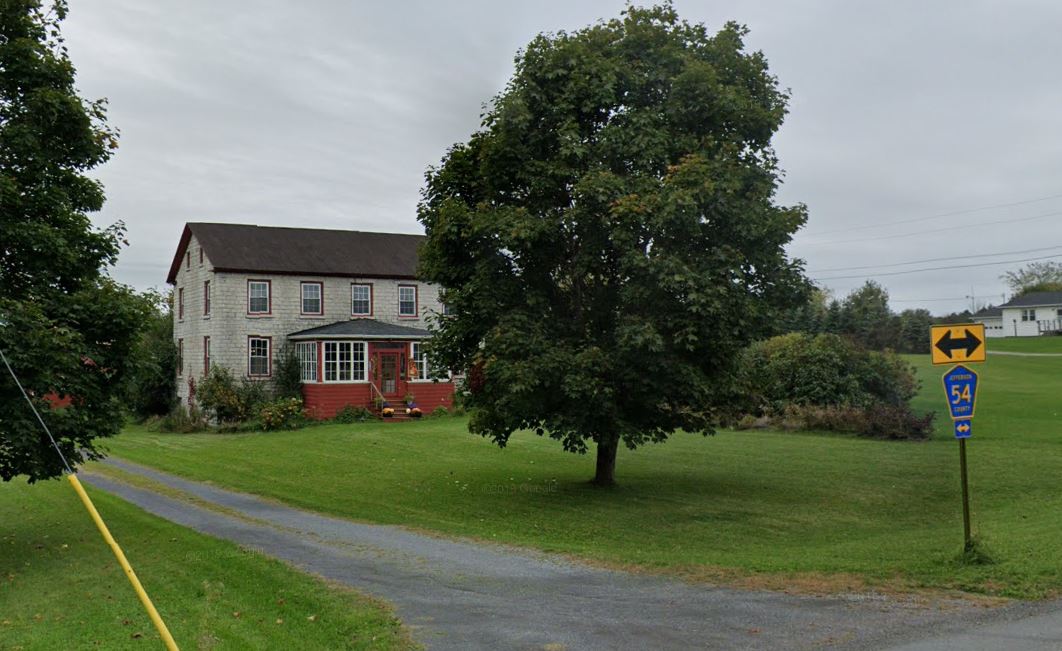
County Road 54, opposite the Allen Rd
Since January 19 1938 Levi Edward Schultz and wife, Mrs Lillian M Schultz, have owned this old Georgian native limestone house at Lawyer's Corners a few miles north of the village of Brownville on the Perch River road. With the house is a farm of 227.86 acres of land and for 28 years it was owned by Mr Schultz' father prior to the latter's death January 26 1934.
William Schultz was a native of Alexandria and prosperous farmer who had been a member of Perch River Grange. He was married to Miss Maud G Ostrander August 30 1892 who survived him until January 15 1937. When William Schultz died, this property went to his widow, who also died intestate, the stone house and farm going to their children, Levi Edward Schultz, John J Schultz, Mrs Ava Schultz Lewis and Miss Erva Maud Schultz. By deed January 19 1938 Levi Edward Schultz and wife acquired sole ownership of the place from his brother and sisters.
The record shows that William Schultz purchased the property from Mrs Mary B Fish, widow of Albert Fish of this city, January 3 1906. Mrs Fish was the former Mary Bort Lawyer and records in the county clerk's office show that on January 1 1880 William Lawyer and wife, Mary, disposed of this property to Cornelius Bort of the town of Orleans. However on July 9 1885 Cornelius Bort and his wife, Elizabeth, conveyed the place back to Mrs Mary Lawyer, wife of William.
There is a period of some years following this during which the title of ownership of the big stone house and 227-acre farm is somewhat hazy. That the house was erected, minus the modern enclosed porch that now appears there, about 1834 there seems no question.
Ii was probably built by Nicholas Lawyer, one of the early residents of the town of Brownville, who purchased 375 acres three roods and 30 perches of land there from John and Louisa LaFarge of LaFargeville for $4,000 on July 23 1833. This price indicates the possibility that the house had been constructed for LaFarge before he disposed of the farm to Mr Lawyer, but there is no proof of it.
A Nicholas Lawyer died intestate April 24 1844 and another Nicholas on June 5 1874. Both were residents of the town of Brownville and probably one was the son of the other, but the first one had only $30 to $60 of property while the latter owned about $10,000. The second Nicholas Lawyer was referred to as Hon. Nicholas Lawyer, and his wife, Mrs Laney Lawyer, who died in February 1873 willed a marble bust of him to her step-daughter, Rebecca, who became the wife of County Judge Charles H Walts.
Papers in the surrogate's office show that the children of the second Nicholas Lawyer at the time of his death in 1874 were Frederick Lawyer of Brownville, Luther Lawyer of this city, Hannah Schell of Cape Vincent, Rebecca Lawyer Walts of Brownville, Augustus Lawyer of Brownville, Jefferson Lawyer of Brownville, Susan Van De Walker of Pamelia, William and John W Lawyer of Schoharie and Lucinda Bergh of Sharon. The late Attorney George A Lawyer, his brothers, William and Charles H Lawyer, and sister, Miss Mary A Lawyer, Jefferson D Lawyer and William L Lawyer of this city and the Kilburns of Brownville are among the several descendants of Nicholas Lawyer.
Down through the years, after the house was built, parcels of land were sold off the farm until the acreage now consists of 227.86 acres.
When Captain John Hoover built the stone tavern at tthe corner of Main and Noble Streets in the business heart of Evans Mills in 1821 Josiah Fuller was the mason who did the fine stonework upon it. Six years later, Hoover, who owned a considerable plot of land on the opposite side of Main Street, began the construction of the brick tavern that still stands and is used as a hotel. A little further up Main St towards Watertown and just beyond Pearl Street is the little native limestone house shown herewith.
The site was acquired by Fuller from Captain Hoover, April 4 1828 for $100 and tyhe house probably built that year as the following April 2 Fuller and wife Polly sold it to Seneca Ingerson for $500. Ingerson disposed of it December 6 1838 to WIlliam H Childs for the same price, less a quarter of an acre that had been sold off. On September 12 1855 heairs of William H Childs sold the property to Adolphus M Cook. On January 12 1859 another small part was acquired by Mr Cook from Helen Marie Collins.
It remained in the Cook ownership until November 9 1896 when it was sold to Aaron and Mary S Forbes and Mary E Baxter who kept it until December 21 1905. On that date they disposed of it to Frank Walts and on October 7 1922 his estate sold it to Mr and Mrs George Cooke. Mrs Cooke died August 1 1938 and the property is now owned by her husbnad, a retired farmer aged 84. It is occupied by his son and daughter-in-law Charles J and Nina L Cooke was have resided there since 1933
Chartles J Cooke operated a drug store in Evans Mills for some years but it is now connected with the J C Penney company in the city. Mrs Cooke was the foremer Nina Lortscher and for the past 25 years has been a faculty member of the Evans Mills High school.
The present occupannts are authority for the statement that the place was once owned by Dr Ira A SMit, first physician of Evans Mills and Fatherinlaw of Adolphus M Cook. Dr Smith, who studied medicine with his brother at Little Falls, was admitted to practice in 1821 and on March 31 of that year bought a quarter of an acre of land in Evans Mills from Captain Hoover. Later he purchased several other parcels, became associated with Dr William G Comstock and engaged in mercantile business along with his practice. He was treasurer of Jefferson County medical society in 1828 was supervisor in 1836 and died in Evans Mills January 1 1863. When the First Associate Congregational Society was organized in Evans Mills March 3 1823 he was made a trustee.
Adolphus M Cook was one of the early merchants of Evans Mills and died in 1889 his children conveying their intereste in the estate to their mother Mrs Melissa A Cook who lived until 1896. Then by the terms of her will the estate went to the children, Adolphus W Cook, Eliza C Sholes, Charles R Cook, and Robert H Cook. Shortly after that the property on Main St was sold to Mr and Mrs Forbes who nine years later sold it to the present owner
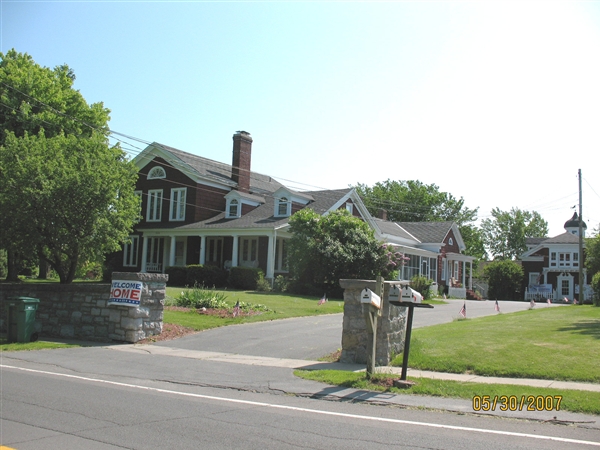
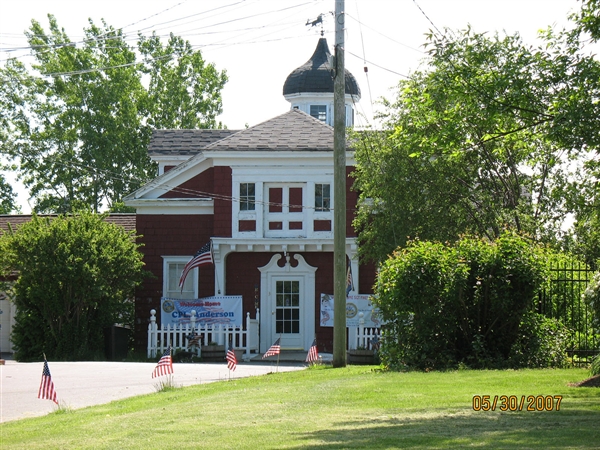
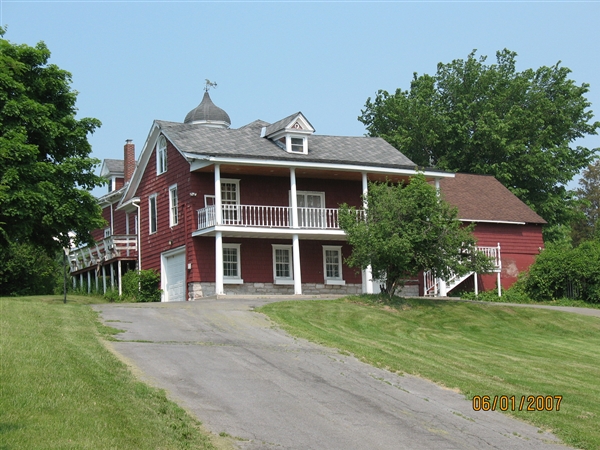
"Hillcrest" Farm, located on the east side of Ives Street just inside the southwestern bounds of the city, has had a long record of distinguished ownership. For the past 32 years it has been the property of and for the past 13 years the residence of former Mayor John B Harris, outstanding American dairyman and head of the local law firm of Harris & Taylor. Before that it was owned by the late Anson R Flower, local millionaire-philanthropist and one-time member of the Wall Street firm of Flower & Company. Preceding Mr Flower, the property had been held for a brief time by the late John M Tilden, wealthy local tinware manufacturer and founder of the Tilden Paper company.
Longest ownership of all was that of Willard Ives, covering 48 years. Mr Ives was also a man of great distinction. While he liked best to be known as a farmer, he was a noted philanthropist, educator and leader in the Methodist Episcopal church. In addition he served a term as congressman from this district. The story of this farm, with its cozy, sightly, rambling old house known as 725 Ives Street, goes back 131 years to March If), 1816 when Peter M Cameron bought the 104.25-acre nucleus of it for $312 from Nicholas Low who was one of the early proprietors of the county.
Apparently it was Cameron who built the house and first barn for ten weeks after he purchased the land he mortgaged it to Dr Isaiah Massey, Watertown's first physician and inn-keeper, for $3,000. Without doubt this money was used to build the house and a barn, but on July 25 1821 former Sheriff David I Andrus sold the place, to Andrew Newell who in turn disposed of it lo Setti Otis March 1 1822 and on October 9 1826 Jonathan Deming bought it and additional land from Otis. On May 6 1843 Jonathan Deming conveyed the farm to Robert Deming, who sold it June 1 1848 to Willard Ives for $4,000.
Born July 7 1806 on a Hounsfield farm, Ives was the son of Dr Titus Ives, physician who located in the Field Settlement area in 1801 came from old New England stock, served in the New York state assembly in 1829-1830 and died in 1847 the richest man of his time in the county, leaving his only child, Willard, $100,000. Willard was twice married, first to Charlotte Winslow who died and second to Lucina M Eddy. In 1840 he became a director of the Bank of Watertown, later of the Merchants' bank, was an original trustee of the Jefferson County Savings bank, was president of the Jefferson County Agricultural society in 1848 was president of the Watertown Fire Insurance company, was a heavy stockholder and director of the Davis Sewing Machine company and large stockholder in the Watertown SpringWagon company.
He was a founder and second president of the Jefferson County Orphan Asylum, an organizer of the Thousand Island Camp Meeting association and of Syracuse university. Like, his father he was one of the most active leaders of the First Methodist Episcopal church, an outstanding member and in 1846 was appointed by the conference to represent it at the world Methodist convention in London. For 22 years he was president of Ives Seminary at-Antwerp. In politics a Democrat, he went to congress in 1850 for a term. Ota April 19 1896 he died leaving about $200,000 most of which was willed to Methodist organizations.
His farm, which he had greatlv improved, was sold by his estate to John M Tilden April 6,1899. Tilden added further improvements and sold to Anson R Flower February 23 1901. It was then the name HiUcrest was applied, the house improved and a large barn built by Mr Flower, whose widow, Ida B Flower, sold the place to Mr Harris March 19 1915. Mr Harris, three times mayor of Watertown from 1924 io 1936 has greatly improved and enlarged the house, increased the acreage from the 109.27 that Willard Ives had to about 500 and established a herd of 190 head of Brown Swiss cattle, finest in the country.
President of the national Brown Swiss Cattle Breeders association he is also past president of the state association. One of his cows broke the milk and butterfat record for twelve-year-olds for all breeds, and members of his herd have been sold to Puerto Rico and PanamA He has been president of the Mayors Conference.
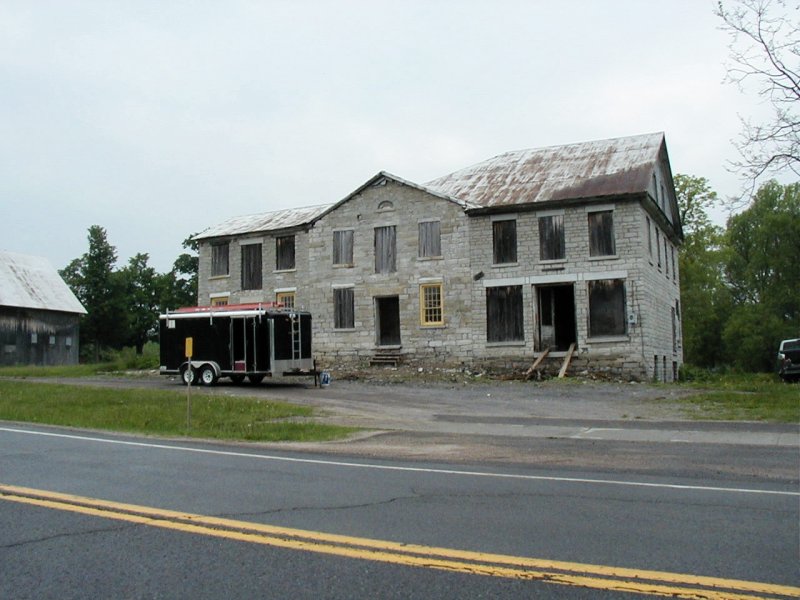
A definite record of this historic old limestone building which has served variously as a residence, a tavern, a store and a Masonic meeting place seems not to have been compiled before. For the past 72 years its title has been in the Irwin family and for 71 years of that John Irwin, the dean of North Country merchants who will celebrate his 93rd birthday on January 8 was active in the operation of the general store of W B Irwin & Sons which is now being conducted by Mr and Mrs Harry Shaw while Mr Irwin resides in his apartment at the west end of the building.
The original part of the structure was erected in 1823-4 by William M Lord, early Brownville industrialist and business man, from limestone quarried near by. The site of about two acres had been purchased by Mr Lord for $13.68 from' Henry C De Rham, New York City merchant, February 24 1823. It was part of 8,021 acres which De Rham had bought of Andrew Mallett Prevost, Philadelphia, Pennsylvania, May 8 1821.
Apparently Lord got into financial difficulties shortly after he built the place for early in 1825 we find former Sheriff .Tasan Fairbanks seizing the property to satisfy a judgment of $2,092.61 which Hoel Lawrence, another Brownville industrialist had obtained against Lord. The judgment dated from October 29 1824 and the papers state that there was a stone house and ashery then on the lot.
Marinus W Gilbert and John Sigourney, Watertown, partners in many enterprises, bid the property in for $425 and interest. Lee Lord was occupying the place when it was taken over and it must have been a tavern at that time for on March 12 1827 the deed from Gilbert and Signorney to Peter G Hart & Company, consisting of Peter G Hart, merchant; Oliver Corwin and James Benjamin, all of New York, states "and is the same lot on which the stone store, tavern and ashery now stands and occupied by Anthony Heard."
Benjamin eventually withdrew, Hart died and March 1 1834 Corwin and Hart's executors disposed of the place to Daniel C Rouse, farmer, supervisor, sheriff and grandfather of the late Senator Elon Rouse Brown. September 16 1834 Bouse sold to John Phillips, who sold to John Mitchell January 8 1836 and March 31 1837 he conveyed to James Green of PameliA Wilson H Harger of Pamelia purchased of Green October 8 1839 and sold to Austin Mattison of Hounsfield January 2 1846.
Mattison disposed of it to Samuel B Starr, Watertown, and John L Mansfield, Clayton, September 23 1847. John Irwin states that his bedroom was built on as a barroom by Green. Mansfield, son-in-law of Starr must have withdrawn from Starr & Mansfield for February 2 1856 he and Abner W Peck as assignees of Starr and Sarah A White sold the property to Daniel C Rouse, and one Henry Collins occupied it at that time. December 26 1856 the executors of the Rouse estate, conveyed to Elon Galusha Brown, son-in-law of Mr Rouse, who had died August 6 and on October 7 1857 Senator Brown was born there. Elon Galusha Brown continued the operation of the store until February 21 1868 when he sold to Daniel H Lingenfelter and moved to Watertown to engagein the butter and cheese business.
On March 19 1875 Mr Lingenfelter disposed of the property to William B Irwin, native of Orange county, grandson of a Revolutionary veteran and son of a veteran of the War of 1812. He had come to the Carter Street road of Orleans as a boy of 12. His son, the present John Irwin, was 20 when the firm of W B Irwin & Sons began business April 1 1875. William B Irwin died in 1892 willing the business to John, who was joined by his brother, William A Irwin. The latter was associated until his death November 5 1941.
It has been a long time since a tavern was operated there, but most of the time for nearly 125 years a store has been conducted, selling food, clothing and farm tools. Over the store Stone Mills Masonic lodge met from the time it was chartered June 21 1850 until it moved to LaFargeville in Februaryruarv, 1867 and changed its name to LaFargeville lodge, No. 171 F & A M
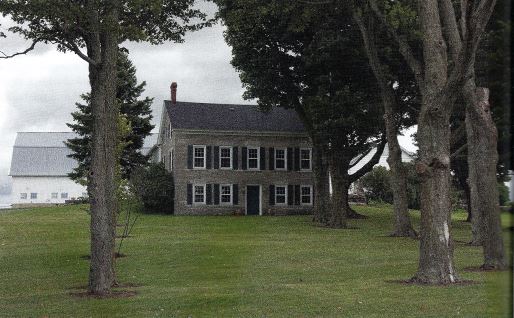
Approximately two miles north of the village of Brownville by Brig. General Calvin Britton, or Britain as his name is spelled in old deeds, this house of native limestone is an example of what can be done by intelligent restoration. This restoration was developed by the present owners, Mr and Mrs Francis G Taylor, who purchased the property from the estate of Mrs Laura Allen Zimmerman November 6 1940. Of exceptionally staunch construction, typical of the workmanship of 125 to 150 years ago, the house, which consists of 16 rooms, occupies a farm of 242.04 acres. It backs into a side hill. Its front entrance is central and is flush with the ground. A wooden ell or woodshed is attached to the rear and a modern barn and silo have been constructed. The lawn is to be landscaped with tulips and other flowers to enhance the beauty of the place, Which is already one of the most attractive country estates in the county.
Mr and Mrs Taylor have replaced the disfiguring red and yellow patent roof with a harmonizing one of wooden shingles closely laid. The original twelve-paned windows were retained, all of the exterior woodwork about them was repainted white, and the original blinds, half of which had been stored for years, were gotten out, repainted dark green and placed on all of the windows.
Inside the house the old dark brown paint was removed from floors and woodwork. The woodwork was then refinished in white. The floors, which are of wide oak boards in most of the rooms, and soft pine in only one. or two, were sanded down and re-dressed in English wax, which has been buffed. Two of the old fireplaces were opened up to give a total of four in use and a picture window was built into the dining room. This window is embellished with cruets from Mrs Taylor's fine collection of colored glass.
Other than by redecoration neither the interior nor exterior of the house has been changed. New plumbing and electric wiring have been installed but all pipes and wires have been concealed between the floors. The house is furnished with attractive antiques. Upon one of the main fireplace mantel shelves is a collection of old pewter and pewter plates, while on another is a collection of copper and copper lustre ware.
Calvin Britton who succeeded General Jacob Brown as militia commander
after the War of 1812 fought in that war and was a warm friend of General
Brown. He was one of the earliest settlers of the town of Brownville,
coming there in 1801. On August 22 1815 he bought 161.10 of the present
242.04 acres of the farm from James D LeRay and built his house. On
April 1 1837 Calvin Britton and wife, Betsey, sold the place to Warner
Failing of Pamelia, for $3,200 and on the same date George W Britton
disposed of an adjoining 80.94 acres to Failing for $1,600. The following
April 26 Failing and wife sold the entire property to Orville V Brainard,
Watertown banker and merchant, who held it until April 18 1839 when
Jacob Zimmerman bought it. Zimmerman had just
brought his family and belongings by ox-team from St. Johnsville.
Zimmerman died November 28 1875 and willed the stone house, outbuildings and farm to his son, Walter, who had been born at St. Johnsville July 10 1834. Walter Zimmerman served the town several terms as supervisor between 1875 and 1894 and was elected assemblyman from the first district in 1895 1896 and 1897. He was married to Miss Laura A Allen in 1862. They retired about 1908 and moved to Brownville village where he died December 28 1910 willing the farm to his wife. She died July 29 1925 and the farm was retained by her family until they sold it to Mr and Mrs Taylor. Mr Taylor is head of the F G Taylor Farm Equipment company of this city.
One of the many old native limestone houses in the town of LeRay is that of Randall Barnes located a few miles outside of the village of Evans Mills on the road to LeRaysville. It is believed to have been built upwards of 110 years ago from stone quarried nearby and is now jointly owned by Mrs Emery E Paul, city, and her brother, Leonard J Helmer of New York City. With it is a farm of slightly over 228 acres, all of which is tillable land, and which is operated by Roy Lingenfelter.
It occupies a site upon a knoll well above the highway and from there a pleasant view extends far over the countryside. As for the house itself it is roomy with an attractive central front entrance, which is shadowed by the long porch constructed across the front of the house several years after the house was erected. In the basement are two fireplaces long since out of use.
Randall Barnes was the son of Asa Barnes who came from Oneida county to settle in the town of Pamelia in the first quarter of the 19th century. From the town of Pamelia where Asa had owned some parcels of farm land he transferred to the town of LeRay, where he purchased land in 1833 not far from this house. It is said that his son, Bandall, who had remained in Oneida county to work in a factory, saved enough money in four years to buy the nucleus of his own farm in LeRay to which he came in 1834 and later built this house.
In the town of LeRay, Bandall Barnes was a prosperous farmer, an ardent Prohibitionist and in 1840 voted for J G Barney, the Prohibition candidate for president. Mr Barnes was twice married. His first wife was Mary Ann Woodruff, to whom his father, Asa Barnes, devised a substantial acreage of farmland in LeRay, according to his will recorded December 19 1853.
Mrs Mary Ann Barnes died during the latter part of her husband's life and he next married Eliza Cox and moved to this city taking a room in the then new Commercial building located where the Chamber of Commerce building now is. A short time afterward, September 6 1879 Mr Barnes died. The farm at that "time was operated by his son, Harvey W Barnes. On March 23 1880 his executors, Alexander Kanady and Fred Waddingham, sold the property to George and Jonas Petrie Jr, for $9,925. They jointly owned the farm until July 6 1896 when George conveyed his interest to Jonas and on April 6 1898 Jonas deeded the entire place to Charles Petrie. Charles Petrie and Bose A Petrie, his wife, disposed of the property to Daniel B Helmer of Evans Mills May 24 1909. He operated it until 1924 when he moved into Evans Mills, residing there until his death November 13 1944. All of his property went to his widow, Mrs Nora E Gartland Helmer, under the provisions of his will and when she died January 20 1946 she devised the farm jointlv to her children, Mrs Emory E (Elizabeth H) Paul of this city and Leonard J Helmer of New York City.
Thus for 39 years this old stone house and farm have been in the possession of the Helmer family, while for 29 years prior to that it had been held by the Petries, both old and prominent families in the history of the town of LeRay.
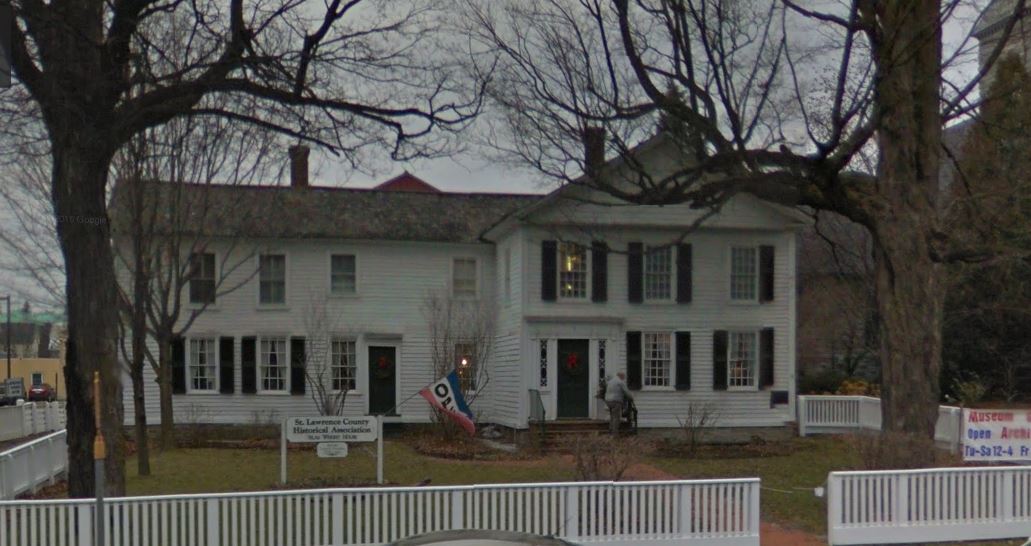
Of the 47 men who have served as governor of New York state from the time George Clinton was elected July 9 1777 to the present this North Country has furnished but two of them, both Democrats. The first of these was Silas Wright, Canton, "the Great Commoner" a century ago, whose term ran from January 1 1845 to January 1 1847. The other was Roswell P Flower of this city, who went into office January 1 1892 for a two-year term. Both were men of rugged character. Both had homes decidedly similar in type — white, clapboarded Georgian homes, plain and comfortable.
That of Silas Wright on the north side of East Main Street in the business section of St. Lawrence county's seat of government has for some years been- a tea room. Since Silas Wright lived there the long, one-story wing on the west side has been raised to become two stories and a spacious modern verandah added to it. A square porch has been built at the main entrance with its sidelighted doorway, but otherwise the exterior appearance has not been changed, except for the replacement of the smallpaned windows witli those of large panes. There are still the green blinds and the graceful fanlight in the front gable to light the attic.
With the complacence that marked its great owner it looks placidly across the peaceful public park to the tallspired, tree-screened Presbyterian church of which he was one of the first trustees after the incorporation of the church society July 22 1825. The sites for both the church and the park were given jointly by him and Joseph Barnes in October , 1827 and the next year construction was started on the church, which was completed in 1831. David C Judson, Ogdensburg, early St. Lawrence county settler, sheriff and state senator, whom Wright succeeded at Albany, once owned Wright's house site.
On April 3 1833 Judson sold the lot to Moses Whitcomb, an early Canton merchant, for |190. Whitcomb apparently built the house immediately and on October 21 1834 joined with his wife, Jemima Calista, in selling it to Wright for f 1,000. Wright and his wife, the former Miss Clarissa Moody, daughter of Tavern-keeper Medad Moody at once moved in, occupying its eleven rooms, in two of which were fireplaces and Franklin stoves. In the extreme westerly room of the wing Silas Wright died August 27 1847 a few hours after he had suffered a severe heart attack in the postoffice. Mrs Wright remained there until her death in August, 1870.
Title to the property then passed to Plinv, the eccentric bachelor brother of Silas Wright. On October 31 1891 William H Kimball, president of the St. Lawrence County bank, as Pliny's, executor, sold the place to the First Universalist society of Canton, for f 1,800. For some years it was used as a parsonage, the church being next to it on the east. Finally it was deemed too large and for many years has been rented, first as a dwelling and then as a tea room.
It would be presumptuous to attempt a biography of the man who was one of this nation's greatest statesmen, a man of the people, sincere friend to the people, democratic Democrat and intimate adviser to President Martin Van Buren, whom he entertained in this house. His words were plain, his meanings clear as springwater. He was an orator who moved men, not by fancy or vague declamation, leaving no impression on the morrow's thought, but one who put in words the best and deepest convictions of the hearer, or led him by candor away from old prejudices to new convictions. His utterances of the honored doctrines of the Democratic party, hard money, a tariff for revenue, states rights, the sacredness of the guaranties and compromises of the federal constitution, had all the vigor and power of the North in them and were and are to this day invigorating to every true Democrat." That was William A Poste's appraisal 6? him on the occasion of"tne 100th anniversary of Silas Wright's birth observed at a dinner of the Brooklyn Democratic club.
Of Pilgrim ancestry Silas Wright was born at Amherst, Massachusetts, May 24 1795. The next year his parents removed to Weybridge, Vermont. He was graduated from Middlebury college in 1815 studied law with Henry C Martindale and Roger Skinner at Sandy Hill, was" admitted in 1819 came to Canton, was appointed surrogate in 1821 was postmaster of the village, served as state senator from 1824 to 1827 inclusive, Congressman from 1827 to 1829 state comptroller 1829-1834 U S Senator from 1834 to the end of 1844 refused the vice presidency and many other offices and died at 52 as he was on the way to the presidency.
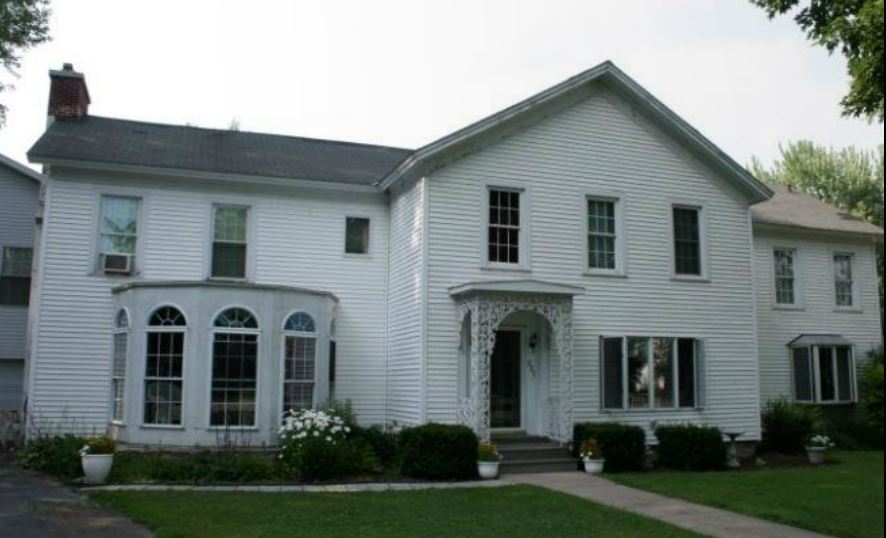
Nowhere north of New Orleans will there be found a finer specimen of iron grill-work than that about the bay window and front porch of "Windy Bank," one of the show places of Cape Vincent. In fact this grill-work was purchased in New Orleans some years ago by Mrs Lucie Cobb Newton, late wife of J Reginald Newton, and was brought to Cape Vincent and made a part of this house, which is now owned by Mr and Mrs Alexander H Rutherford of New York and Rome who use it for their summer residence.
Located at the northwest corner of Broadway and Real Street, "Windy Bank" is tied in tightly with interesting Cape Vincent history. The house itself, a gleaming white two-story frame structure with flanking wings stands close to the street and is probably about 77 years old. It occupies about an acre of ground having a frontage of 113-1/2 feet on Cape Vincent's main thoroughfare, Broadway, and is behind a white picket fence. Northward along Real Street the lot stretches 21 rods to the shores of the green St. Lawrence. It is part of lands sold by James D LeRay de Chaumont to Count Pierre Francois Real, Napoleon's onetime perfect of police, December 24 1822 after Real and a little band of Napoleonic refugees made asylum in Cape Vincent. On April 10 1837 Mme. Eulalie Francoise Lacuee, only child of Count Real and widow of General Jean Chrysostome Douzon de Laucee, sold this lot in a block of three acres to Louis D, Hyacinthe and Theophile Peugnet. distinguished adherents of Napoleon. On March 15 1851 the three brothers divided the three acres almost equally and this lot fell to Theophile.
From him it passed to John Amie Adolph Peugnet of Algona, lA, Martin James Leopold Peugnet of Santonio, Tex., Alcide Ernest Bruce Peugnet and Bridget Alcide died, a bachelor, intestate and his share went to the others, and on August 6 1870 they sold the "Windy Bank" site to Austin Rogers, who is believed to have built the house shortly thereafter. No house is shown there either by the county map of 1855 or the atlas map of 1864.
Austin Rogers, native of West Springfield, Massachusetts, and son of Henry and Abigail Leonard Rogers, settled in Cape Vincent in April, 1815. Mr Rogers died September 13 1893 leaving a son, Augustus, a daughter, Emily Maxon, and a grandson, Austin L, as his only heirs. The latter, founder of the Rogers Brothers Seed company, died in San Diego, Calif., October 19 1937.
June 3 1919 Albert J Phinney, wealthy resident, purchased this place of Bertha E Eichorn, Ross Stevens and wife, Elva, Natural Etta M Sheridan, Albany, and .Tennett Stevens Conner, Cape Vincent, converting it into a summer home. On September 14 1928 Mr Phinney and wife, Emmabelle M, disposed of the place to the late Caruthers Ewing, New York City, general counsel of the Great Atlantic & Pacific Stores, and purchased "Beechwood."
Mr Ewing and wife, Bessie, sold to Mrs J Reginald (Lucie Cobb) Newton, millionaire Stamford, Connecticut, residents, on February 24 193.3. Mrs Newton made a number of improvements including the addition of the iron grillwork and furnished it richly and beautifully in the Victorian manner, assembling there many valuable objects d'art. After her death it became the property of her husband, J Reginald Newton, as of September 9 1946 and on July 1 1947 Mr Newton sold it with much of its contents to Mrs Alexander H (Lucy S) Rutherford who is the present owner, and it remains one of the finest summer homes in Jefferson County
Oxbow Road in Theresa
Of the old stone houses in the town of Theresa there are a number in its lake district. Among the latter is the small native sandstone house of Harold Gilbert Young and his wife, Kathryn M Young, out of Theresa village on the Moon lake road. This house occupies a 175.19-acre farm, part of which is in the town of Theresa and part in the town of Antwerp. The farm is composed of three parcels, one of 100.67 acres in the town of Theresa and two of 29.77 acres and 44.75 acres in the town of Antwerp.
It is not exactly known when the house was built or by whom, but it seems likely that it was erected almost a century ago by predecessors of Joseph Allen, an early Theresa settler, whose father, Joseph Allen, a United States pensioner, died February 2 1846.
Recorded deeds show that Allen purchased the 100.67-acre parcel from representatives of the Charles Joseph Xavier Knuyff estate et al for $161.62 on January 16 1852. Four days later Allen bought the 29.77-acre plot from Jesse and Susan Ann Kelsey for $700. On March 18 1854 Joseph and Amy Allen sold the farm consisting of these two parcels to George W Humphrey for $3,900.
The fact that Joseph Allen gave two substantial mortgages on the property on February 5 1852 less than a month after he purchased the two parcels would indicate that the house was standing then and that its builder may have been Kelsey, who had acquired the 29.77-acre parcel from Abraham and Harriet Cooper for a small price on November 8 1845.
George W Humphrey, Orphy J Swan and husband, B F Swan, disposed of
the place March 14 1871 to Captain Elias Getman of Theresa for $4,000.
Son of Jacob and Lena Suits Getman, Captain Getman was born August 1 1824 in Fulton county, and shortly after that they moved to this county. After
attending the common schools Captain Getman learned the carpenter's trade
at
Plessis and became a successful contractor and builder.
He married Sophia, daughter of Columbus Evans of Alexandria September 26 1846 and had four sons, Edgar, Edward, Edwin and Edson. Edwin died in infancy.
Captain Elias Getman returned in the fall of 1865 from the Civil war with the rank of captain after serving in the 10th New York Heavy Artillery. The next spring he bought the brick hotel in TheresA Thereafter it became known as the Getman House. He died January 19 1882 and the control of the hotel went to his three sons, Edgar, Edward and Edson, who became famed as Getman Brothers in North Country hotel operation, having also owned and operated the historic American house in Canton as well as the St. Lawrence Inn in Gouverneur and the Orleans House in LaFargeville.
The present Getman House in Theresa was built in 1890 and stands upon the site of the old brick hotel built there in 1824. The latter, in turn, replaced the hotel which James D LeRay de Chaumont caused to be constructed in 1819 and which burned in 1821.
Ownership of the sandstone house and Moon lake farm passed down through the Getman family from Captain Elias Getman to his grandson, Dr Edson E Getman of New York City, who served as a major in the recent war and who sold the property to Mr and Mrs Young on December 27 1943.
Hammond NY Tour Brochure
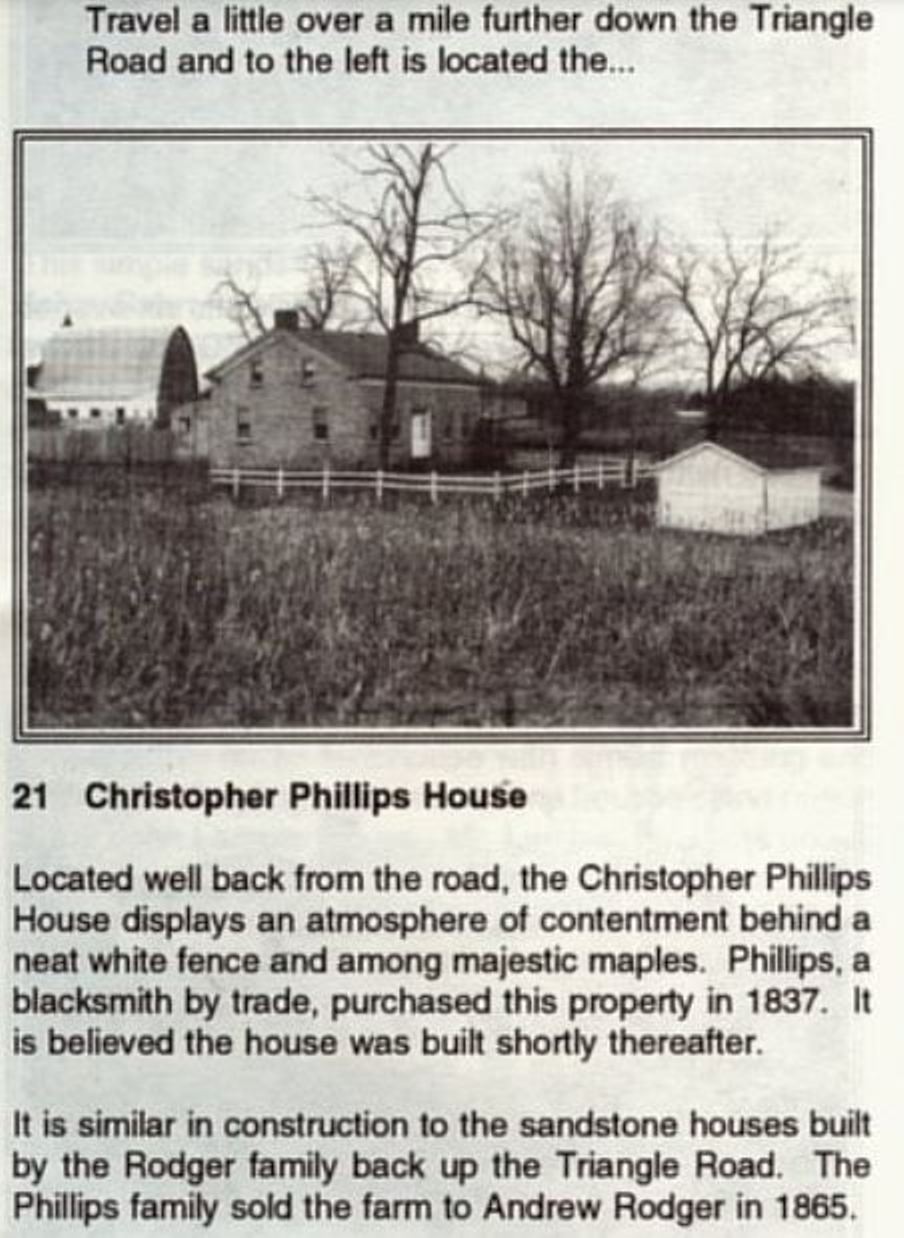
Just off the beaten path on the Triangle road in the town of Hammond, St. Lawrence county, is one of the most appealing farm homes in the entire North Country. Owned now by Frank A Dunham it was probably built by Christopher Phillips, a prominent early settler of the town of Hammond, about 1838. Its walls are of native sandstone, of which there is a deposit of excellent building quality in the vicinity. In fact there is a level terrace of sandstone which extends from the western side of Black lake through the center of the town. Incidentally it may be of interest that Hammond, organized as a town March 30 1827 was named for Abijah Hammond, a prominent New York City merchant and speculator of a century and a half ago.
Abijah Hammond, brother-in-law of David A Ogden, owned the town prior to 1814 on September 12 of which year David Parish bought 28,871 acres. In the town are numerous sandstone houses, many of which were erected by Scotch who settled there between 1818 and 1821.
George Parish of Ogdensburg, successor to David Parish as a great North Country landowner, contracted original 130.5 acres of this farm to Christopher Phillips June 30 1837 for $204.24 but title did not pass until July 20 1846. Phillips and his wife, Latetia, retained the property until September 18 1865 when they sold all but half an acre, previously disposed of to Adeline Bates, to Andrew Rodger for $5,850.
The Rodger family was prominent in the town and this house was located in the so-called Phillips school district, the school in which was built in 1847. On June 10 1898 Andrew Rodger conveyed the place to his son, Albert H Rodger, who left the farm after some years and delegated its operation to his son, Fred. Mrs Mary L B La Frenay, Clarence B and Raymond C Rodger, heirs of Albert H Rodger, sold this house and farm to Charles Dunham November 1 1924 and Mr Dunham occupied and worked it until his health failed in March, 1930 when his son, Frank A Dunham, leased it of him, eventually buying it of his mother, Mrs Cora Dunham, in 1945 after the death of her husband, Charles. The Dunhams have long been active members of the Grange and are well known in the town. Only recently Mrs Cora Dunham was awarded her Gold Sheaf certificate for 50 years of Grange membership. Located well back from the Watertown-Ogdensburg state highway this house displays an atmosphere of contentment behind a neat white picket fence and among ancient maples and grounds naturally and informally landscaped.
It is well-built and comfortable with wide central entrance and spacious hall. Besides the large living room, dining room, play room, kitchen and bathroom there is an interesting old fireplace with simple wrhite-painted mantel of wood downstairs. Upstairs there is also a large central hall, four bedrooms and clothes closet. The entire house has an air of charm as well as stability.
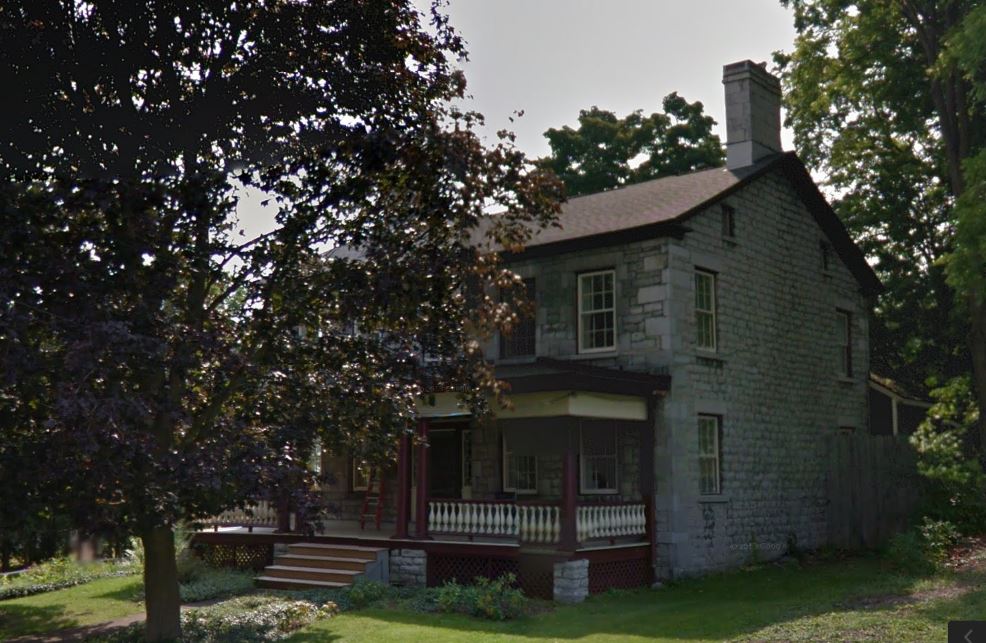
The Calvin Lewis house constructed in 1826 on the west side of State Street across frpm Monument park near the picturesque Presbyterian church in the village of Lowville is one of the most excellent specimens of cut limestone workmanship in the North Country. It consists of eleven rooms, has six fireplaces and the beautifully wrought interior woodwork is said to closely resemble that in handsome Constable Hall at Constableville and the graceful Talcott mansion at Talcottville.
Calvin Lewis, who came to Lowville among the first settlers in 1802 was a manufacturer of hats and developed into one of the most ardent abolitionists
in the north. The legend is that this house was a station along the underground
railway for the escape of fugitive negro slaves and that there was a secret
underground passage leading to the stone house now owned by Raymond Richardson.
However, no trace of this has yet been found. Lewis built the house ten
years after his marriage to Betsey Lane, who was a member of the first
class to be graduated from Lowville academy, to which her father had been
one of the original contributors. The walls are two feet thick, sturdy
and true and similar walls partition the basement into four rooms. A cooking
fireplace with two bake-ovens is in the basement. The cut stone at the
outer wall corners are dovetailed. Original leaded glass rectangular side
and transom lights border the central front entrance with its original
door fitted with a big
handmade iron lock operated by a 5 1/2 inch brass key.
The original twelve-paned windows with solid-panelled wood interior folding shutters remain in the house. Close to the street upon the lower corner of the lot is a smaller limestone building built by Lewis for his hat factory. Still a part of the house property the smaller building was converted into a dwelling after Mr Lewis ceased to use it for a factory, but for the past two years has been leased by the present owners, H Lynn Alexander and wife, Olive, to Mrs Leonard Pelton for an antique shop. Calvin Lewis was one of the signers for a meeting to organize the first bank in Lowville in 1838. After the death of Calvin and Betsey Lane Lewis the ownership of the house passed to their two maiden daughters. Betsey and Mary. They dressed alike with shawls and bonnets and were always together, Betsey carrying the big brass key in a draw-string velvet bag. Outliving her sister Mary, she died January 23 1907.
Joseph S Tardy, a Lowville jeweler purchased the property from the Lewis estate, installed hot water heating, bathrooms, modern plumbing, electric lights. Also he built the modern verandah that extends across the front, but he did not interfere with the big kitchen fireplace with its old iron crane and bake-ovens in the basement. Neither did he alter the big chimneys extending from the basement floor to the attic where two of them at each end join to come through the roof and well above the ridgepole as one. Nor did he mar the beautiful white enameled carved and fluted wooden fireplace mantels.
On November 16 1918 Fred and Lena Schantz bought the place from the Tardy estate and after the death of Mr Schantz his widow sold it to Mr and Mrs Alexander on November 22 1922. Both of the latter are descended from old pioneer-families and with them reside their daughter and son-in-law, Perry J and Glenda Hushage, as well as Fred and Ada Woolsleger, parents of Mrs Alexander.
Still a part of the house property the smaller building was converted into a dwelling after Mr Lewis ceased to use it for a factory, but for the past two years has been leased by the present owners, H Lynn Alexander and wife, Olive, to Mrs Leonard Pelton for an antique shop. Calvin Lewis was one of the signers for a meeting to organize the first bank in Lowville in 1838. After the death of Calvin and Betsey Lane Lewis the ownership of the house passed to their two maiden daughters. Betsey and Mary. They dressed alike with shawls and bonnets and were always together, Betsey carrying the big brass key in a draw-string velvet bag. Outliving her sister Mary, she died January 23 1907.
The red brick house, owned by Mrs Mary B Jackson at the corner of Water
and Liberty Streets in Dexter since the death of her mother, Mrs Susan
E Vance, July 19 1927 is not onlv one of the oldest in that village,
having been erected about 108 years ago, but is one of the most historic
in that part of the county.
It was built by James A Bell, who not only played a most important role in the founding of Dexter and developing its commerce, but who served the old Jefferson- Lewis (18th) Congressional district from 1859 to 1868.
Born at Hebron, NY, February 8 1814 son of George and Margaret Buchanan Bell, natives of Belfast, Ireland, James A Bell came to a town of Brownville farm in 1824. Later he engaged with Dr J K Bates in the drug and grocery business in Brownville village, but divided the stock in 1836 when he took his share to Dexter. At first he occupied a room in a warehouse to conduct this business. This was connected with the principal dock of the village.
Bell shortly formed a partnership with Colonel Edmund Kirby under the name of J A Bell & Co., an extensive trade was built up in' the storage and shipment of butter, cheese and other produce and the company built a steamer and two sailing ships to transport commodities to Oswego and other Lake Ontario ports. After the death of Colonel Kirby a brick block was built by Bell in the heart of the village where O M & G W Wood were later for many years and where the Grand Union is now.
While serving in congress he became friendly with Gov. Horatio Seymour, President Lincoln and General Grant and lost IiitecesUin the Dexter business. Gov. Reuben Fenton appointed him auditor of the state canal department in 1868. He was a member of the constitutional convention in 1867 and the same year established and became president of the First National Bank of St. Cloud, Minn.
In 1874 Mr Bell bought several lots and engaged in a large building project in Arlington, N J, to which city he removed. Seven years before he had purchased several thousand acres of government land in Minnesota and at one time he owned a cotton plantation in AlabamA
He had helped build the Presbyterian and Episcopal churches in Dexter and 18 days after he married Persis Wood in the latter church her funeral was held in that church. On December 15 1841 he married Rachel P Smith for his second wife. When Dexter was incorporated May 8 1855 he was one of the first trustees. October 7 1840 James A Bell bought the site of this brick house from S Newton Dexter, Colonel Kirby and others for $325 and gave a mortgage to John Bradley in that amount. On April 16 1883 he and his wife, Rachel P Bell, then of Arlington, N J, sold the brick house and site with two other parcels to his brother, William Bell, for $2,000. It had been vacant some years following his removal to Arlington.
William Bell was born in Hebron May 22 1819 and spent 24 years on a Morris tract farm in the town of Brownville. In January, 1842 he married Betsey Seeber. Their children were Eliza S McWayne, Susan E Vance, Lysander W Bell, Emma A Eaglen, Mary J Fox, J Hamilton Bell and Alice C Hayes.
William Bell died January 7 1897 and his brick house went to his widow,
who died on June 10 of the same year. From her the place went to her children
and January 25 1899 Eliza S McWayne and Susan E Vance bought out. the
other heirs. Eliza died in 1903 and on December 31 1906 her heirs sold her
interest to her sister, Mrs Vance who resided there with her daughter,
Mrs Jackson, and the lattcr's son until Mrs Vance's death July 19 1927.
Mrs Jackson's husband, the late Thomas Jackson, proprietor of the Jackson House in Dexter, died December 15 1905. Mrs Jackson continues to reside in this house with her son, who is well known as a deputy sheriff and member of the sheriff's staff at the county jail.
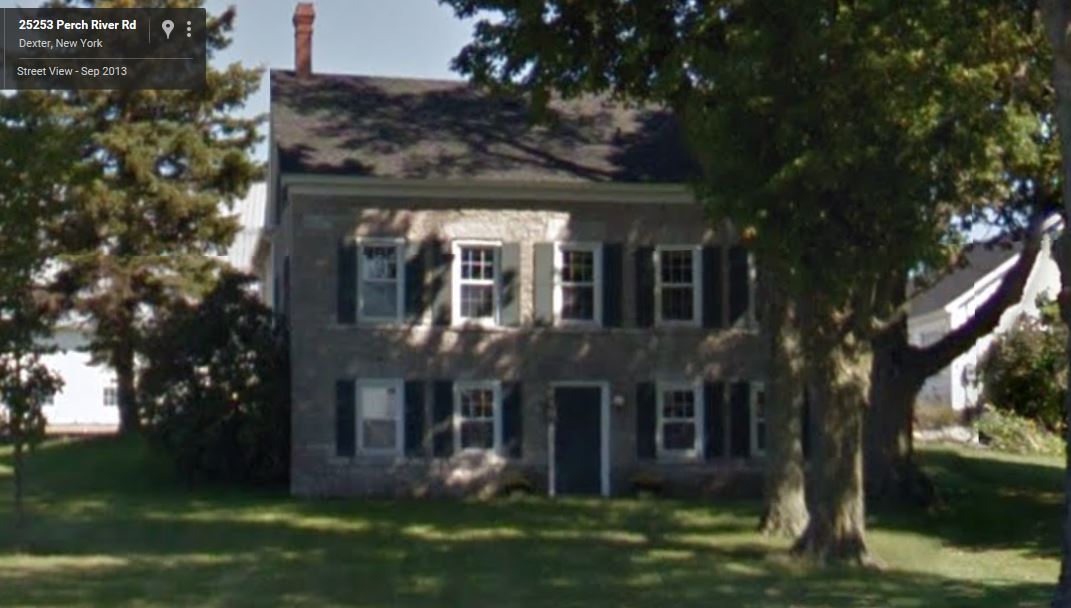
Extremely attractive and well-conditioned is the native limestone farm house owned by Carl F Dorr and wife, Mrs Marthe Bageard Dorr a few miles out of the village of Brownville on the Brownville-Perch River road. Constructed about 1823 by Abner Smith, one of the early settlers of the town of Brownville, this house, which occupies 193.7 acres of land on both sides of the highway •and running to the center of Perch river, originally consisted of eight rooms heated by four fireplaces. Situated on the east side of the highway and facing west, fine old trees in front make the environment most pleasant.
The house has a central entrance but the original door and original windows long since gave place to more modern ones. The thick stone walls were excellently laid and stand sturdy and true after a century and a quarter. The house occupies ground which inclines at considerable grade from the highway towards the eastward. Its entrance is but three steps up and there is a character to the house similar to that owned by Mr and Mrs Francis G Taylor farther on towards Brownville on the same side of the same highway.
Mr and Mrs Dorr purchased the property October 28 1937 from Mrs Marion E Farrell. Mrs Farrell inherited the place and the stock upon it July 2 1929 by will of her father, Horatio N Walts. Mr Walts in turn inherited it March 10 1902 by the will of his uncle, Adam Hagan, who died December 10 1901 leaving an estate estimated about 112,000. Horatio Walts, born on a town of Orleans farm in 1853 married Ida Emerson in 1878 and for some years' was employed by the Dexter Sulphite and Frontenac paper companies.
Back to this point the farm has consisted of three adjoining parcels of 100 acres, 25 acres and 68.7 acres. The latter was acquired from Nicholas and Laney Lawyer April, 2 1869 by Adam Hagan, who had purchased the other two parcels for $4,000 from the heirs of Abner Smith on March 8 1863. The 68.7-acre plot had been part of something over 375 acres bought by Nicholas Lawyer from John and Louisa LaFarge of LaFargeville July 23 1833.
The 100-acre parcel was purchased from John and Candace Baxter October 17 1807 for $500 and on November 4 1822 Smith bought the 25-acre parcel from the Mechanics Fire Insurance company of New York and James De LeRay de Chaumont for $272.19. It is likely that the stone house was built by or for Smith shortly after that.
John Baxter, a Revolutionary war veteran who settled in the town of Brownville about 1802 was listed as an 88-year old pensioner of that town in 1840. On November 14 1802 he had purchased 250 acres in the locale of this stone house from Jacob Brown. On July 9 1804 he acquired 220 acres more there from James D LeRay through Gouverneur Morris, and on May 1 1805 bought 65.25 acres from John W Collins. To these he added a 134.25-acre tract purchased February 1 1806 from Sanford and Eunice Langworthy making a total of 679V2 acres. Baxter was one of the original trustees of. The Brownville Library formed February 10 1807 and with Abner Smith and John Moffatt was authorized by act of March 30 1827 to remove a dam which was causing much damage to land through spring inundation of Perch river.
By inadvertence last week James A Bell of Dexter, was referred to as congressman from the 18th district- He was a state senator and not a congressman.
On Pool Road
Since May 4 1927 Earl W Wicks and wife, Vara L Wicks, have owned this old house of native sandstone near the foot of Moon lake in the town of Theresa near the Antwerp town line. It is only a few rods off the direct highway from Theresa to Oxbow and occupies a farm of 226.14 acres. The property was purchased by Mr and Mrs Wicks on the above date from Mrs Hazel L Smith and Mrs lone Christopher of Theresa village devisees under the will of their father, Lester H Pool, retired farmer also of Theresa village, who died March 5 1923.
Lester H Pool was a son of Harvey Pool, the original owner of the house. Harvey Pool, who died April 26 1877 was one of the early settlers of the town of Theresa as was Zalmon Pool who owned adjoining farmland and had a stone house not far away. Harvey Pool's house shown herewith was probably built about 1835 and the farm which it occupies is composed of five adjoining parcels of land. Of these the first and largest piece consisting of 102.62 acres was purchased by Harvey Pool August 7 1834 from representativesof the old Antwerp company of Antwerp, Belgium, for $359.17.
On October 14 1837 Harvey Pool bought the second parcel of 41.25 acres from Richard J Coxe through the latter's attorney, George I Knight of Brownville, for $165.
For the other three parcels consisting of 46.8 acres, 29.07 acres and 6.4 acres he paid Norris M and Roxana Woodruff of this community for $411.35 on February 10 1852. The house, a long, low, rambling one of simple cottage type, was probably erected shortly after the purchase of the first parcel, of native sandstone quarried nearby.
Only eight days before his death Harvey Pool entered into a contract to sell the farm to two of his sons, Lester H and Munson G Lester operated the farm for a number of years, became a breeder of grade Ayrshires and at one time owned 75 per cent of the Percheron stud, Defiance IL After a time he acquired full ownership of the farm, his brother, Munson, following his profession of veterinary in TheresA
Lester H Pool was born in the old house September 18 1850 was married to Theresa A Peach February 12 1880 and was the father of two daughters. He was for many years an assessor of the town of Theresa and was a precise ritualist in the Masonic fraternity. In 1887-1888 he was master of Theresa lodge, No. 174 F & A M Earl W Wicks, the present owner of this old stone house and farm also comes from a pioneer Theresa family. He is a son of Wallace A Wicks who died June 19 1941 at his home near Pamelia Four Corners at the age of 84 and who was born December 23 1856 in the old Wicks homestead on the Theresa-Oxbow road. Sixty-two years before his death Wallace A Wicks was married to Miss Martha Evans.
208 W Washington
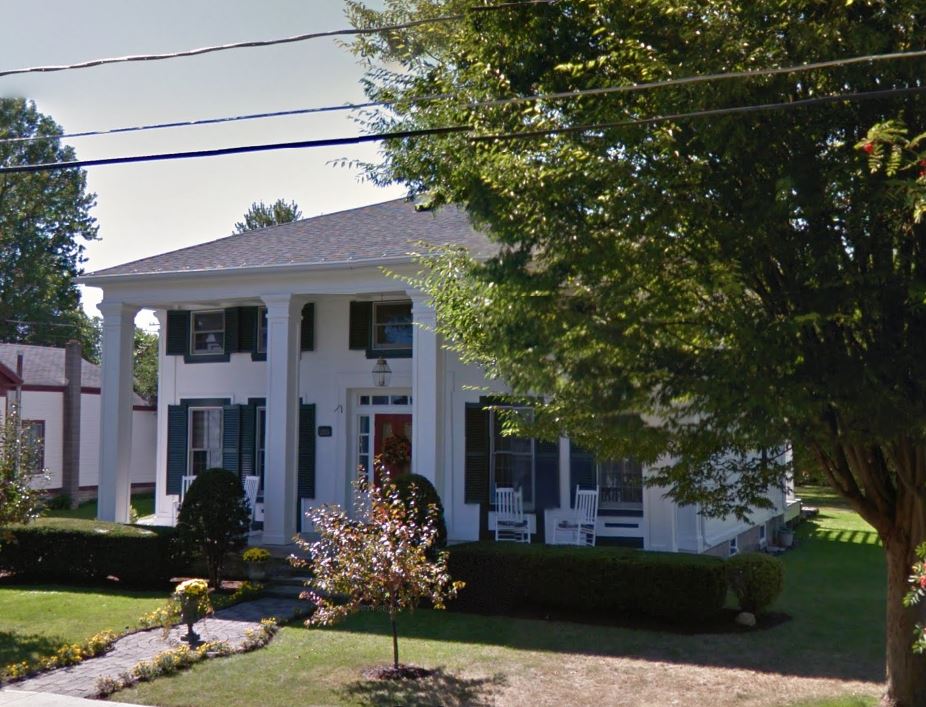
It was on a day early in April, 1817 when the "S S Ontario" in command of Captain Francis Mallaby formerly of the United States Navy, set out from her home port of Sackets Harbor, where she was built, on her maiden voyage up the lake to NiagarA She was the first steamboat of United States registry on Lake Ontario and the fare from Sackets Harbor to Niagara was $10. To Oswego it was $3 to Ogdensburg $5 and to Cape Vincent $1.75.
Concerning Captain Mallaby, the initial newspaper advertisements of the "Ontario's" service said: "An experienced seaman, and a gentleman, eminently qualified to fulfill the duties of his station, has been appointed to command the boat." The "Ontario" operated until she was broken up in 1832 and four years later Captain Mallaby is found buying a number of parcels of land in Sackets Harbor, ostensibly on speculation. But he did not remain long after that in Sackets Harbor, later removing to New Jersey where he took up his residence in Madison.
One of the Sackets Harbor parcels of land which he purchased was that
upon which this house stands. This parcel, 201 feet in depth and with
100 foot frontage on the southwest side of Washington Street between Bayard
and Ambrose Streets, he bought for $300 from Thomas Ludlow Ogden, trustee,
New York City, November 29 1836. On April 22 1844 Captain Mallaby and wife,
Eliza, disposed of the lot to Dyer N Burnham for $250. Burnham, who had
come from Adams, had been a prominent Sackets Harbor lawyer for a number
of years who edited the Sackets Harbor Journal for a season after Edmund
M Luff began its publication October 10 1838. After acquiring this building
lot from the Mallabys, Burnham undoubtedly built the imposing mansion
shown herewith and now
over 100 years old.
On March 28 1853 he and his wife, Sylvia E Burnham, sold the place to William T Searles of Ellisburg for $2,475 and is understood to have removed to Chicago where he became a prominent lawyer. Burnham's house in Sackets Harbor was probably built in 1844-5.
Searles died May 12 1864 and as the result of the partitioning of his property this house and lot in Sackets Harbor was sold to Captain Balph Godfrey, a Great Lakes sailor, September 12 1866. Godfrey and his wife, Jane, conveyed a half interest in it to his mother, Mrs Jane Eliza Godfrey April 8 1871. Later the ownership of the entire property was vested in Mrs Jane Godfrey, who died August 13 1901 willing the house and furnishings to her daughter, Mrs Annie Brunson. Mrs Brunson, widow of Prof. John Brunson who died in 1926 taught school with him for a time on Long Island. She now owns and resides in this 21-room, white-columned and pilastered house, and leases an apartment in it to Mrs Elizabeth Stratton.
The house, still one of the show places in Sackets Harbor, is familiarly known as the Captain Godfrey house, the people of the village having forgotten the ownership by Burnham, the lawyer-editor. Captain Godfrey, born at Williamstown November 6 1838 son of William J and Jane Eliza Potts Godfrey, sailed the lakes for many years and was master of a number of vessels. In 1908 he retired from that calling and became janitor of the Sackets Harbor High school, a position which he filled until 1928. He died November 5 1934 lacking but one day of being 96 years old. The house where he formerly resided for so many years and now owned by his daughter is on the street which runs down past the west side of the battlefield to the high cliffs of Lake Ontario.
1864 Map Below of the Perch River Area.....
This simple cottage type house of native limestone is probably about 120 years old and is located on the Brownville-Perch River road only a short distance from the river itself and not far from the hamlet of Perch River. At an early date Perch River was kitown as Moffattville for Isaac and Melvin Moffatt. During the War of 1812 the settlers built a fort or blockhouse in that vicinity as a defense against Indian attacks. Later this defense was used as a grain storehouse and was finally torn down about 1837. Among the early Perch River settlers were John and Walter Cole, Seth Calkins and John Baxter.
Hiram Mills was also one of the early settlers. Whether Hiram Mills built this house is not known, but August 3 1830 he and his wife, Hepzibah, sold it and the ten acres of land that went with it to Mrs Candace Baxter, wife of John Baxter, who early in the history of (he town of Brownville owned 600 acres of land on the Perch River road.
On September 4 1858 Candace Baxter disposed of this property to John J Babcock and on June 4 1861 he and his wife, Jane, sold it to Byron Cole. Byron was the son of John Cole Jr, and grandson of John, the native of Montgomery county, who located near Perch River in 1802. Byron and wife, Annie Hawley Cole, in turn sold this property to John W Lawyer May 11 1868 and Lawyer was the son of Nicholas and Laney Lawyer who owned the big limestone house now owned and occupied by Levi Edward Schultz a little further up on the opposite side of the highway.
John W Lawyer and wife, Mary E, conveyed to Mrs Laney Lawyer September 13 1869. She died in February, 1873 and under the provisions of her will this place went to her step-daughter, Bebecca, wife of Judge Charles H Walts.
Mrs Rebecca Walts, resident of this city, kept the property but a short time and disposed of it on August 31 1874 to Taylor E Calkins, son of Ervin Calkins, who was the son of that early settler, Seth Calkins. Taylor E Calkins, for many years Masonic lodge steward, married February 2 1875 Clara, daughter of Cornelius and Mary Spicer Van Camp, who were also the parents of David A Van Camp, a prominent Perch River merchant. On November 4 1878 Taylor E and Clara Calkins transferred the property to his mother, Mary McCombs Calkins, wife of Ervin, and on March 1 1886 she sold to Edmund B Calkins, father of the late Dr Frederic R Calkins of this city. Edmund B and Nellie O Calkins, his wife, conveyed the place to Mercy Van Camp, wife of Cornelius Van Camp, on August 1 1890 and on March 1 1894 she sold to Mrs Sylvia A Lowe Van Camp, wife of, David A Van Camp.
C B Smith of Clayton, as administrator of the estate of Svlvia A Lowe Van Camp, disposed of this property to William H and Cora Pratt of Brownville January 27 1920 and on January 27 1982 Mrs Pratt sold to William Schultz, prosperous Perch River farmer and member of the Perch River grange. Mr Schultz died January 26 1934 and the property went to his widow, the former Maud G Ostrander. She died June 15 1937 and later the Nicholas Lawyer property which she and her husband had owned and occupied, and this Hiram Mills place were acquired by her son, Levi Edward Schultz, who continues to own them both.
But the record shows that the longest ownership of this little house shown here was in the Calkins and allied Van Camp families extending from 1874 to 1920. It is an interesting sidelight that Mrs Taylor E (Clara) Calkins was a second cousin of Mrs Nettie Fowler McCormick, wife of Cyrus McCormick, inventor of the reaper.
Zalmon Pool, who was born in the town of Russia, Herkimer county, in 1793 removed from Trenton, Oneida county in March, 1818 and settled on a farm just south of Moon lake on the Theresa-Oxbow road. There he first built a log cabin, having first bought 123 1/2 acres of land from Abraham and Harriet Cooper in the town of Antwerp near the present Theresa line. Aside from employes of James D LeRay de Chaumont there were few settlers in that area at that time.
A deed dated August 7 1833 to 57 adjoining acres in Antwerp runs from Norris M and Roxanna Woodruff of YVatertown, to Zalmon Pool Jr, but in reconciling records it would seem that this is the same Zalmon mentioned in the first transaction. On November 12 1841 another adjoining plot of about 80 acres, but in the abutting town of Theresa was conveyed by survivors of Charles Xavier Knyff of Antwerp, Relgium, to Zalmon Pool Jr, for $278.20 and the year 1840 in the keystone of the above native sandstone house which is located in this plot would indicate that the house was constructed about that time.
On December 19 1844 Norris M and Roxanna Woodruff sold an adjoining plot of 22.75 acres in the town of Theresa and May 8 1852 Charles and Mary Ann Pool conveyed two plots, one of which was 7 1/2 acres in the town of Theresa to Zalmon Pool Jr All of these five plots comprising 290.75 acres containing this house and barns are specified in a deed of the property running to William H Dixon, the present owner, and dated May 19 1916 the price paid being $9,000.
The first-mentioned Zalmon Pool was married in 1815 to Harriet Prfndle and had eleven chiMren, four of whom died in infancy. Zalmon, himself, died September 26 1866 leaving a will dated July 18 1864 giving his widow a life-use of his estate.
In this will he directed his wife to make certain payments to their children
mentioning a contract dated March 1 1859 with their son, Zalmon. Another
child was Harriet, wife of John De Wandler Dence and mother of John Doig
Dence, president of the Dence Lumber company of Lowville as well as having
been for several years Lewis county sealer of weights and measures. The
will of
the first-mentioned Zalmon Pool concludes that after the death of his
wife, Harriet Prindle Pool, what remains of the personal property on the
farm shall go to their son Zalmon. That the latter became the owner of
this stone house and farm is indicated by the deed of the property to
Mr Dixon.
This deed, dated May 19 1916 is from Charles Z Pool and wife, Helen, of Minneapolis, Minn., Flora E Rolton of Racine, Wis., and Mattie H Rodenhurst of Philadelphia, NY, sole heirs at law of Zalmon Pool and wife, Cyrena Swan Pool, to William H Dixon.
Zalmon Pool, who married Cyrena Swan, was the son of Zalmon and Harriet Prindle Pool, and is mentioned in one historical account as Zalmon 3d, who was proprietor of Pool's cheese factory where Joseph Vock was milk buyer. In 1848 this Zalmon built a sawmill, planing mill and chair factory by the lower dam in Theresa where William C Cheeseman was once his partner under the name of Pool & Cheeseman. This Zalmon Pool died May 13 1890. Zalmon Pool Jr, was supervisor of the town of Theresa in 1847-1848.
The big iron letters "Z P" set into the stone walls on either side of the cap to the front entrance leave no doubt for whom the place was built. There are six spacious rooms in the upright part of the structure and in its early years there.was a cooking fireplace and Dutch oven for baking in the basement. Setting well back from the highway the Zalmon Pool house has an attractive environment and is nicely kept by Mr Dixon, who now has a total of about 500 acres of land. The architecture is of Georgian type.
Near Potter's Corners about three miles above Turin at the southeast boundary of the town of West Turin is the Obadiah Phelps house. It is one of the early limestone houses of Lewis county and is understood to have been built by Phelps between 1805 and 1807. In its day it was a mansion and it still retains many of its original features including the fine front doorway with leaded-glass sidelights and transom. It is a large house and stands in the acute angle formed by a road running north into the town of Turin with a road running slightly northeasterly towards the town of Turin and crossing a road running from Constableville to Collinsville.
Obadiah Phelps was one of the earliest settlers of the town of Turin, from which West Turin was set off March 25 1830. He is mentioned among the electors of the town of Turin in 1807 and died September 17 1860. His wife, the former Lucy Pelton, died in 1863. They were the parents of eight children, the youngest of whom was William who acquired this house and farm by buying the rights of the other heirs, his father having died intestate.
The farm site of this house was purchased April 18 1805 by Obadiah Phelps from William and Huldah Pease Halliday. Halliday probably came into this area shortly after Nathaniel Shaler started to promote it in 1796 for before 1800 we find him owning land in the town of Leyden and in the mortgage list of 1801 he is shown as having owned 207 acres of land in the town of Turin. It is likely that he purchased this land from Shaler.
On January 1 1864 William Phelps disposed of this property to Wallace Kentner who, in 1847 married Charlotte Kirtland, a daughter of George and Charlotte Phelps Kirtland and granddaughter of Obadiah Phelps. Wallace and Charlotte Kentner had one son, George Warren Kentner, who inherited the place and resided there many years, engaging in dairying and in the cattle trade, but who is now retired and lives in Port Leyden.
On August 18 1914 he sold this property to George H and Elizabeth Veltin Burdick. Mr Burdick, son of Warren and Betsey Wilkinson Burdick, died December 3 1942 at the age of 81 and his widow and their son, Victor, have since been occupying the place. Mr and Mrs Burdick were also descended from early Lewis county families.
The Kentners belong to one of the oldest of Lewis county families, George Warren Kentner being a great grandson of John P Kentner, a Connecticut Yankee and Revolutionary soldier who came into the present Lewis county territory soon after Shaler, was an elector of the town of Turin in 1807 and who died November 11 1836 at the age of 86 indicating that he was horn in 1750. He was one of the first vestrymen of the Protestant Episcopal church formed at the home of Levi Collins in Collinsville April 7 1817. Mr Kentner also traces his family back to Major Jean Pierre Dupont, a nephew and aide of General Montcalm, who fell leading the French army against Wolfe of the British forces at Quebec.
Dupont's daughter, Catherine, married Henry Dietz. Dietz had a daughter, Catherine, who married Warren Kentner, father of Wallace Kentner.
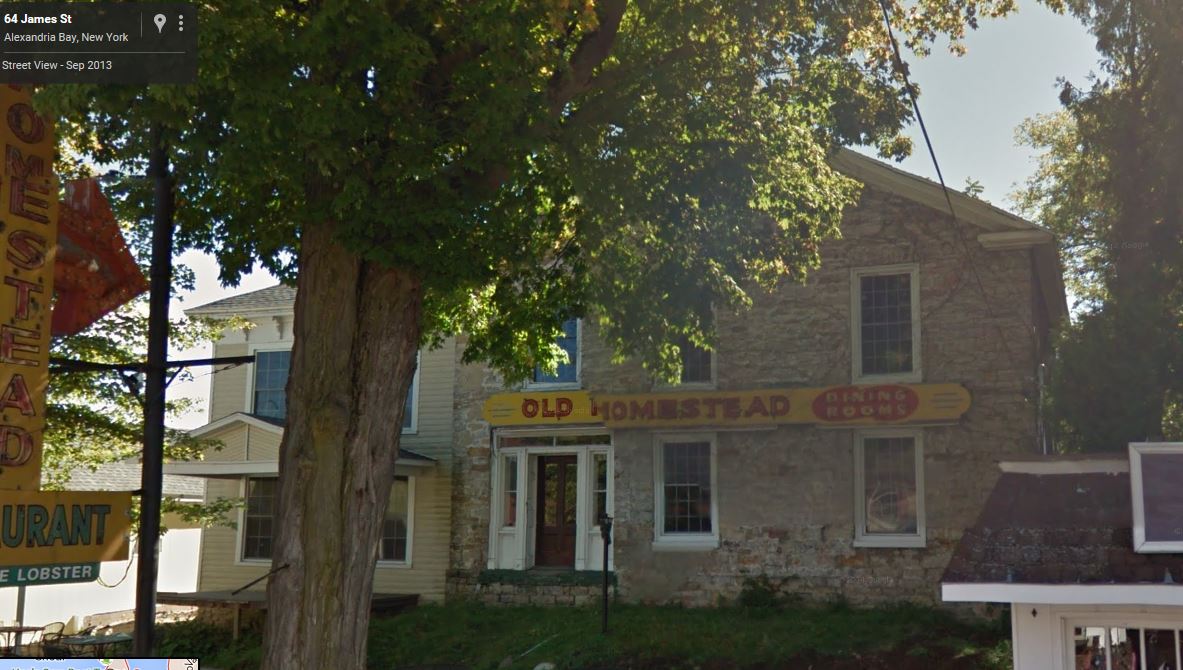
Azariah Walton, one of the historic figures of Jefferson County, played an important part in the development of the village of Alexandria Bay and the Thousand Islands region of the St. Lawrence river. At one time he and Chesterfield Pearsons jointly owned all of the Thousand Islands on the American side of the St. Lawrence. From 1828 he was for 19 years collector of customs at Alexandria Bay, where he was for many years a prosperous merchant.
There he died June 10 1855 aged nearly 71 owner and occupant of this stone house, which the Centennial Historv of Jefferson County published in 1905 says he built about 1830 but which was probably not started before 1835. In the town of Chesterfield, New Hampshire, Azariah Walton was born August 20 1784. He learned the blacksmith's trade, became a skilled machinist and prior to 1812 came to Brownville, where he superintended the construction of the cotton mills. From Brownville he removed to Theresa in 1824 and engaged in merchandizing until 1828 when he was appointed collector of customs at Alexandria Bay. Several monuments have there existed to his memory, one being a street named for him and another having been a hotel.
On May 29 1810 when he was 25 he was married to Mary Gilson who was then 18 having been born November 15 1791. It was on March 10 1835 that he bought 9.6 acres of land beginning on the southeast side of James Street, Alexandria Bay, for $244.05. This purchase was made from Francis Depau, New York City merchant, and wife, Silvie De Grasse Depau through their attorney, Patrick Somerville Stewart. It was for Depau, heavy Jefferson County landowner, that Depauville was named. This native limestone house, the only old one in Alexandria Bay, is on the southeast side of James Street, and was probably built by Walton shortly after he purchased the land from the Depaus in 1835.
Azariah Walton executed his will May 25 1855 and gave his widow Mary this house, its contents, a cow and $200 a year, but on September 1 1858 Mary sold the house and 1.95 acres of land to Rosina Rowe and on October 31 1860 Rosina sold the place to Augustus Whitlock of New York City. The executors of Whitlock disposed of it to Jerome B "Estes November 1 1866 a few months after his son, Captain Charles J Estes, now 81 was born. Captain Estes, well known boatbuilder, proprietor of the tour boat "C J E," former caretaker of the Nathan Strauss summer home on Cherry island and commander of the Strauss yacht Sissilina, still resides in Alexandria Bay.
Jerome B Estes and wife, Eliza, kept this house only until July 5 1867 when they sold it to Chauncey Westcott, one of Alexandria Bay's earliest prominent residents. Westcott, whose wife was Emeline Everson, died November 4 1886 and under his will recorded January 15 1887 he gave his daughter, Mrs Eveline F Woodworth, his homestead property on James Street. Sometime after the death of her first husband, Charles Woodworth, Eveline married John P Roton, a cigar merchant and onetime Alexandria Bay police chief. On May 10 1910 she conveyed this property to Charles I Everson and four days later Everson and wife Minnie, conveyed it back to her and Roton jointly. Following her death the property went to her husband, Roton, and September 2 1937 the Northern New York Trust company as his executor sold it to John J and Kittie Bavette Dolan of Bridgeport, Connecticut. Mrs Dolan was a niece of Roton, who died February 8,1935. His wife had died ten years before.
On September 19 1947 Mrs Dolan, then of Fairfield, Connecticut, sold this fine old stone house with its beautiful front entrance and the more recently constructed frame wing to John G Spathis, 19 James street,-who conducts a restaurant next door to the stone house.
Tradition has it that the native limestone upright of this house, located a few miles outside of the village of Brownville on the Perch River road, was built by George I Knight about 1834. There is a possibility, however, that it was constructed before that, for the deeds state that the slightly more than 268 acres, of which this farm was a part, was purchased by Israel Knight from James Donatien LeRay de Chaumont January 9 1809 for $1,670.
Israel Knight, one of the early settlers of the town of Brownville, was a native of Bucks county, Pennsylvania, whence had come General Jacob Brown, founder and promoter of Brownville. Knight had known Brown in Pennsylvania and when the latter purchased a part of the Chassanis tract he undoubtedly induced Knight to invest in some of the land.
A later deed of March 18 1836 conveying about 200 acres of the parcel states that Isaac Knight had acquired title from Israel Knight by heirship. This conveyance of March 18 1836 runs from Isaac and Juliana Maria Knight of Baltimore to George I Knight of the town of Brownville and relates that George I Knight was already in actual possession of the property.
George I Knight undoubtedly became a man of substance, for his will executed September 16 1869 bequeathed, among other things, $3,000 of government bonds to his widow, Mrs Esther M D Knight, and to his son, Jacob B Knight, a gold repeater watch which the testator had bought from his Uncle Tyson, in 1810.
On September 2 1872 George I Knight died, but on March 5 1866 he and
his wife had sold this house and the (illegible) acres which now consitutes
the farm to William and Martha Closson for $8,830.90. Mrs Closson inherited
the place from her husband and removed to this (illegible) of the farm
October 3 1891 to Myron Buckminster of the town of Brownville for $5,706.12.
Mr Buckminster also belonged to one of the town of Brownville's earliest families, his father, Richard Buckminster, a native of Plattsburgh, where he was born in 1800 having come to Watertown in 1816 settling in Brownville three years later. Richard Buckminster, after settling in Brownville, married Mary Avery, whose father, Frederick Averv, had located in that township in 1802.
Besides Myron, Frederick Avery Buckminster was one of the six children of Richard and Mary Avery Buckminster. Frederick Avery Buckminster served in Company I, Tenth New York Heavy Artillery, in the Civil war and died July 13 1870 at the age of 29. Richard Buckminster, father of the former, died May 29 1883. That he was a man of prominence in the town is indicated by the fact that in 1840 he was master of Brownville Lodge, No. 378 F & A M
The Buckminster ownership in this property goes back a period of nearly 57 years, for after Myron Buckminster's possession of it Frederick B and Lottie A Buckminster acquired title to it and on February 19 1912 conveyed it to Lewis J Buckminster, the present owner.
At the time of that conveyance Mr and Mrs Fred Buckminster were residents of this city. There are six rooms in the stone portion of the old house, to which has been added a large modern wing and long verandah of frame construction. There has been much other alteration which has changed the original appearance of the house, one of several built of native limestone along that road
Sylvester Gilbert, for whom this beautiful old Georgian stone house was built about 1821-1822 on the west side of State Street near the corner of Ford Street, Ogdensburg, was one of the. most prominent early residents of that community.
Early in American colonial history bis progenitors, of English stock, settled in Hartford, Connecticut, but be was born at Otego, Otsego county, NY, September 24 1767 and about 1810 located in Ogdensburg, setting himself up in business as a hatter. Shortly after the War of 1812 he engaged in business with Judge James Averell and together on December 29 1817 they purchased al the corner of State and Ford Streets a parcel of land, upon a portion of which Ibis house stands.
The purchase was made from Nathan Ford, land agent for Samuel Ogden, founder of Ogdensburg, and April 14 1821 Averell and wife, Lydia, quitclaimed their interest to Gilbert who probably started construction of the stone house shortly after that. Later on December 9 1836 Gilbert acquired from Harvey and Catherine Church an adjacent lot.
Only a few months before Gilbert bought the first parcel Ogdensburg had been incorporated a village April 5 1817. When St. John's Episcopal church was formed May 23 1820 Sylvester Gilbert was prominent in it and when it was incorporated May 23 1822 he was elected a vestryman. In 1835 he was chosen a Warden and served until his death October 25 1865.
A staunch Federalist he was. supervisor of the town of Oswegatchie 1823-1828 and January 2 1827 became assemblyman for one year, representing a district of St. Lawrence county. In 1835-0 he was president of Ogdensburg village, and in 1839 was a delegate to the Whig convention that nominated General William Henry Harrison for the presidency at Harrisburg, Pennsylvania.
In the exciting campaign that followed tlie women of the village gathered at the Gilbert bouse to embroider a Harrison banner, which Henry Van Rensselaer presented to the Tippecanoe club. Federalist, Silver Grey Whig, Sylvester Gilbert became a Democrat when the Republican parly was formed.